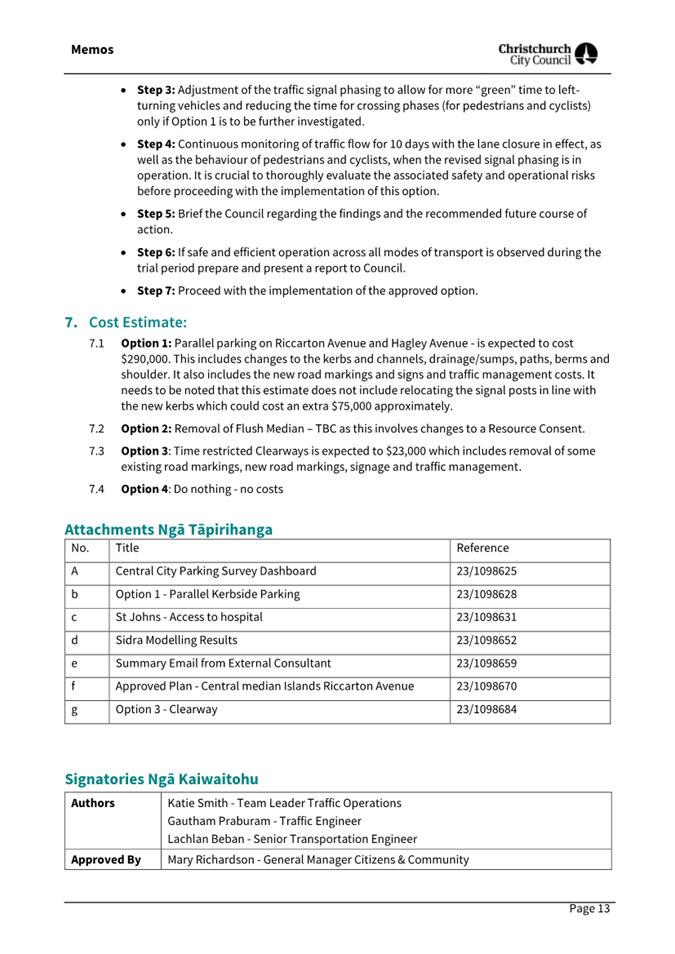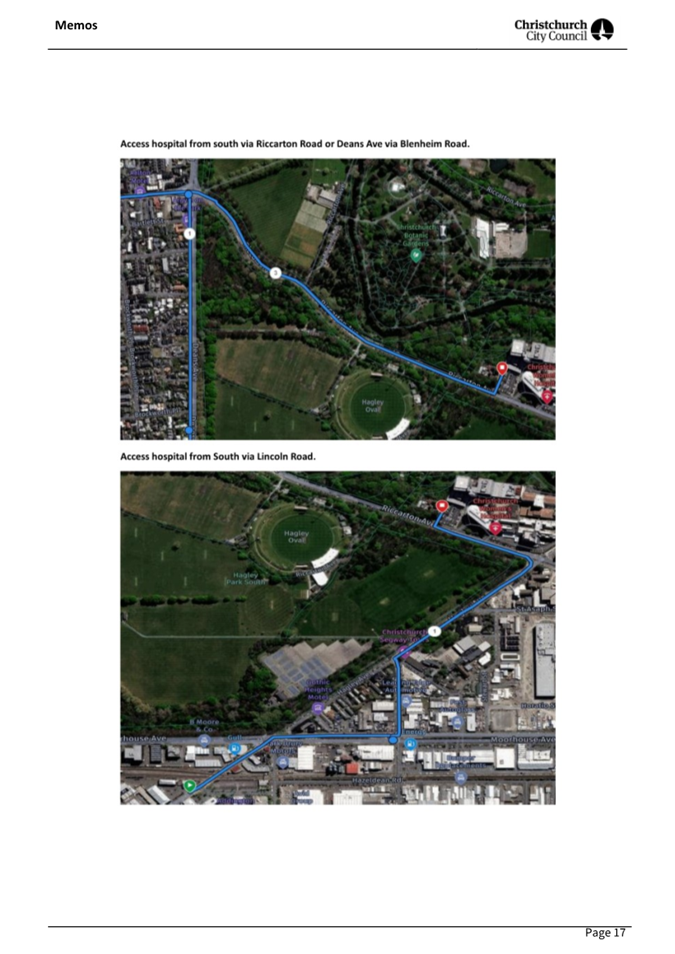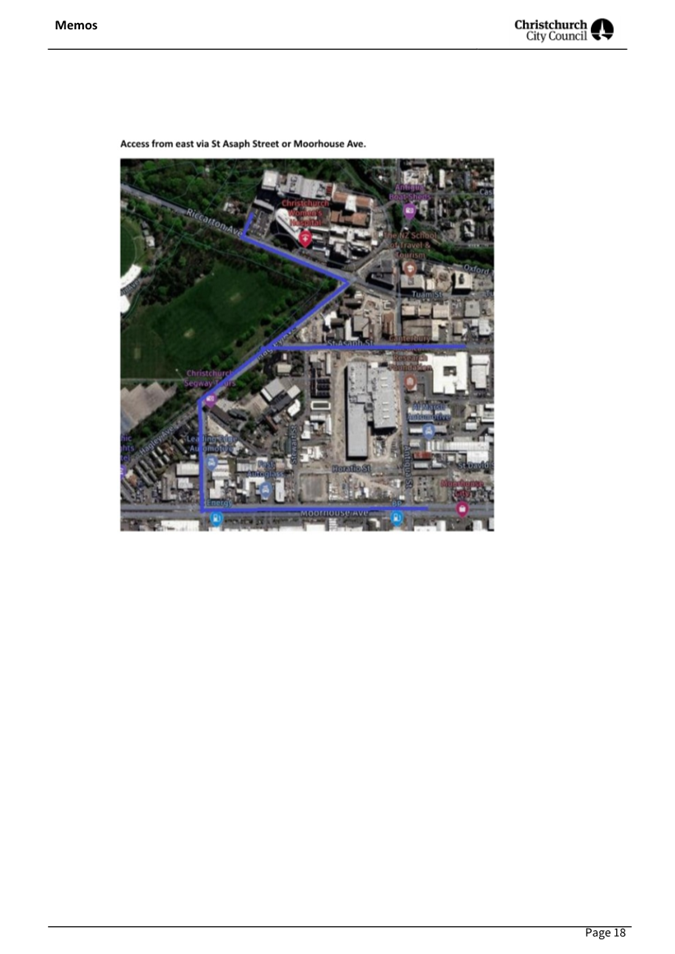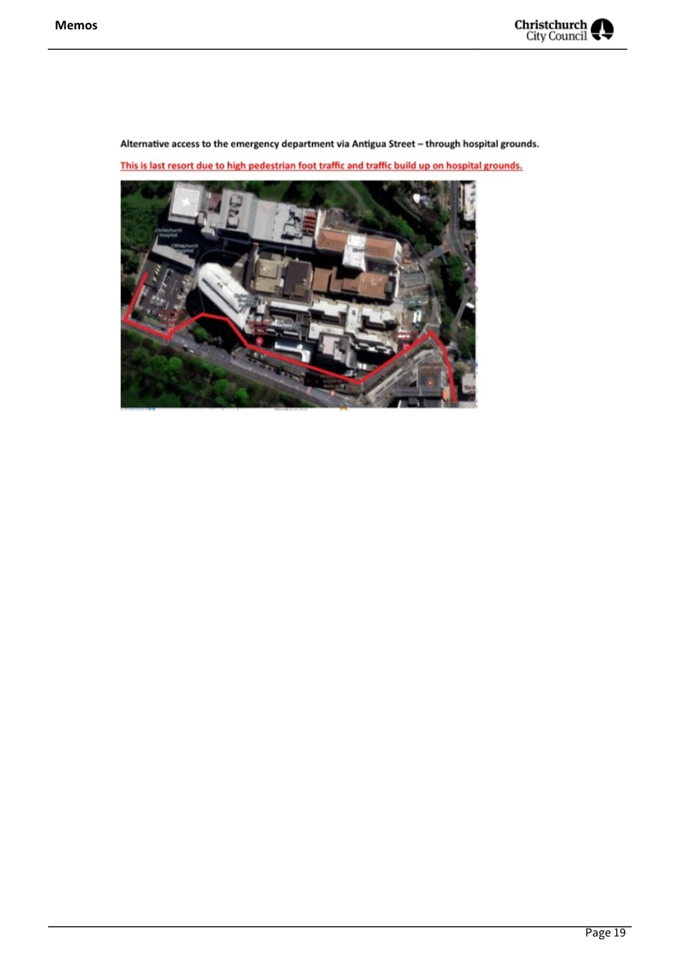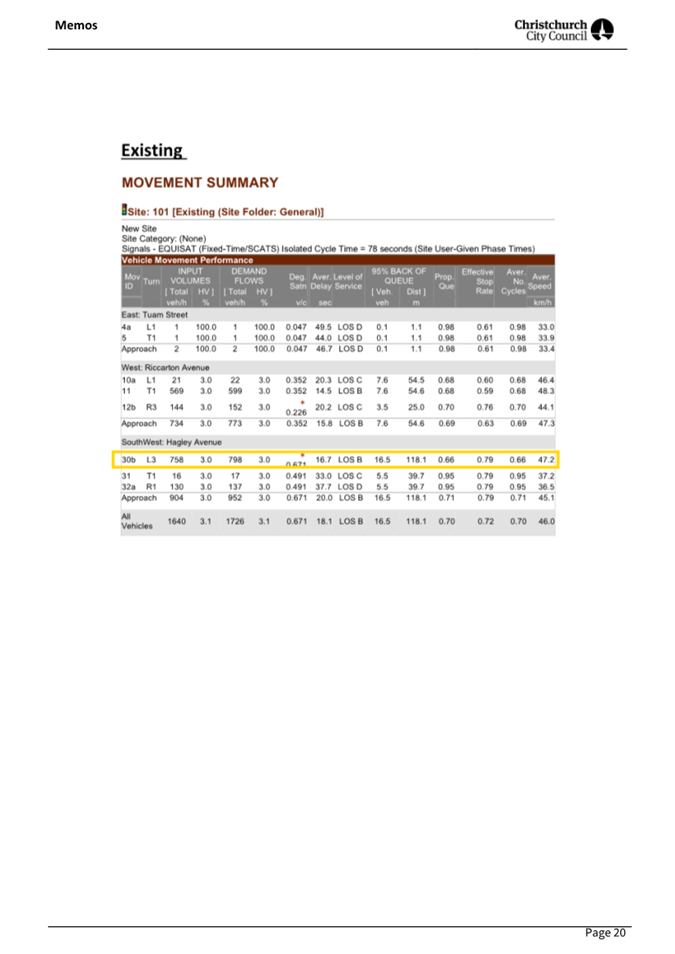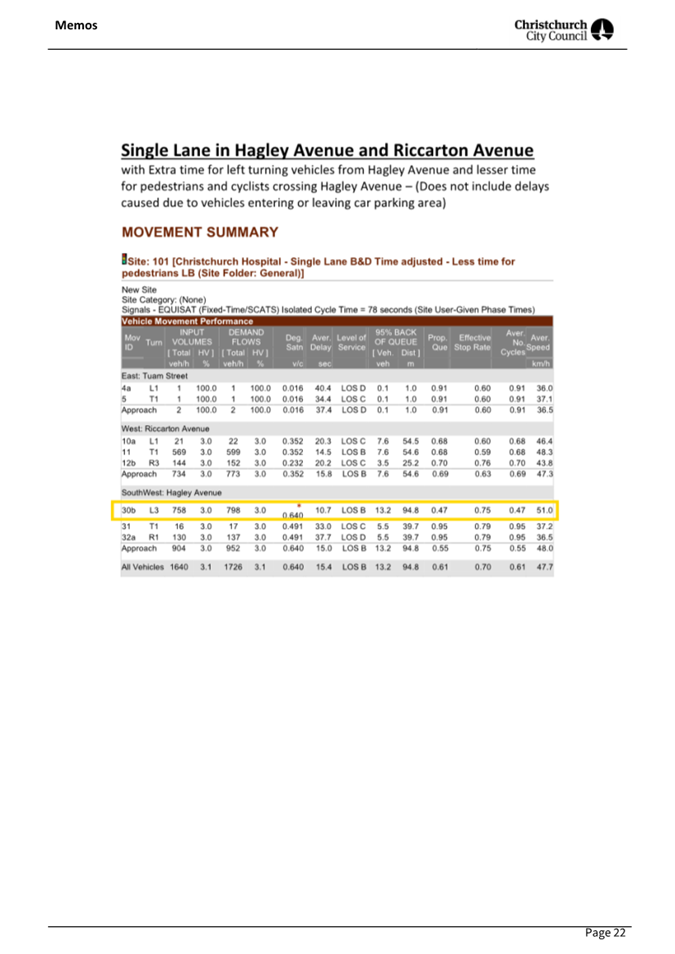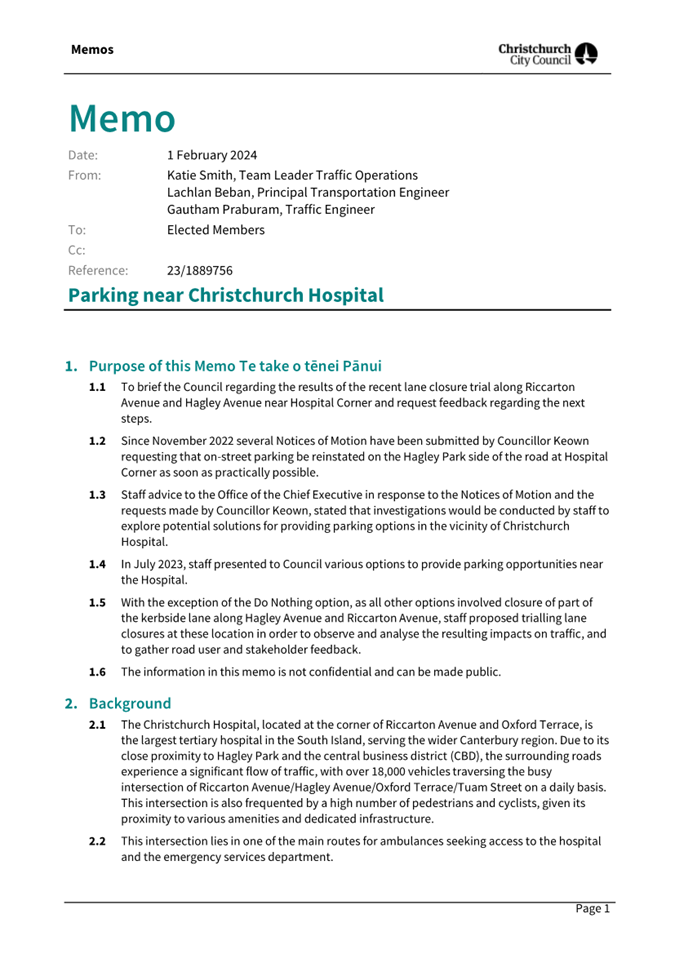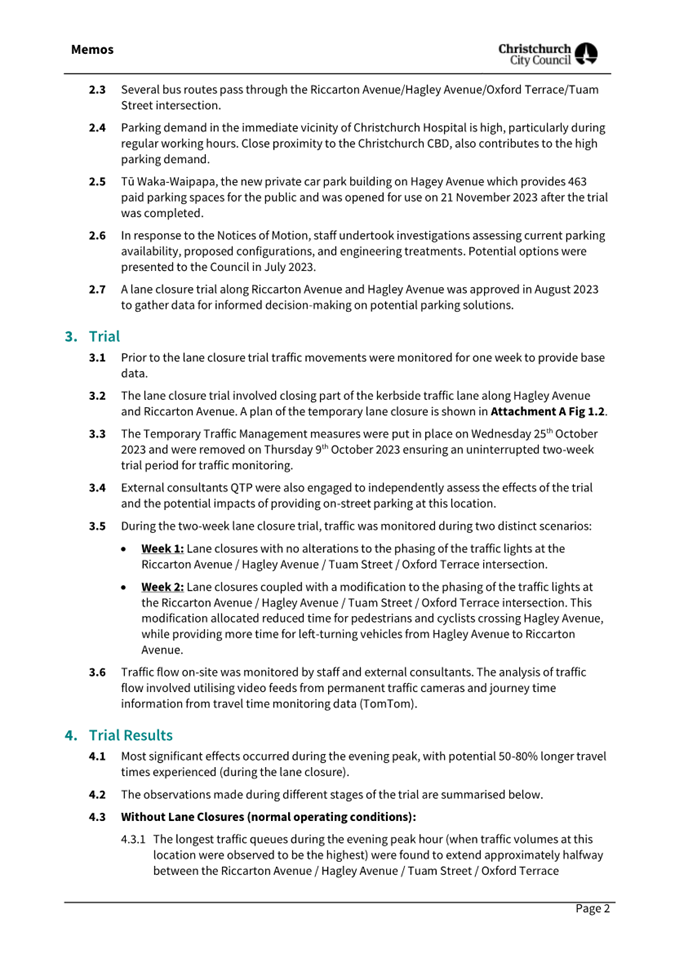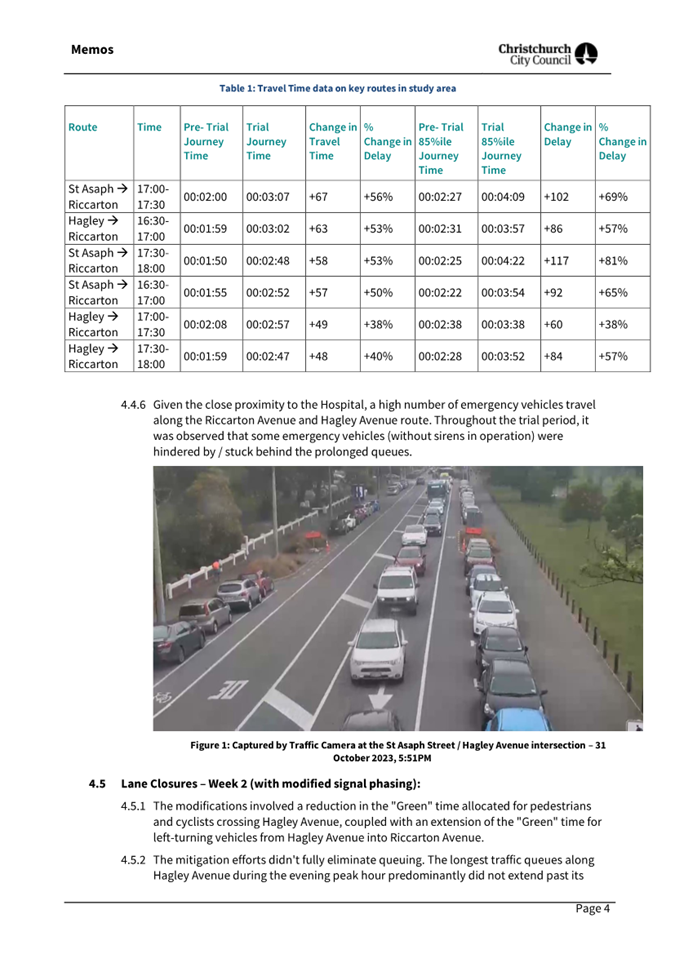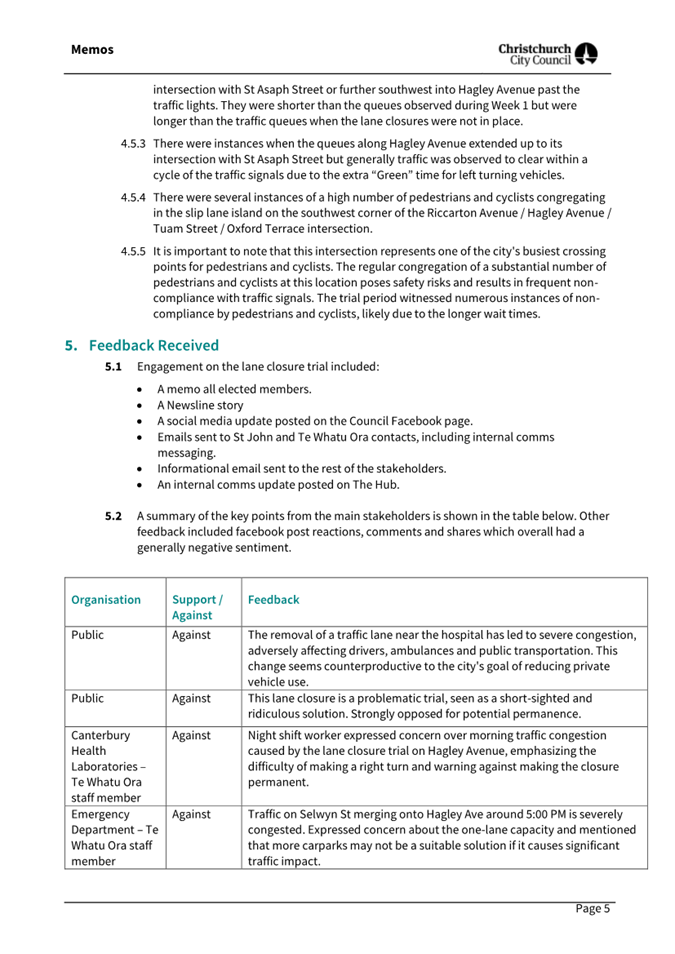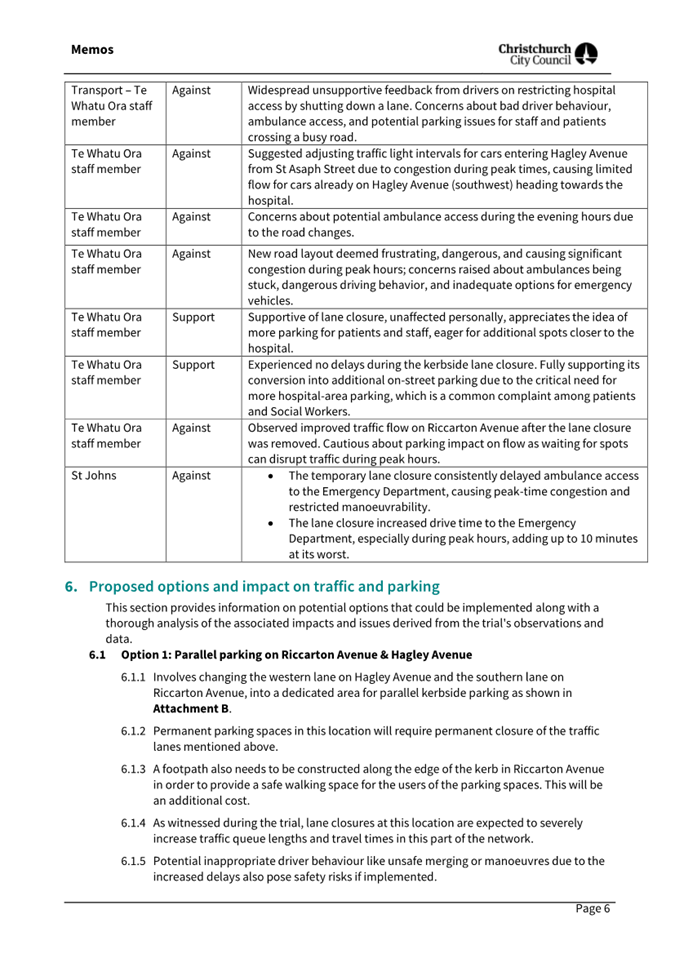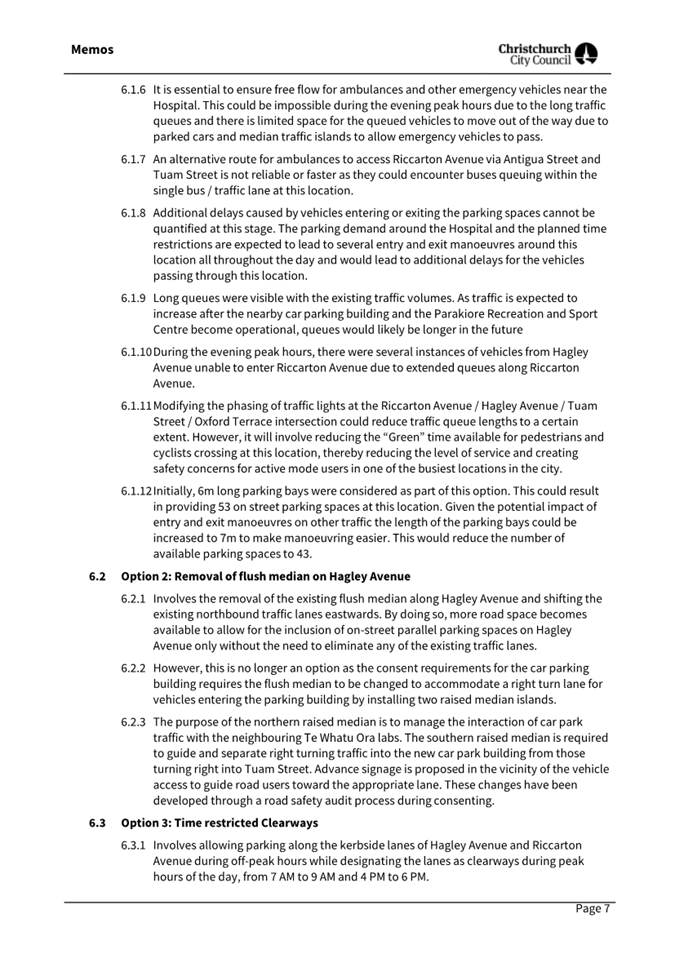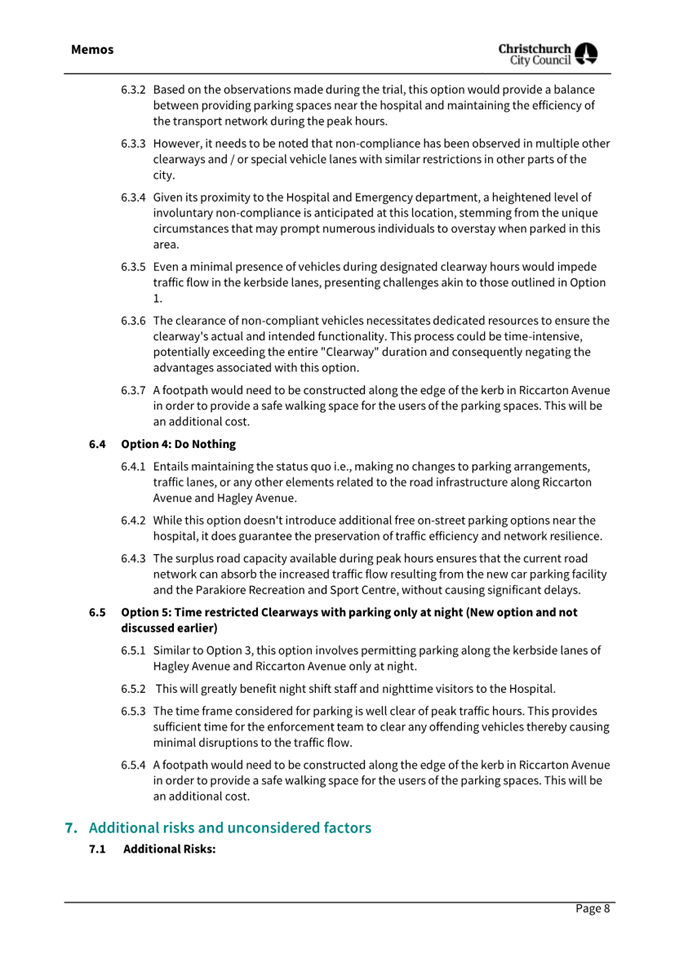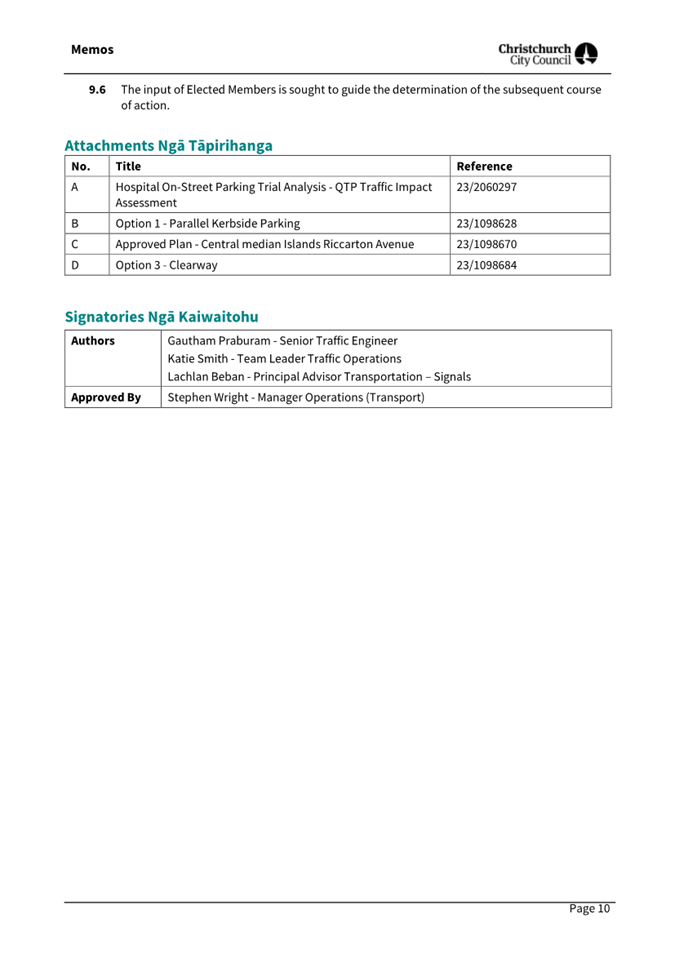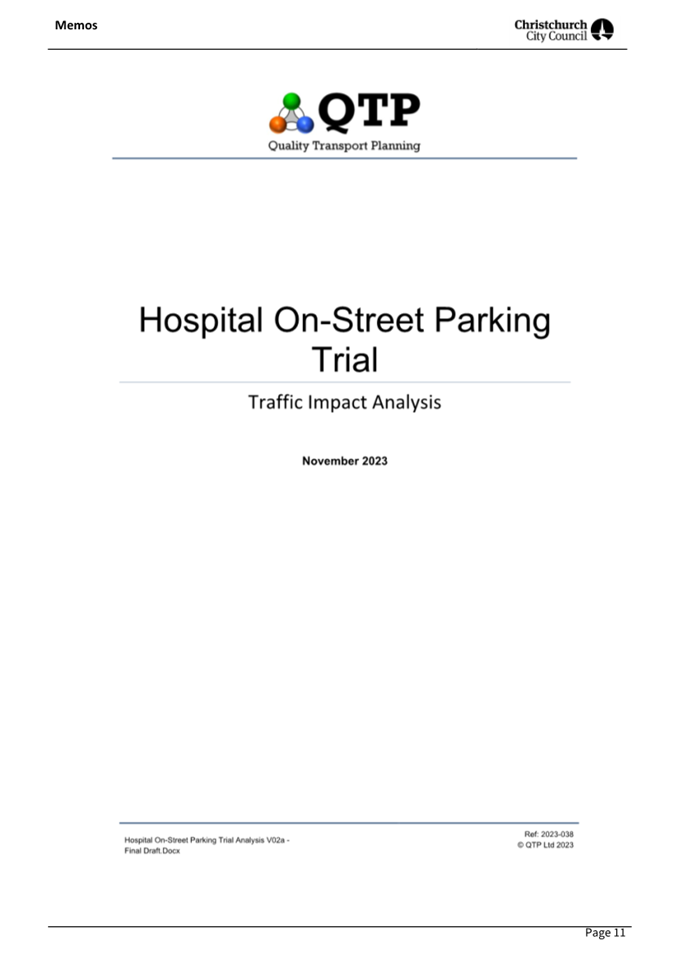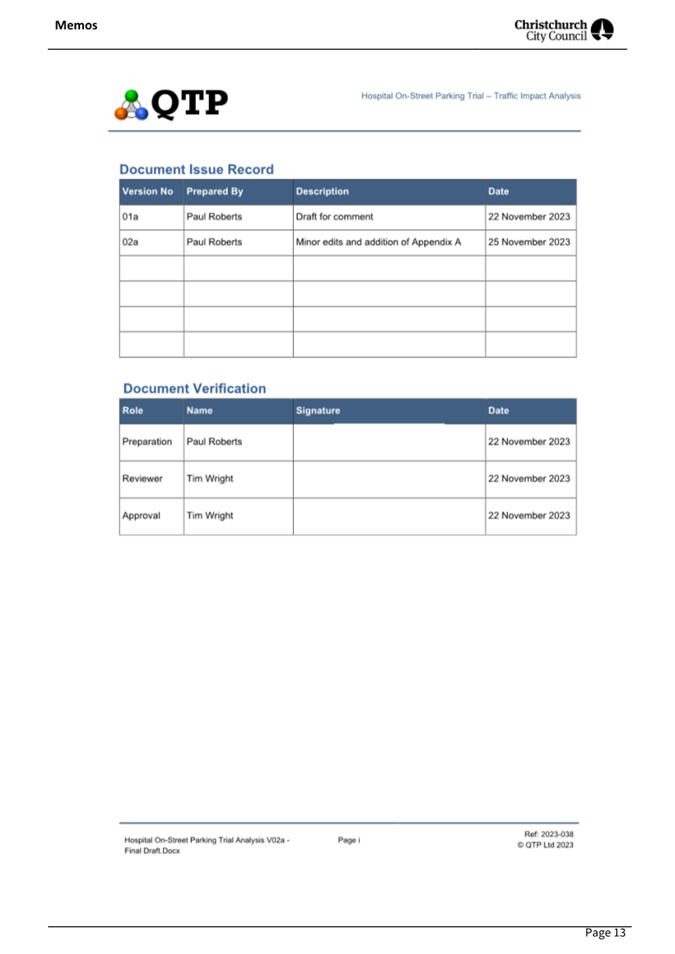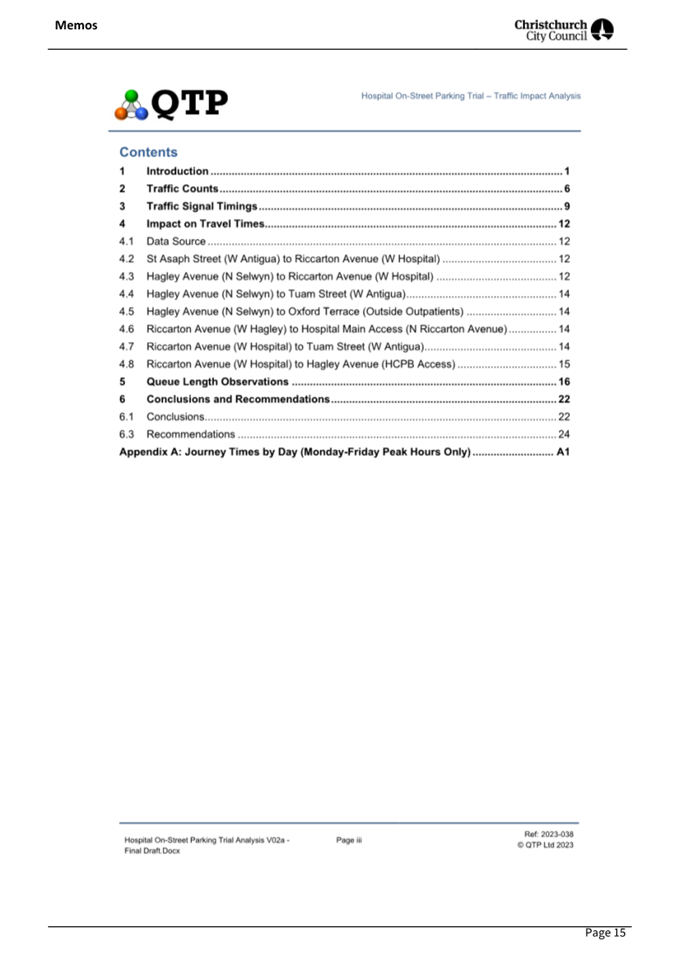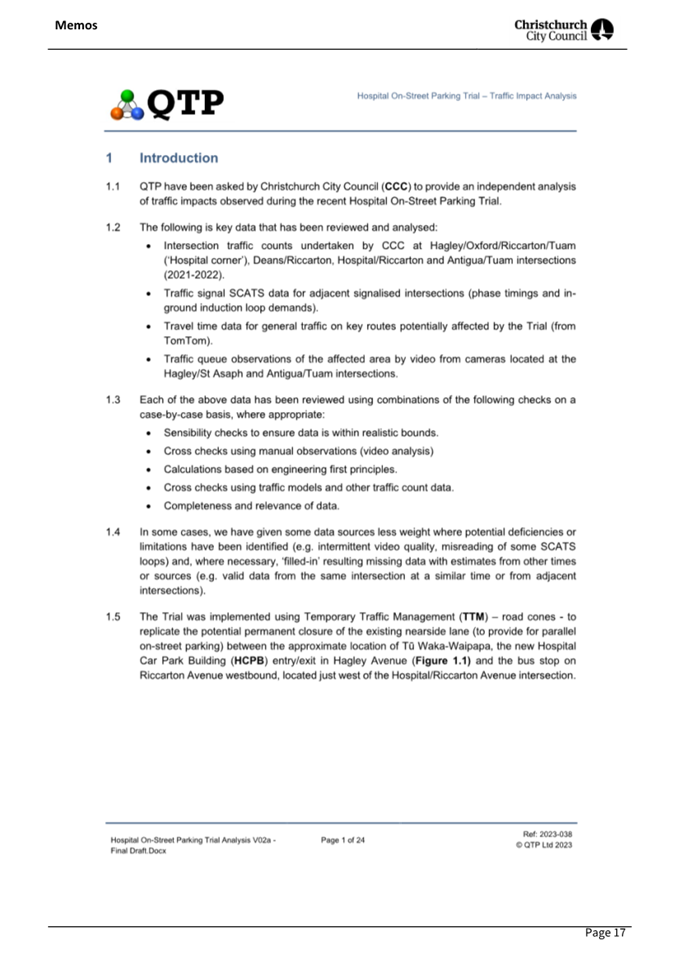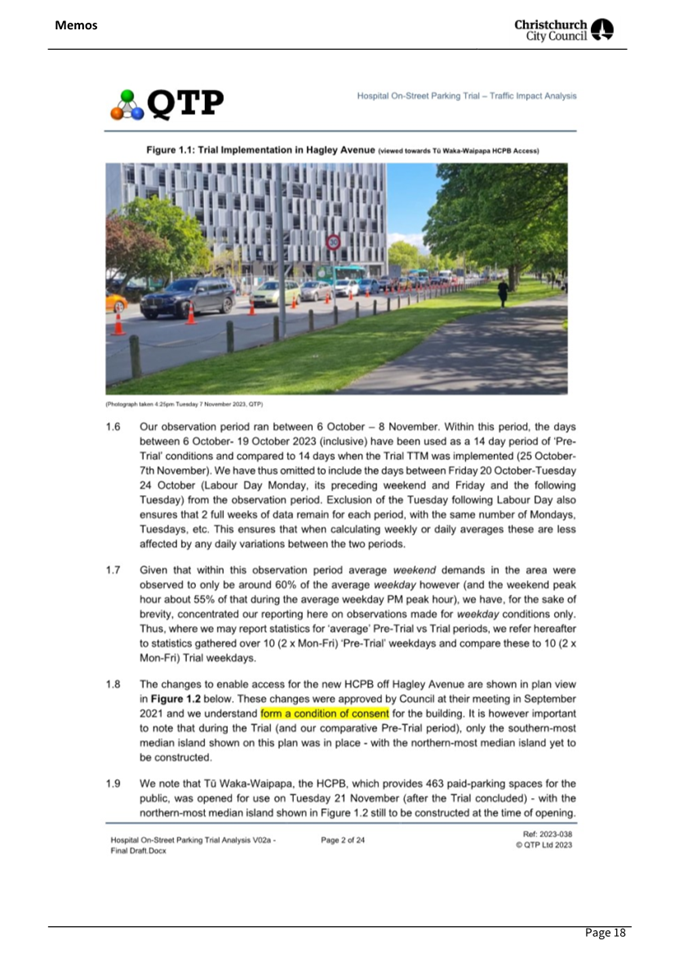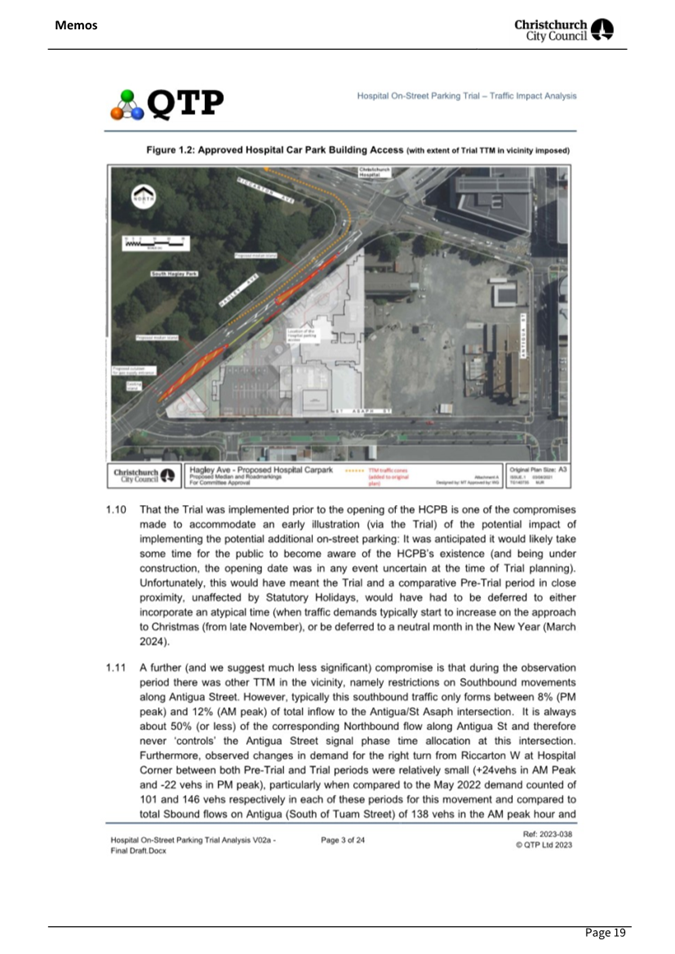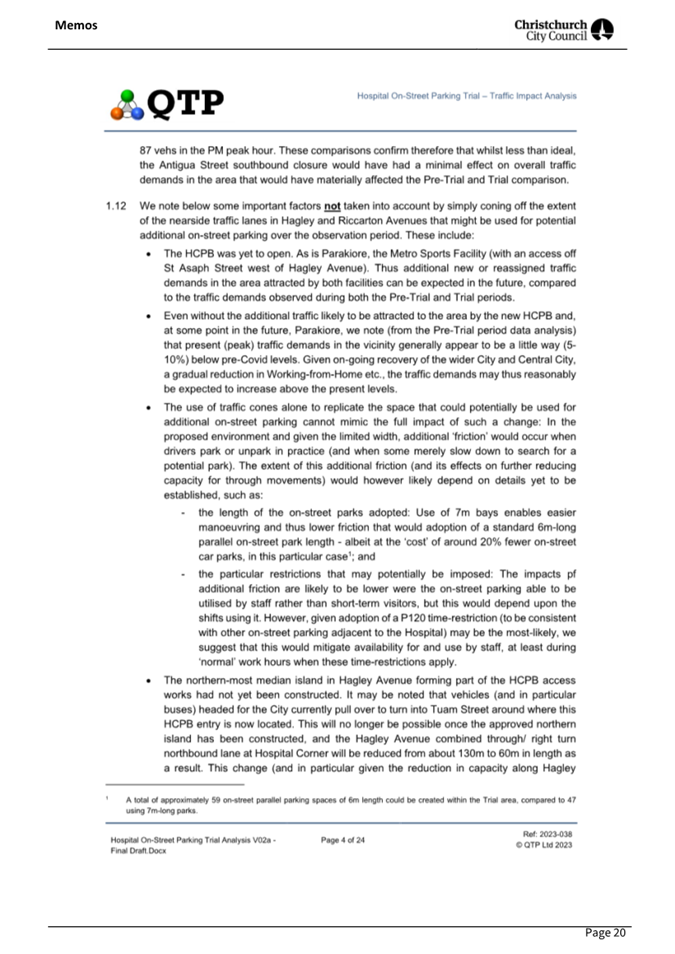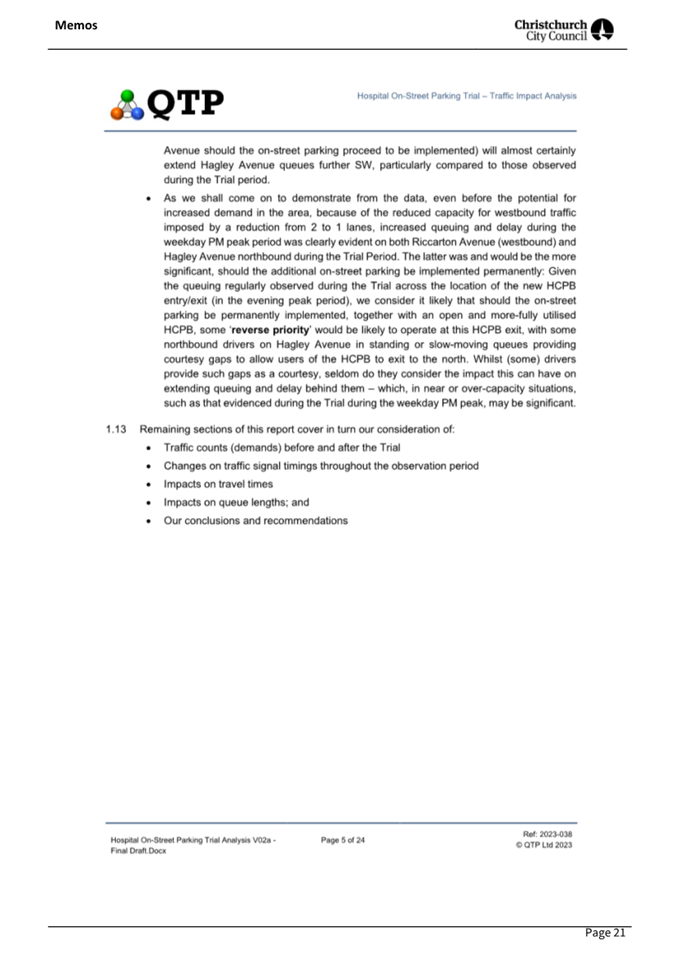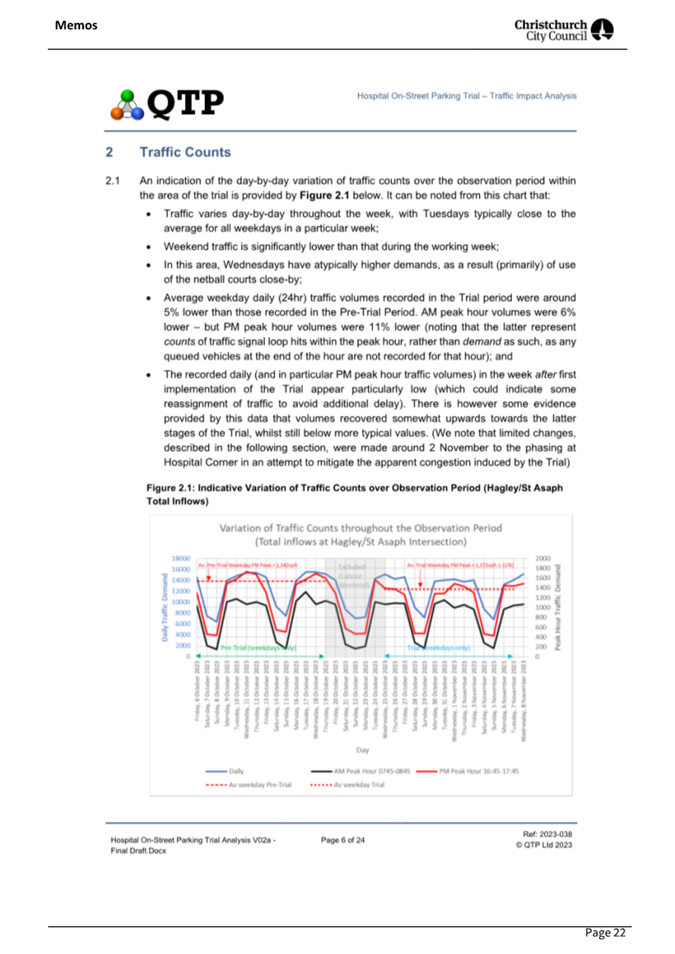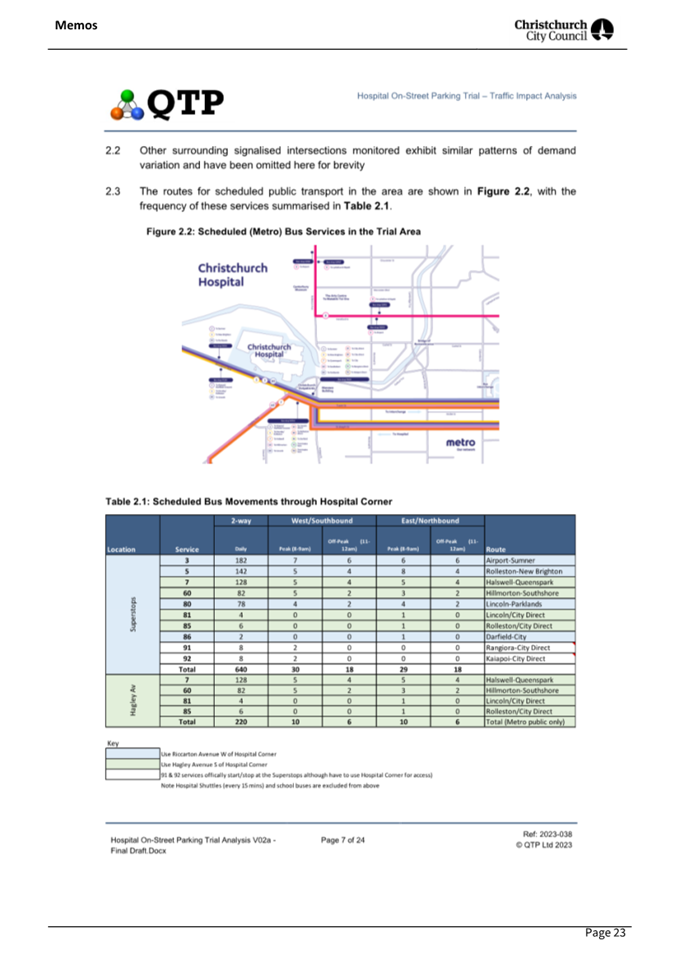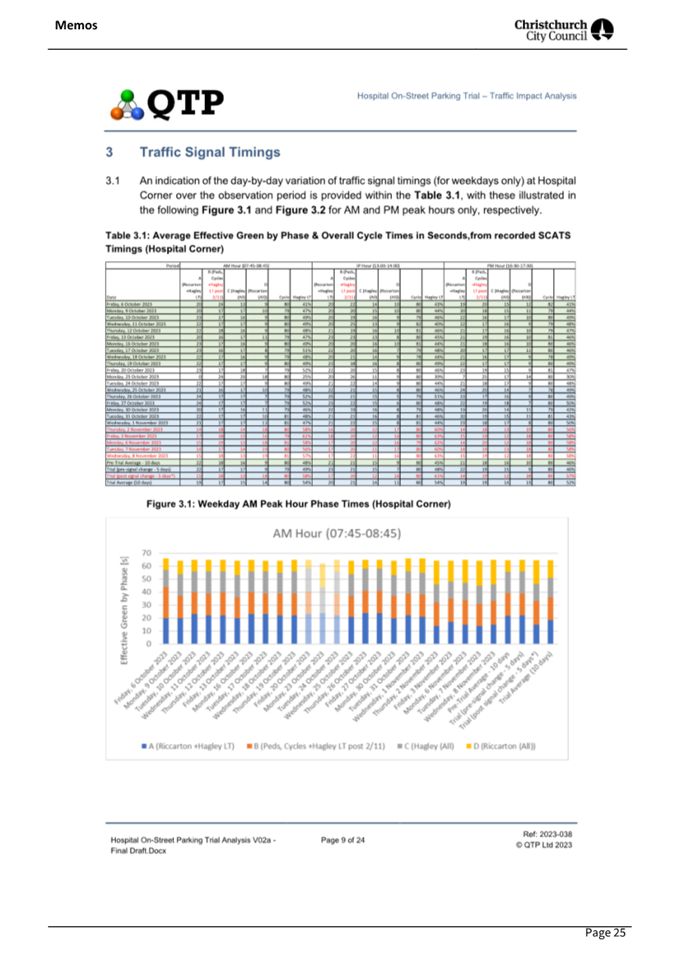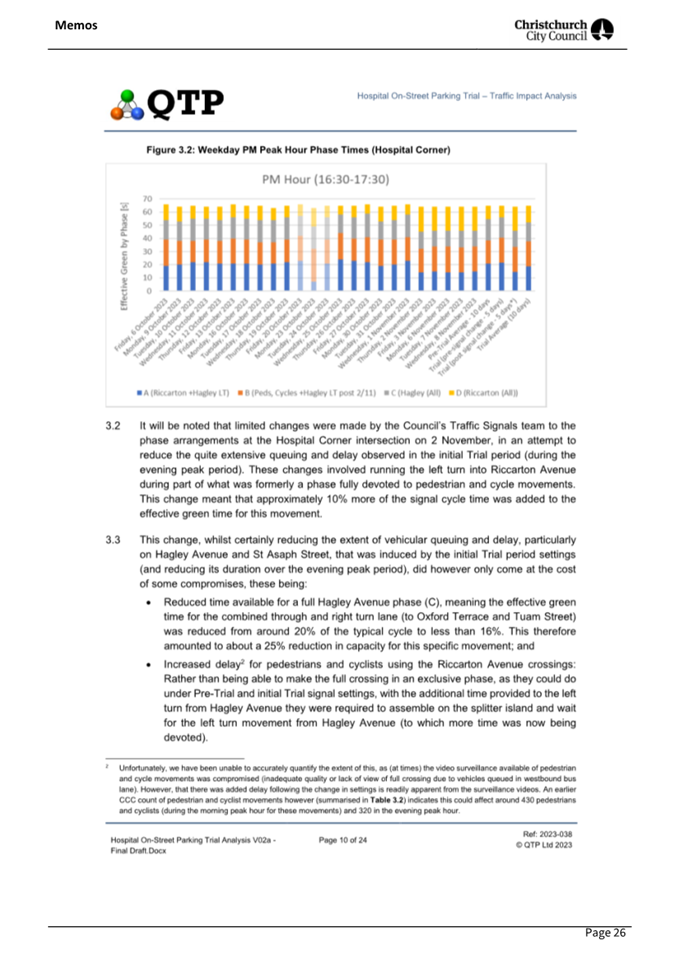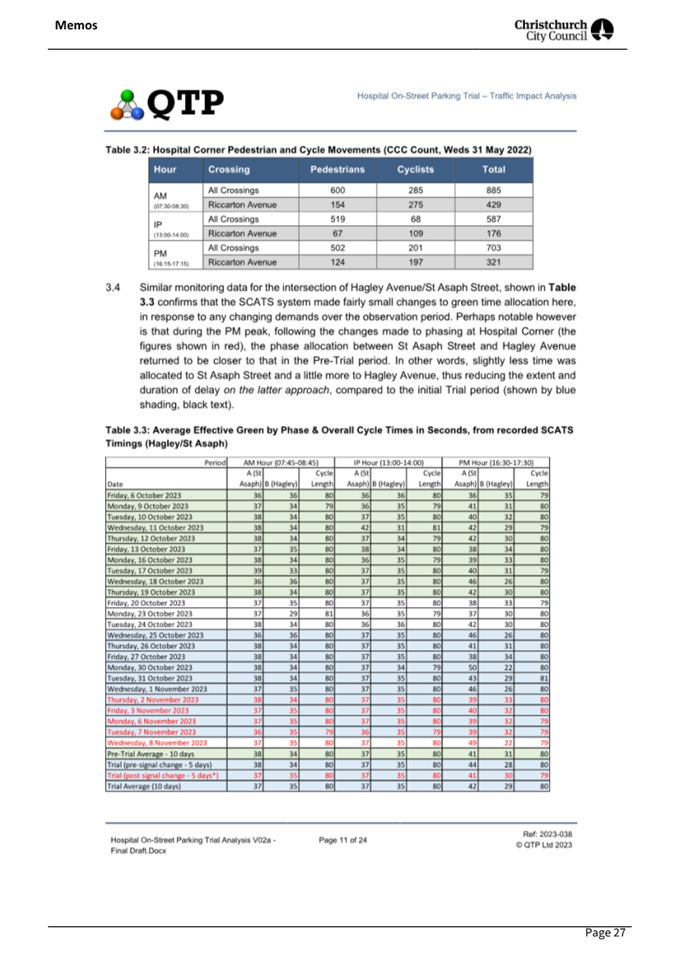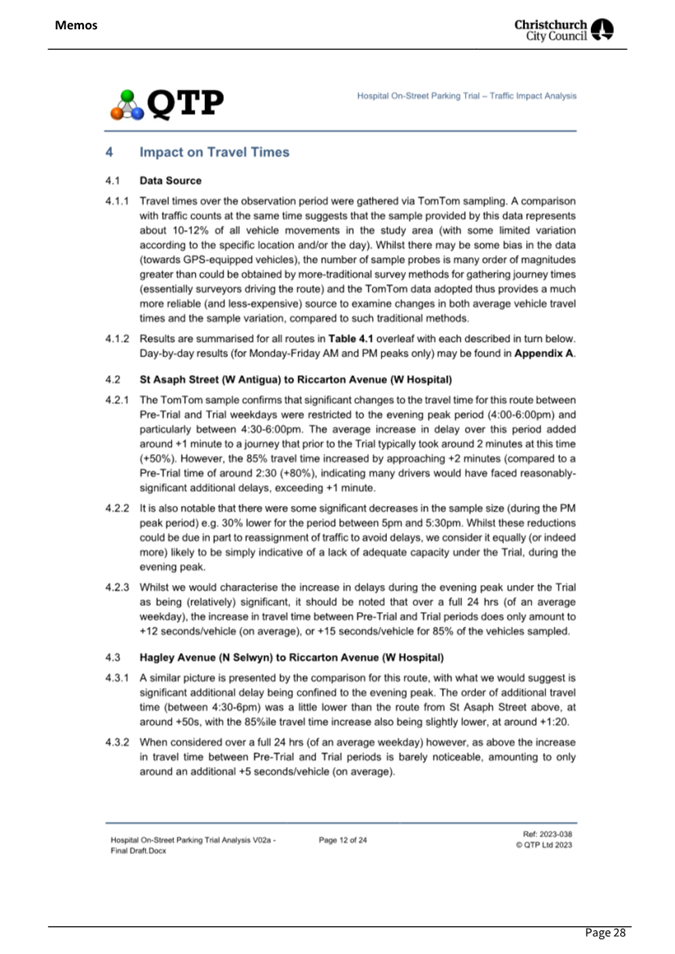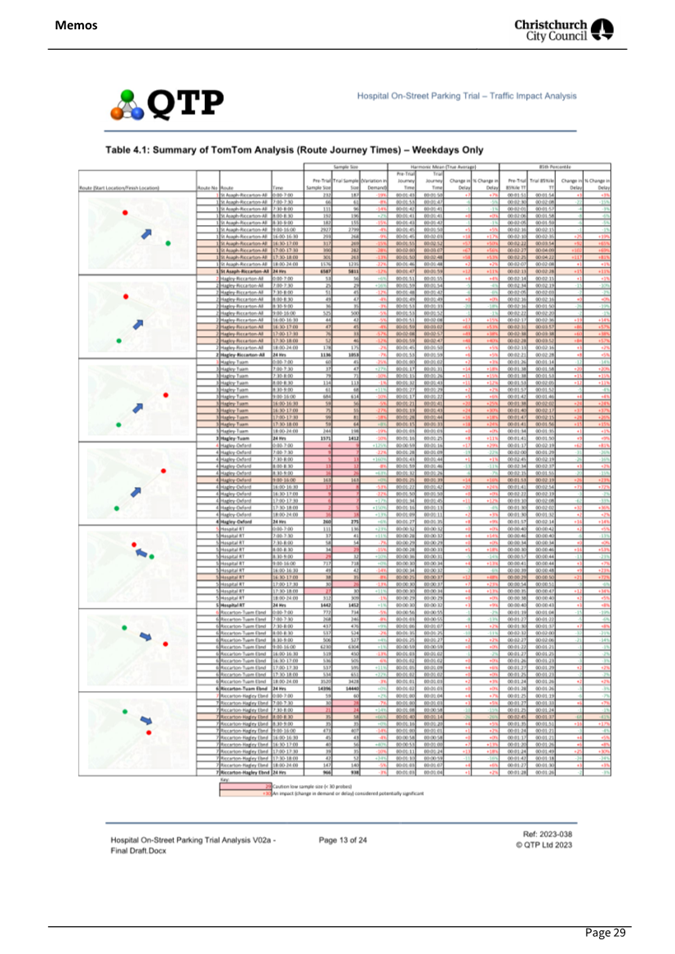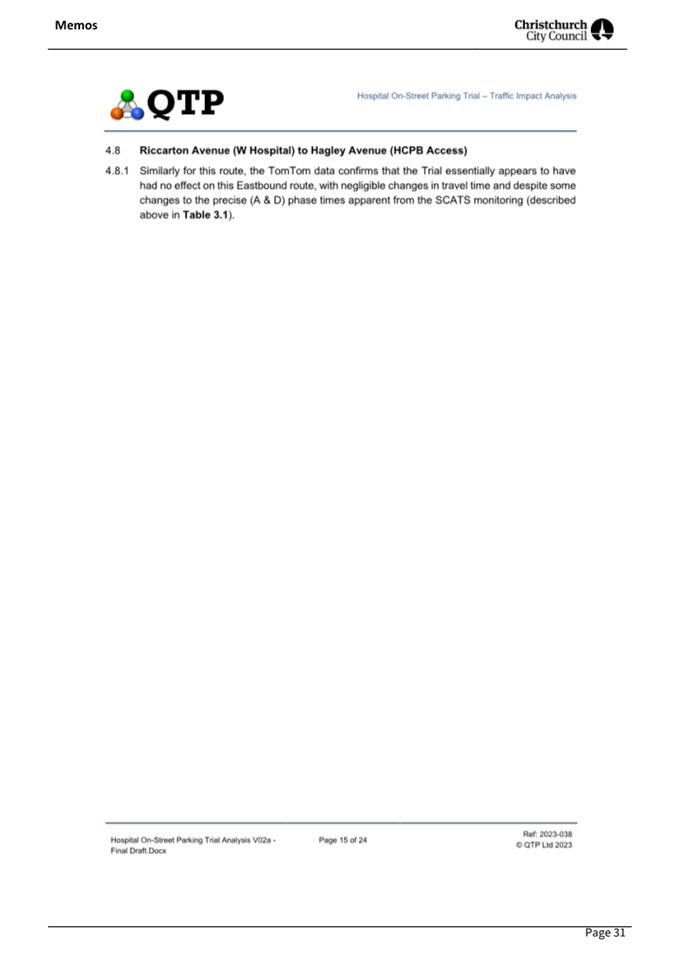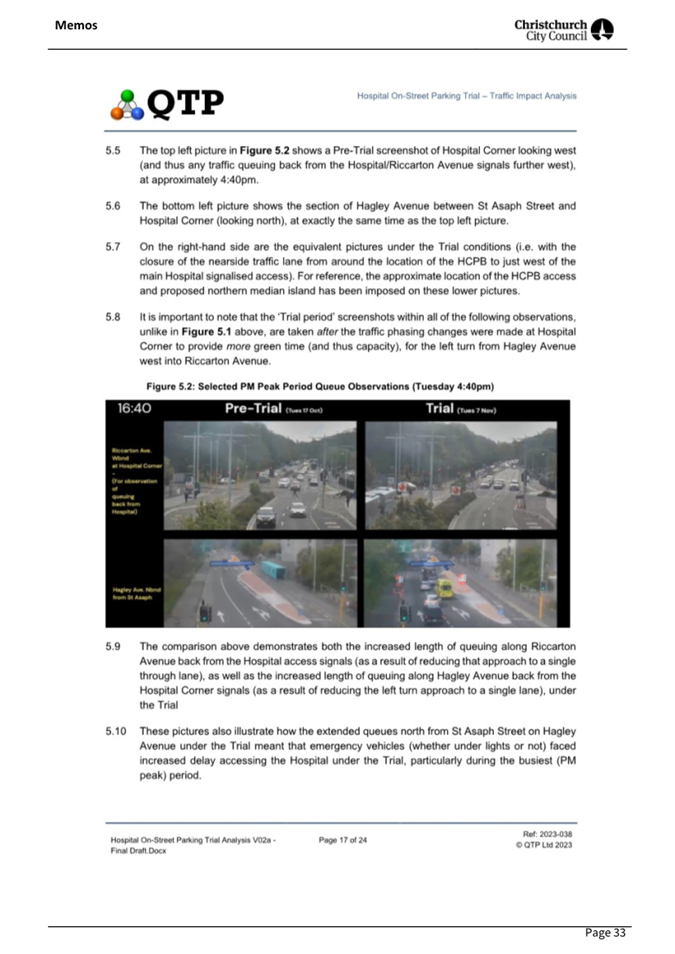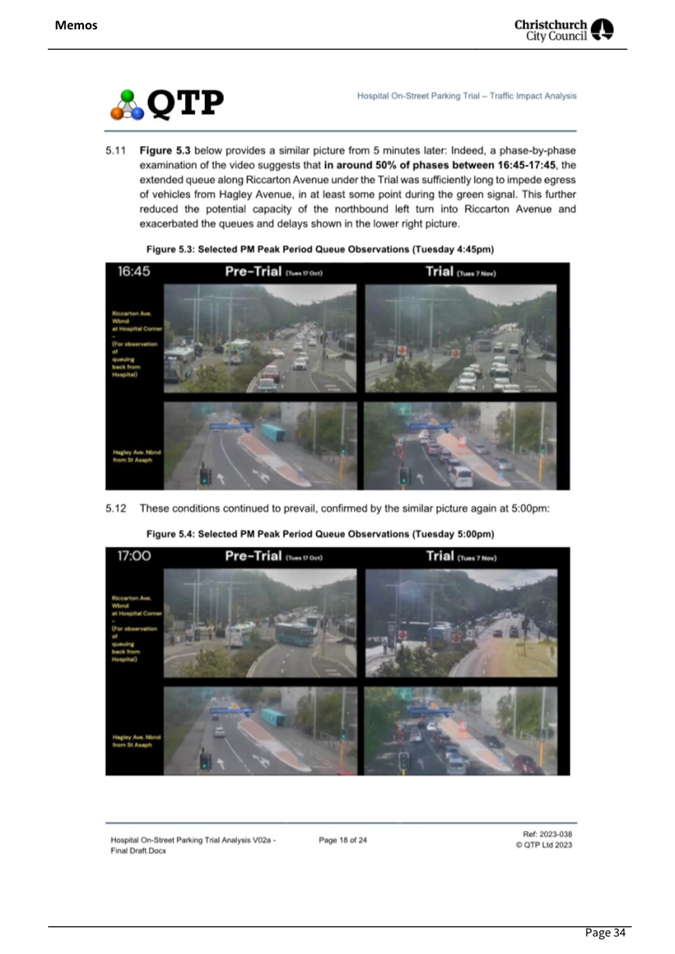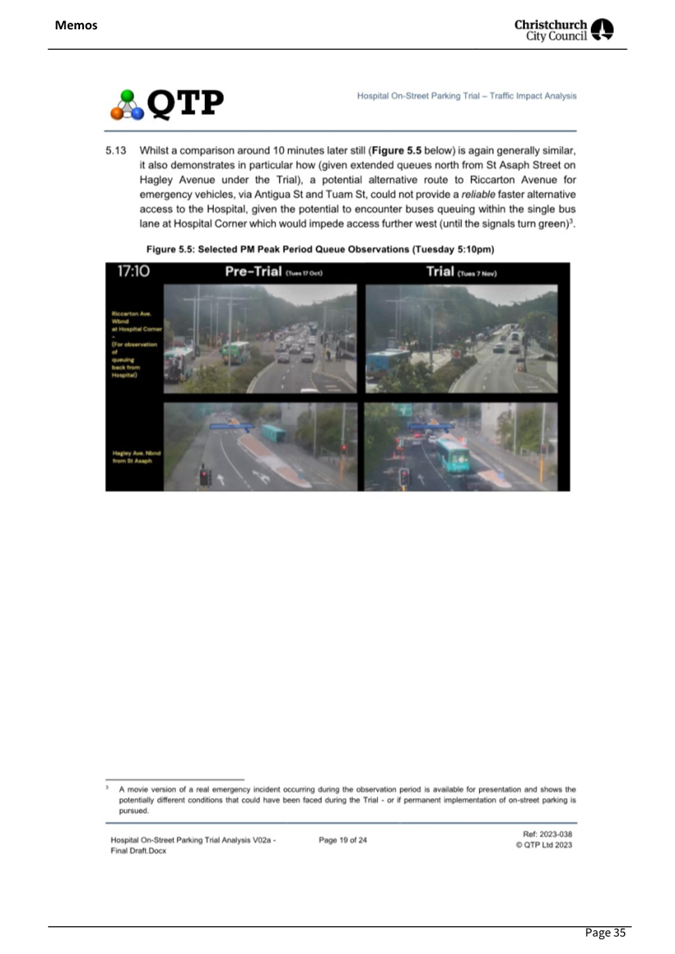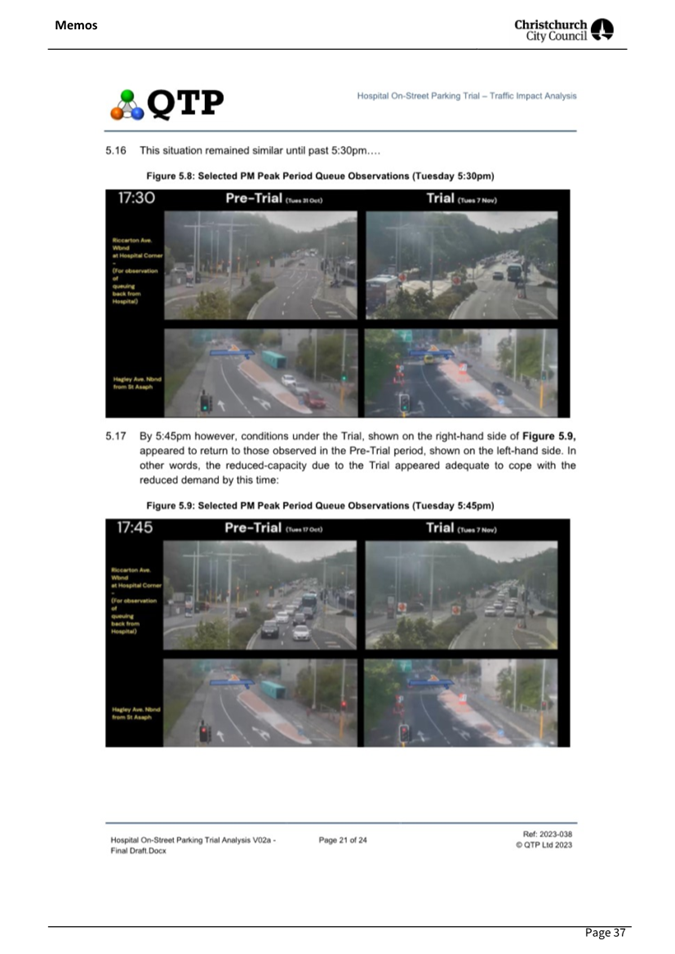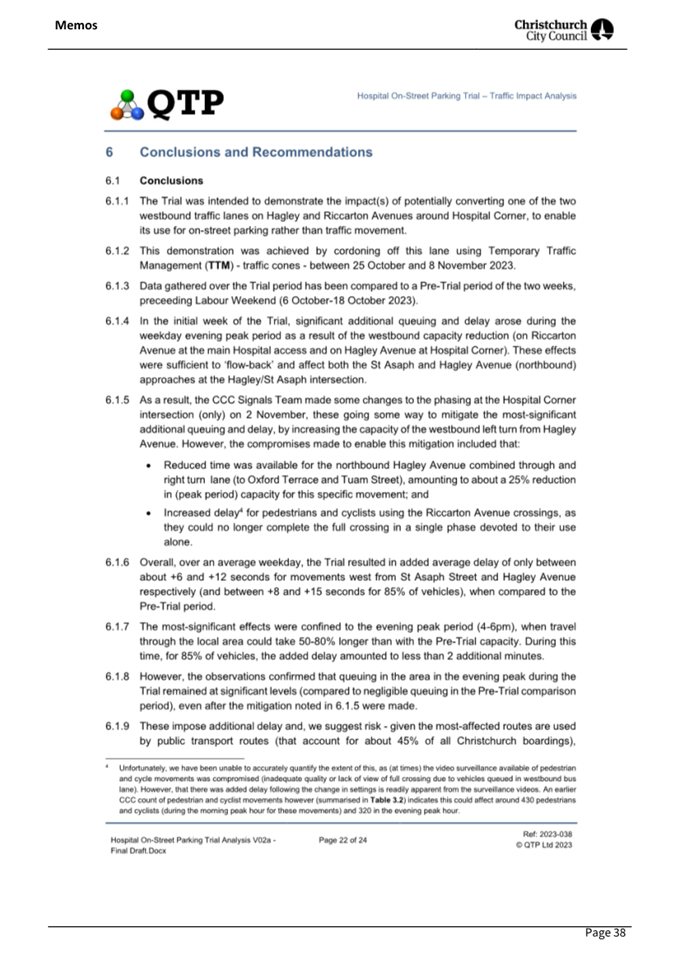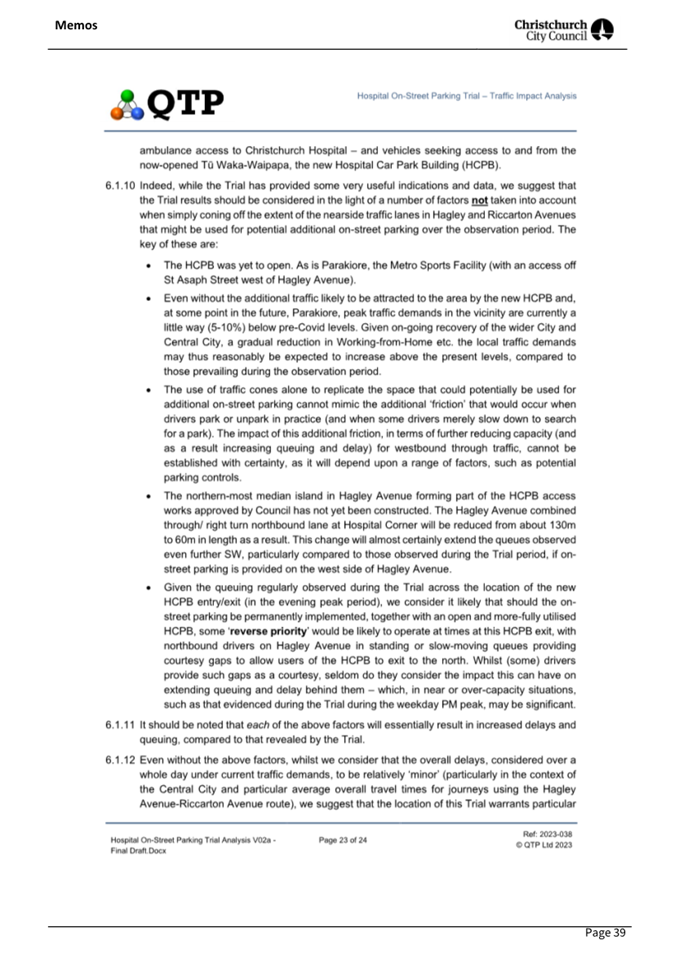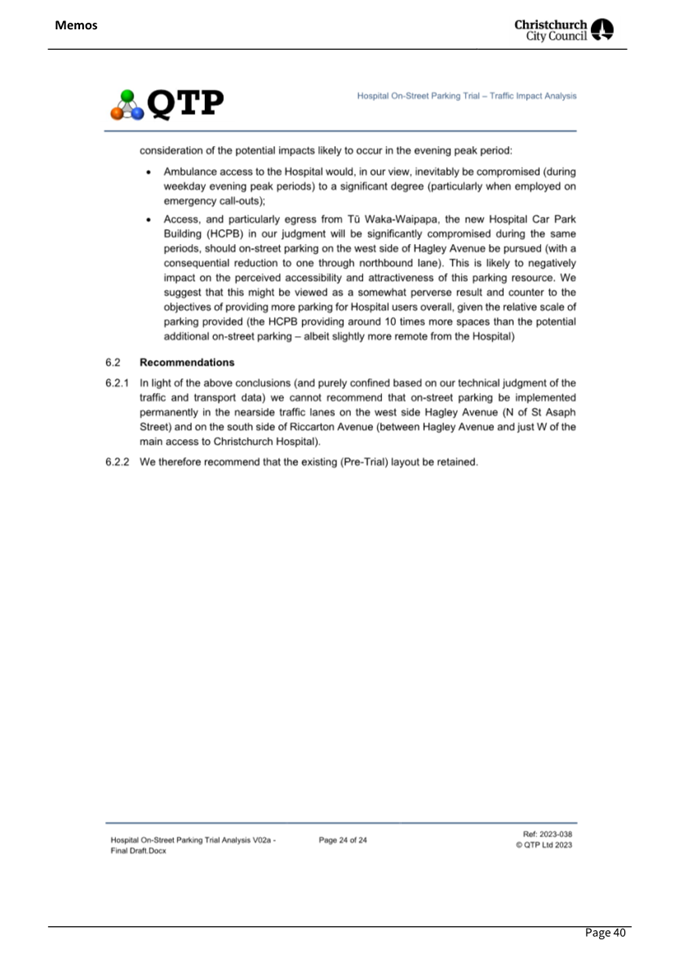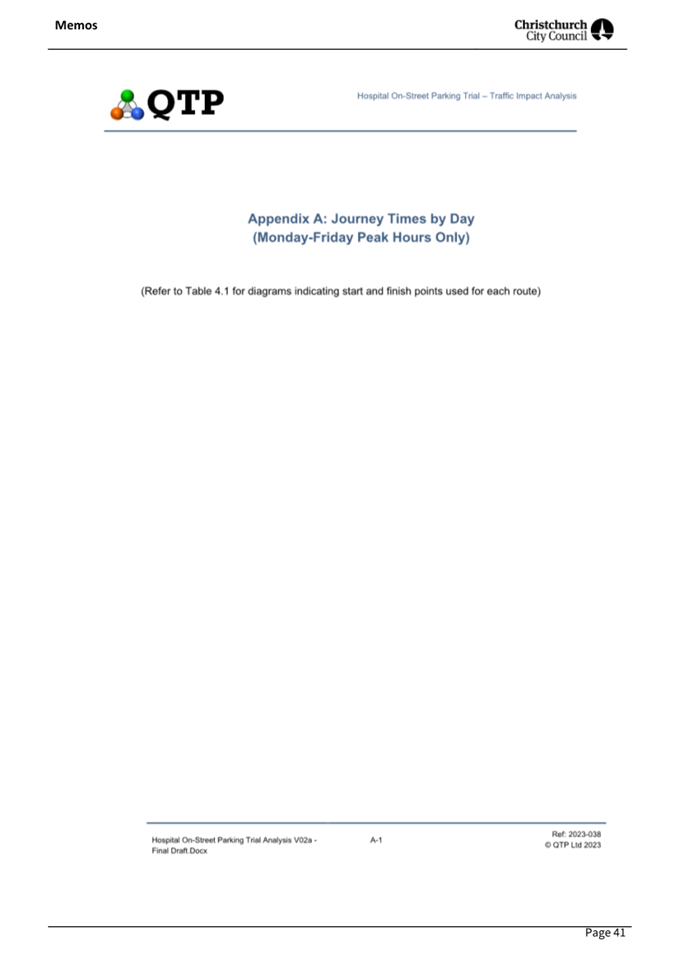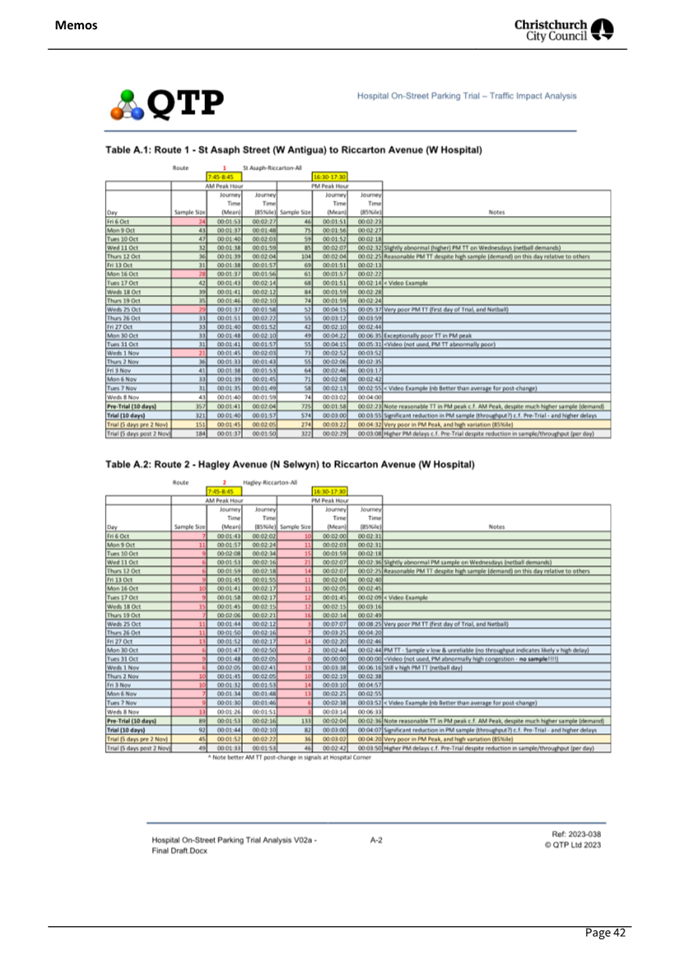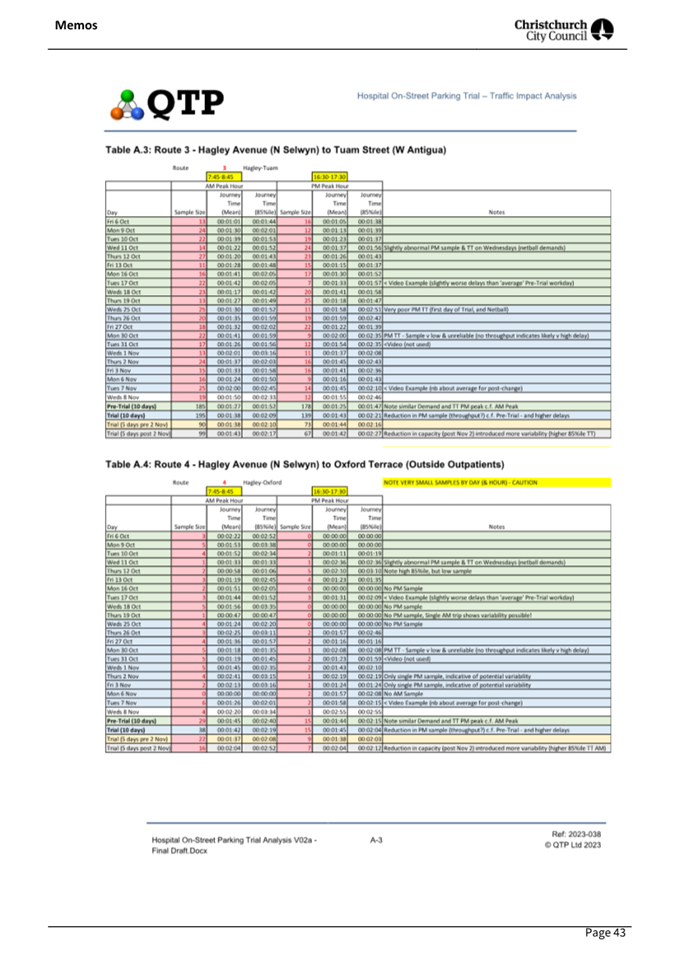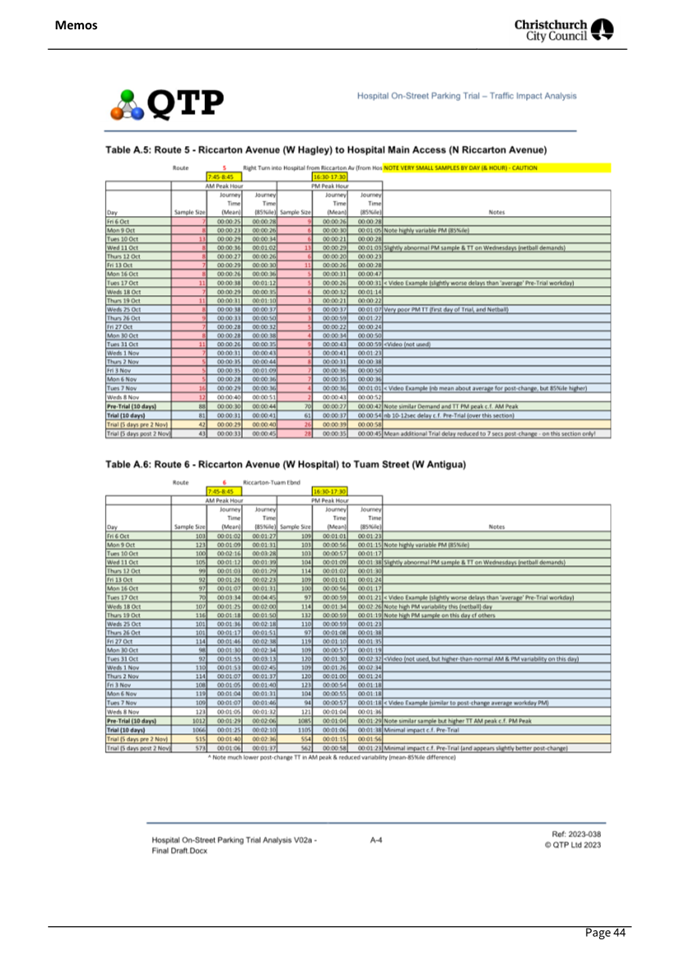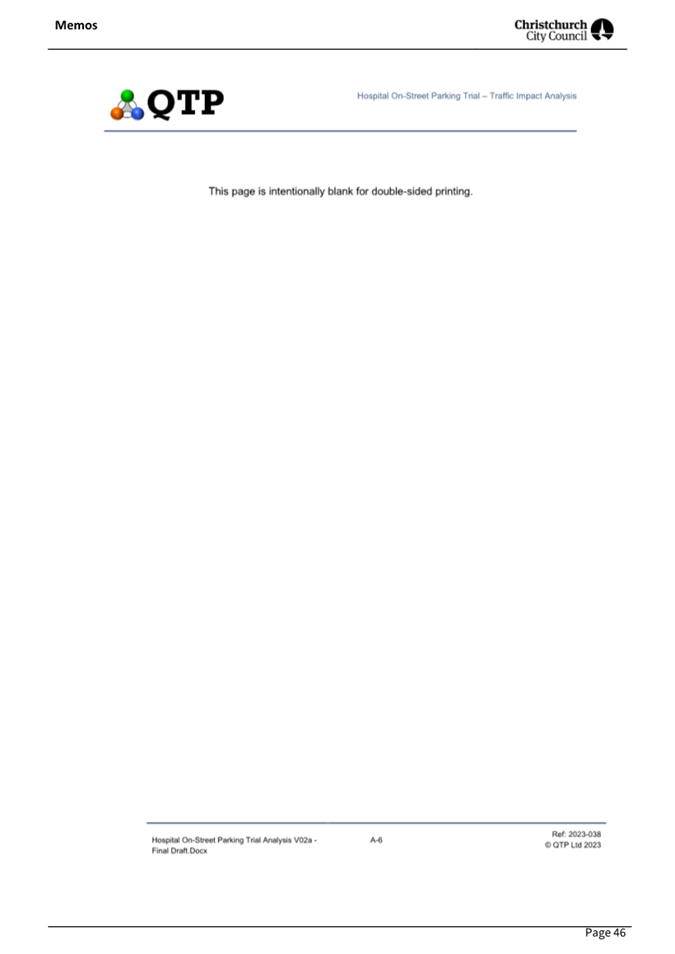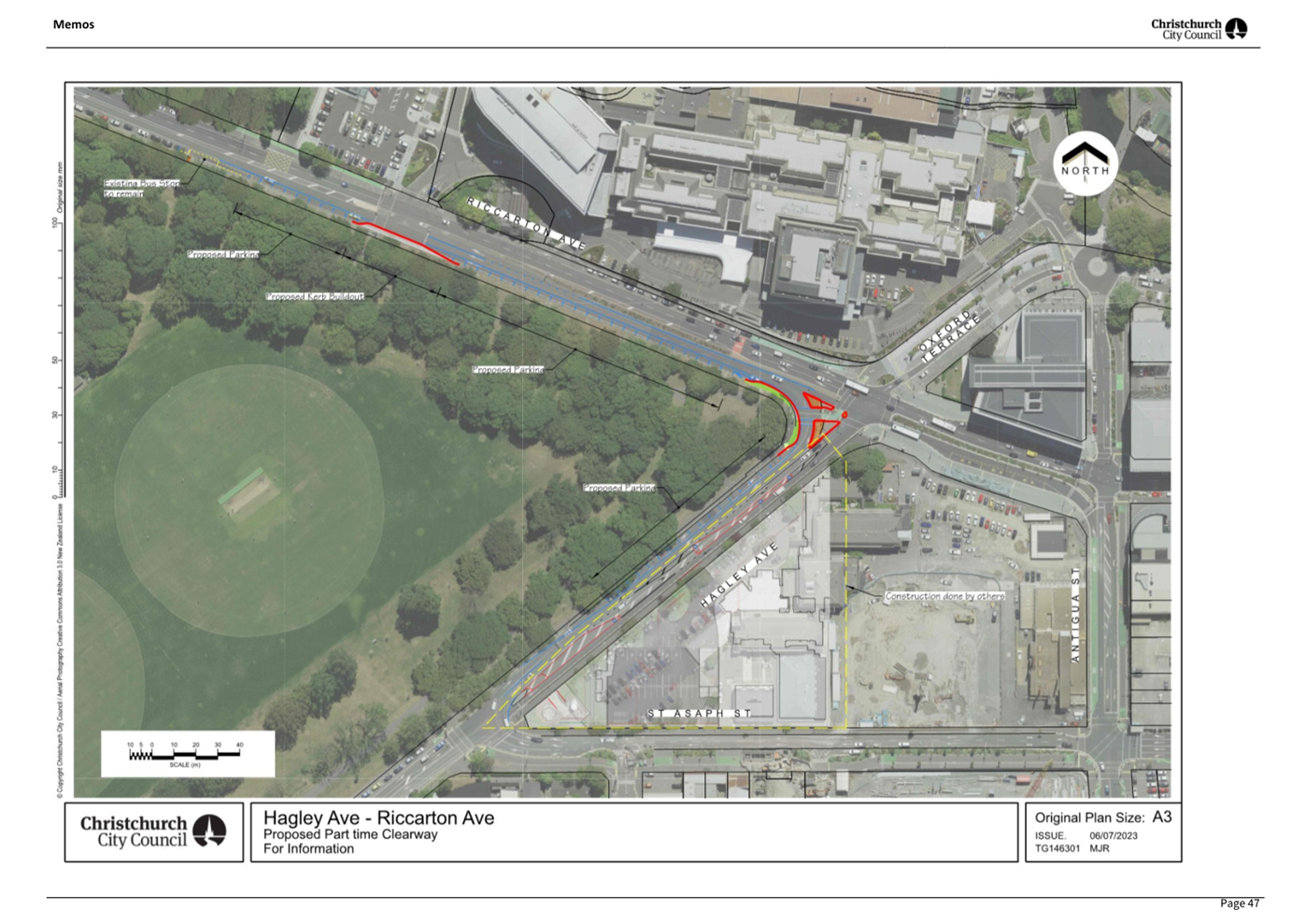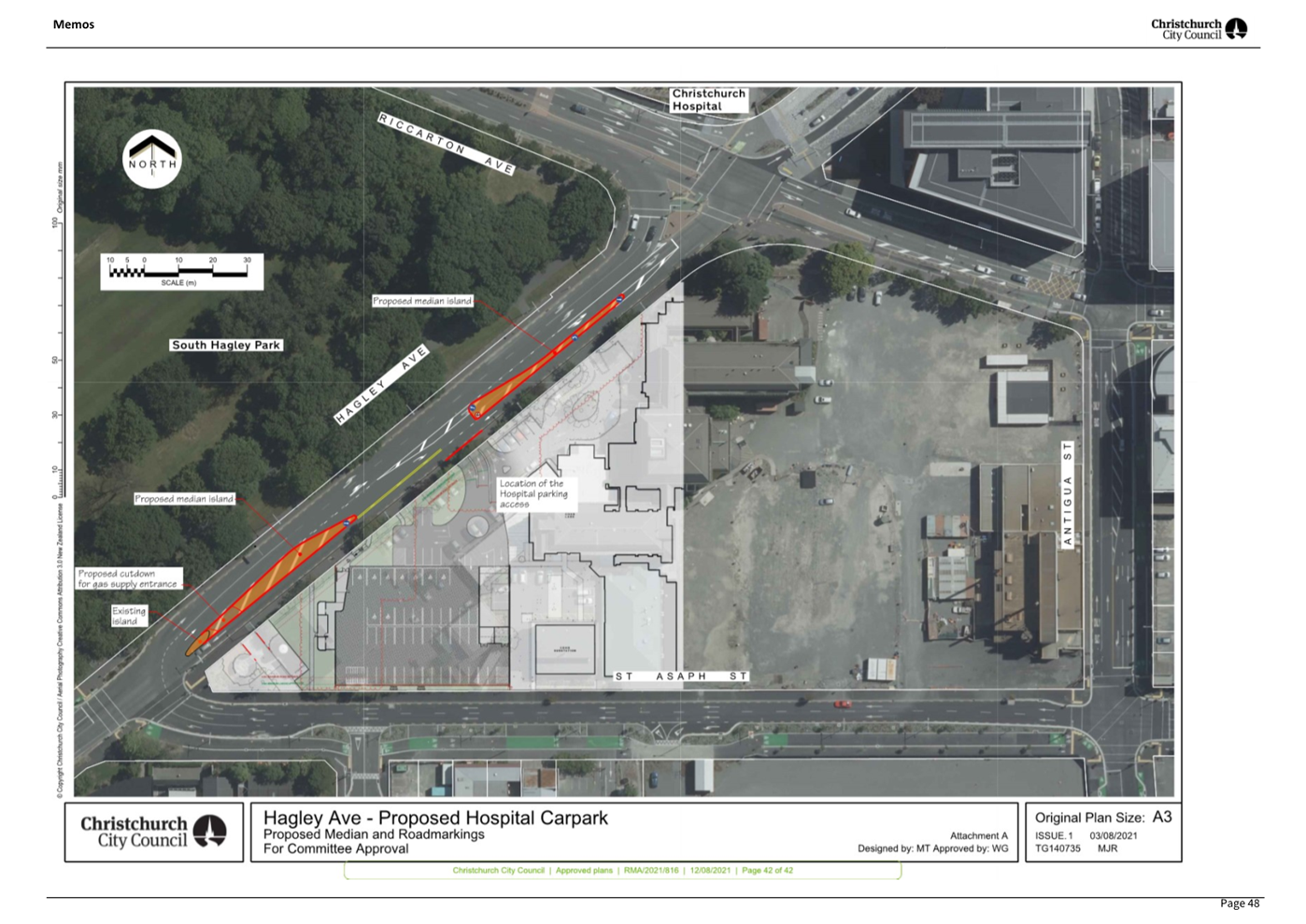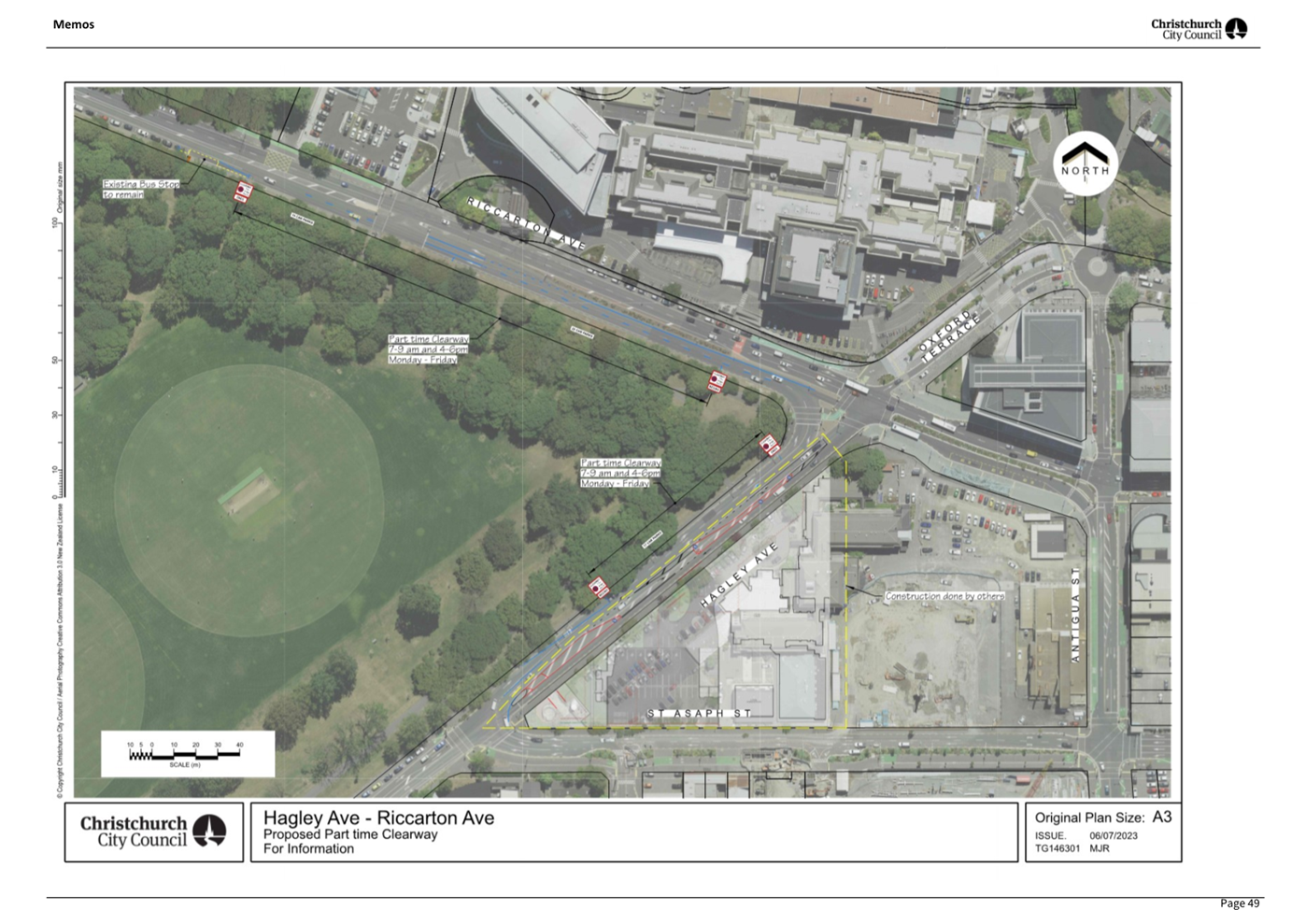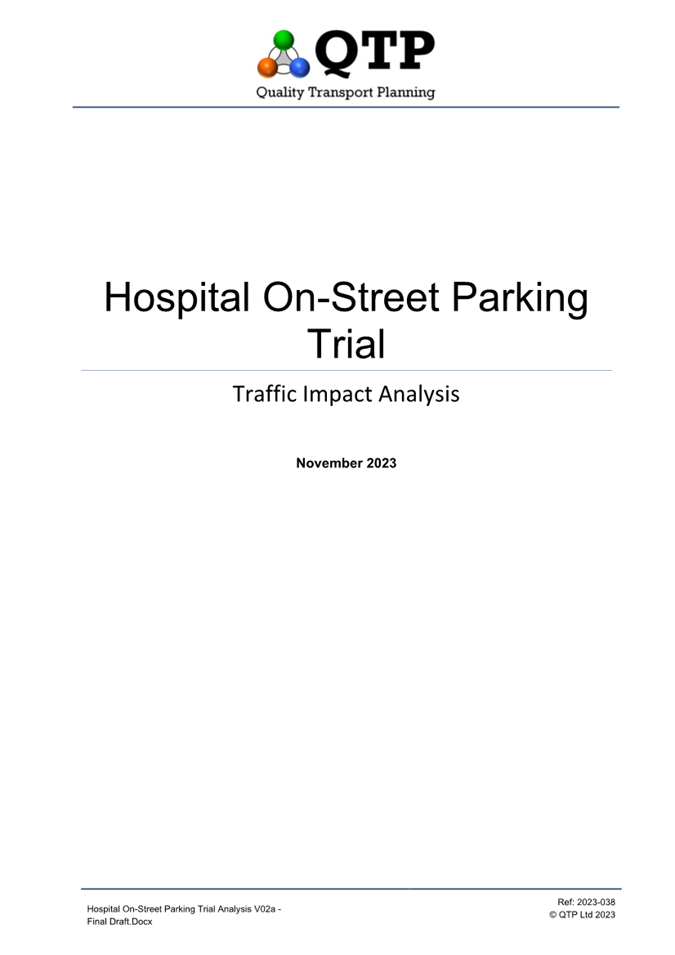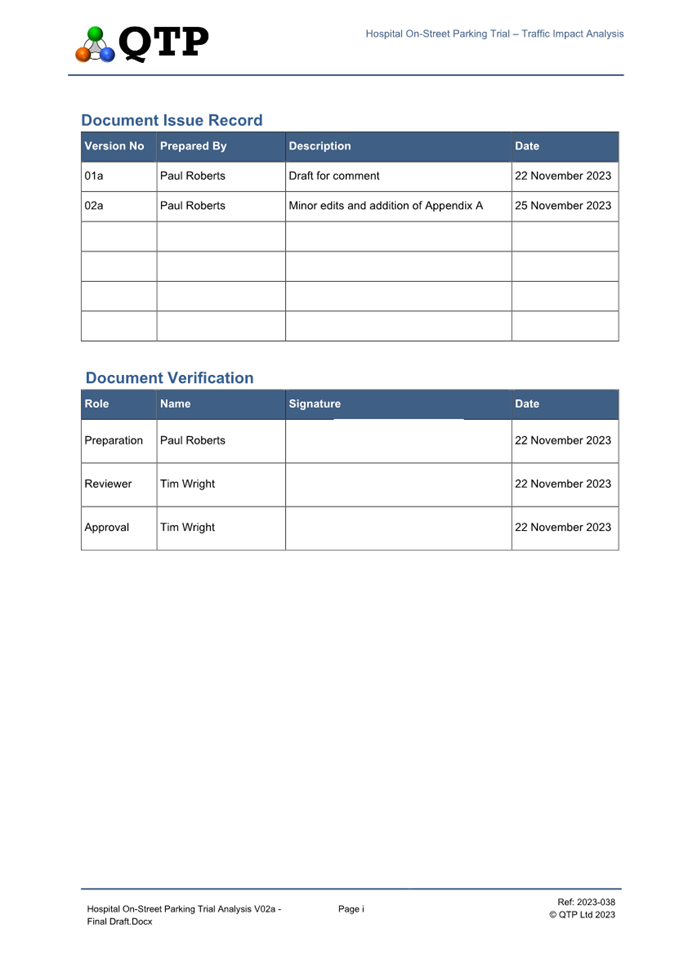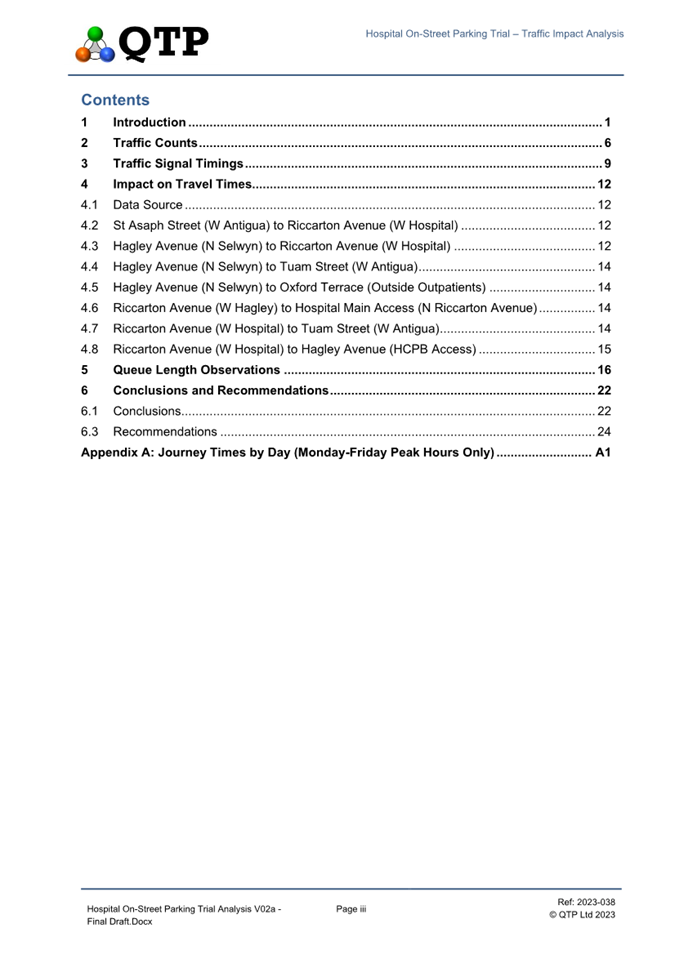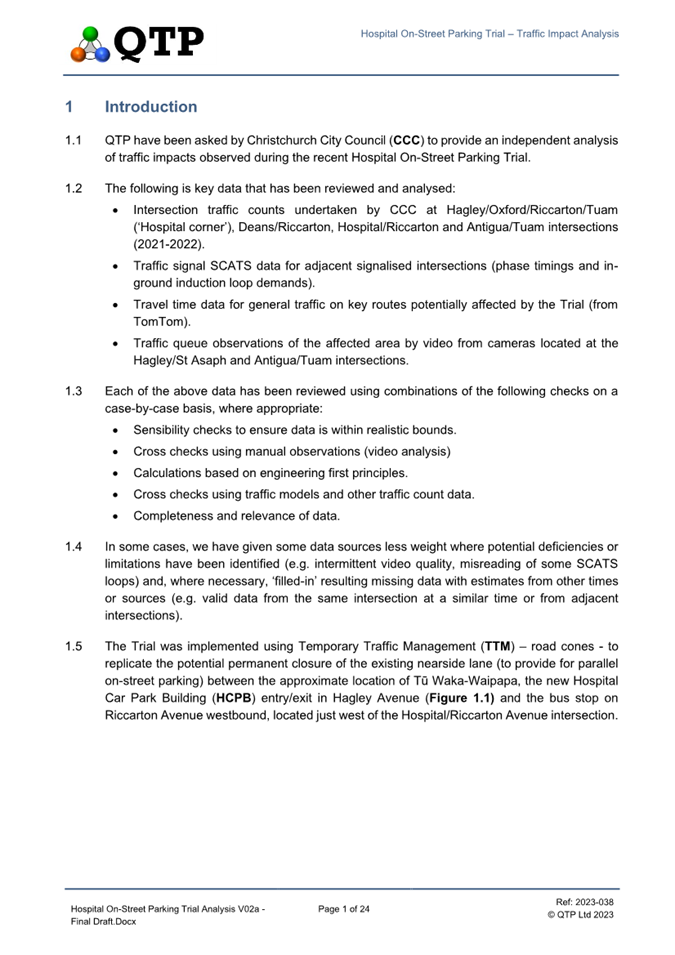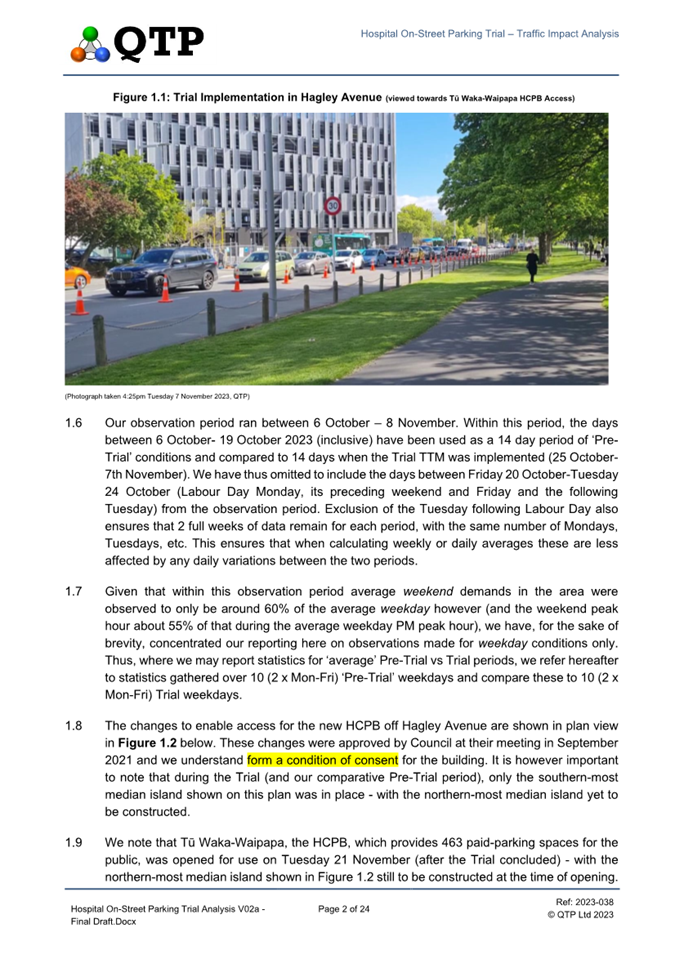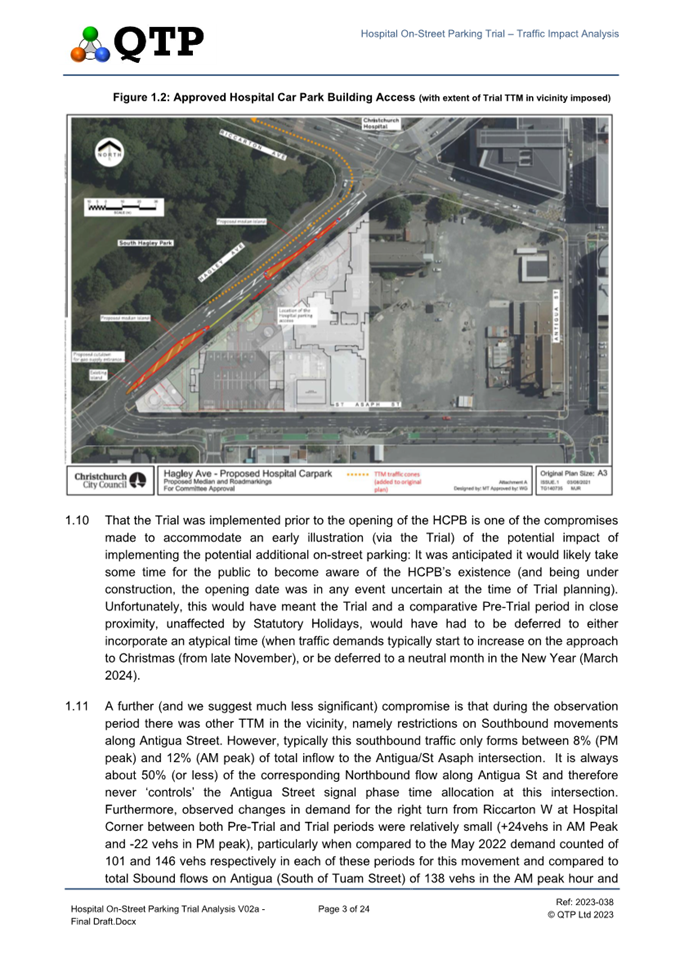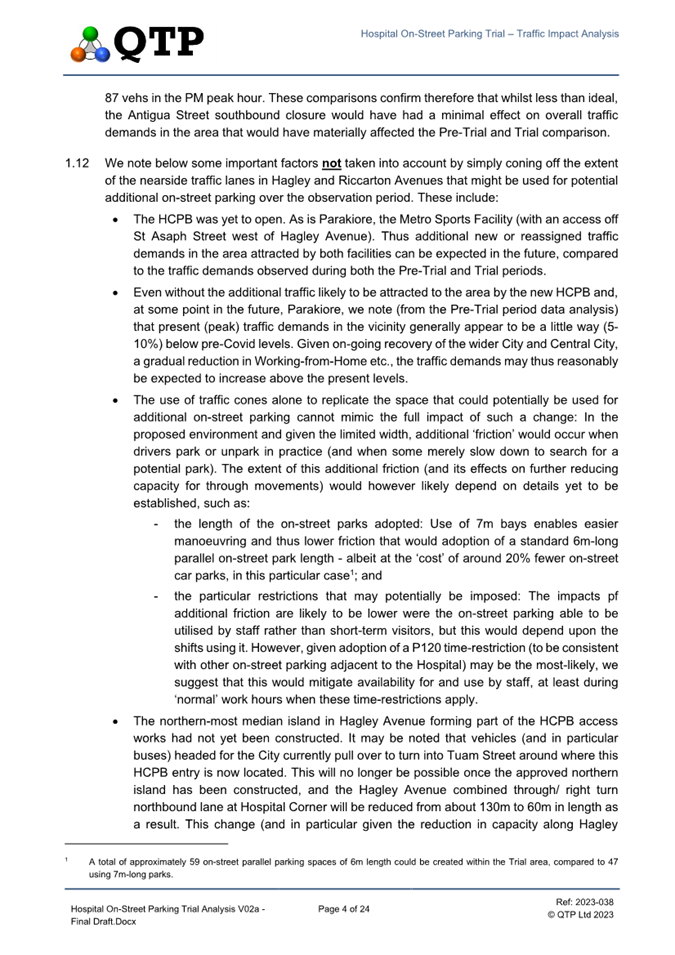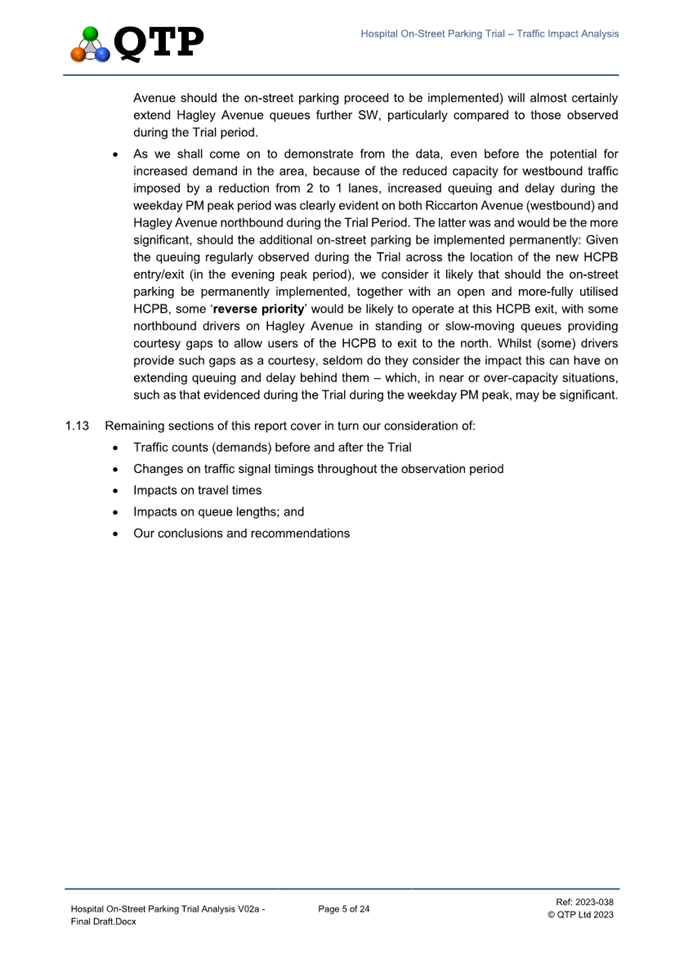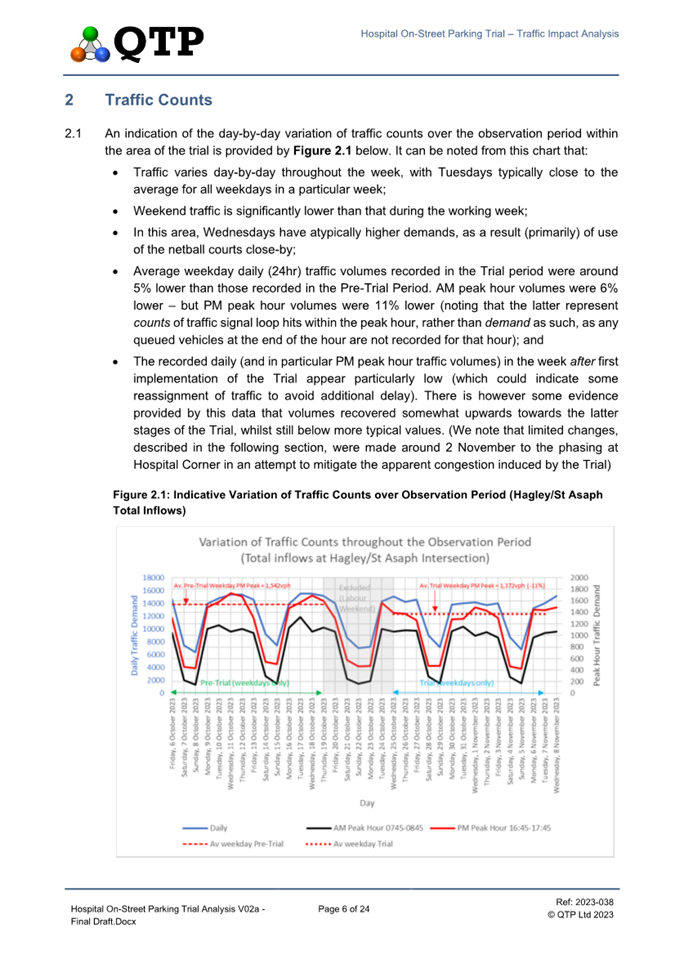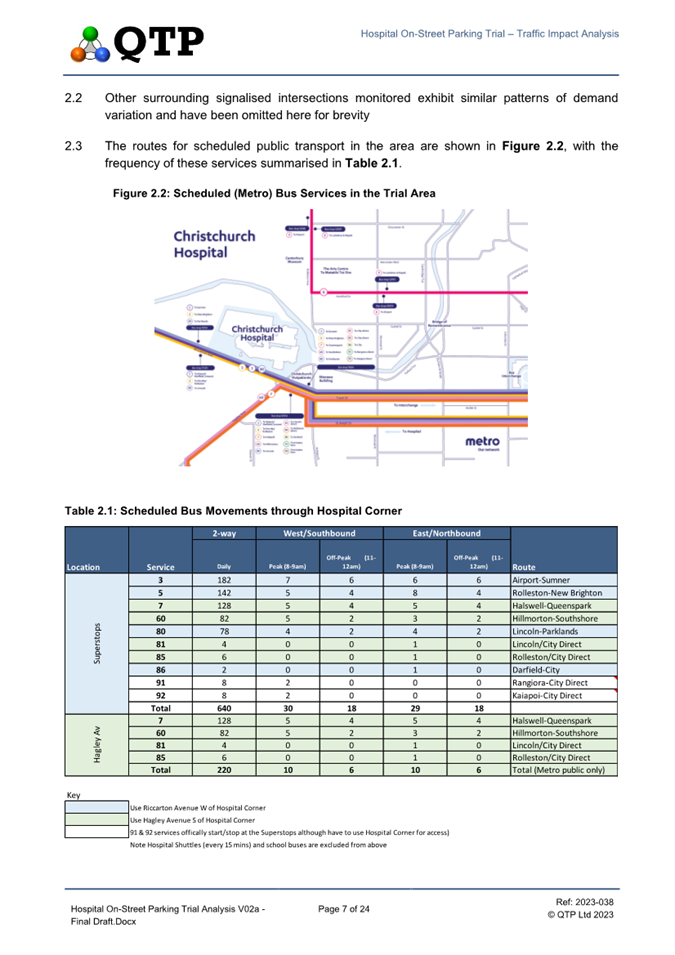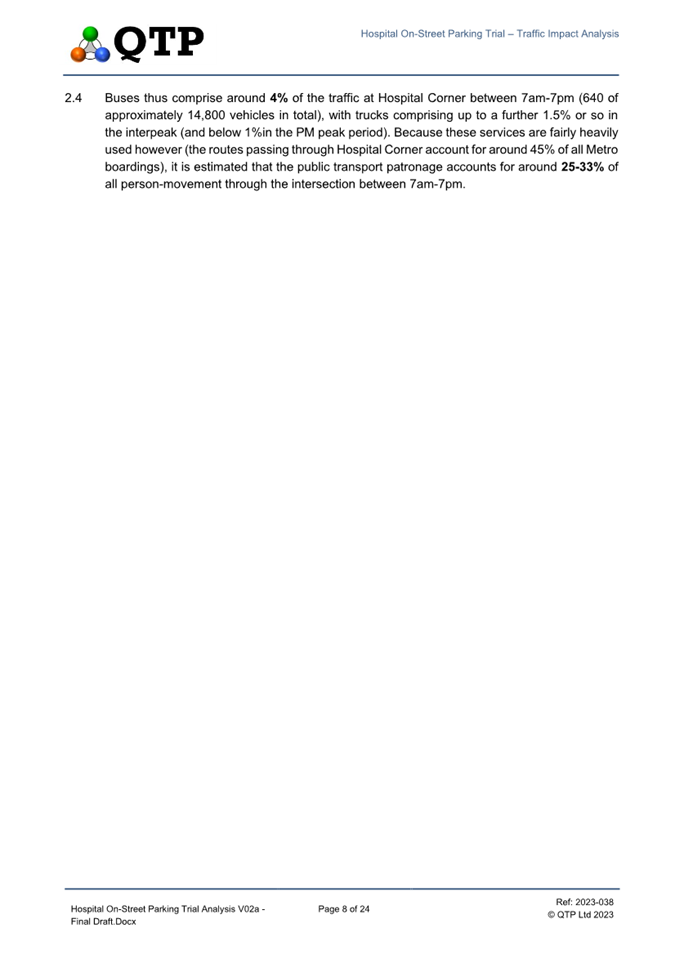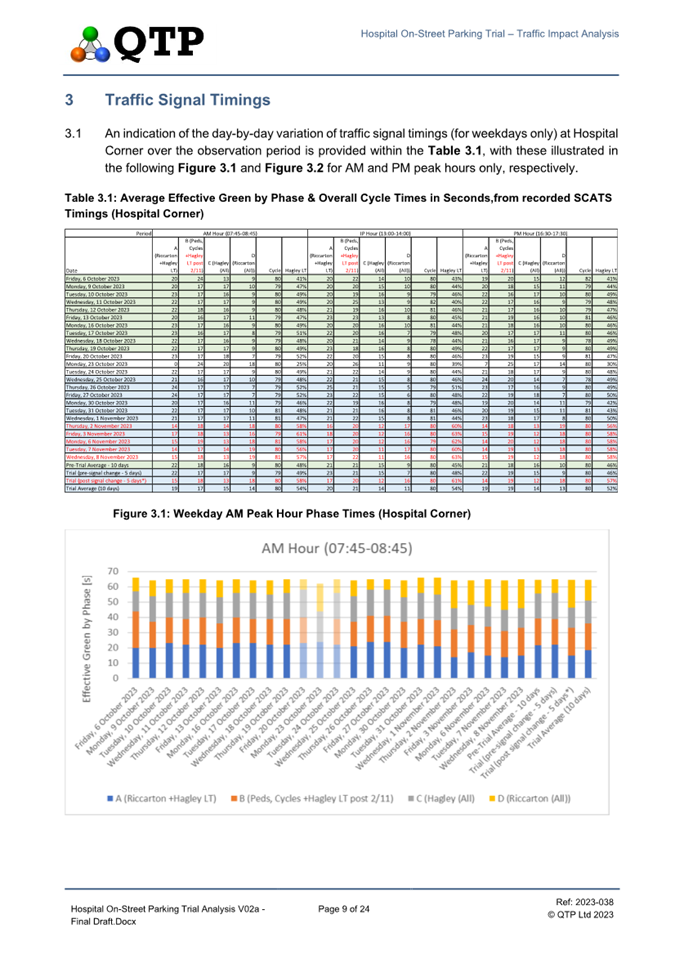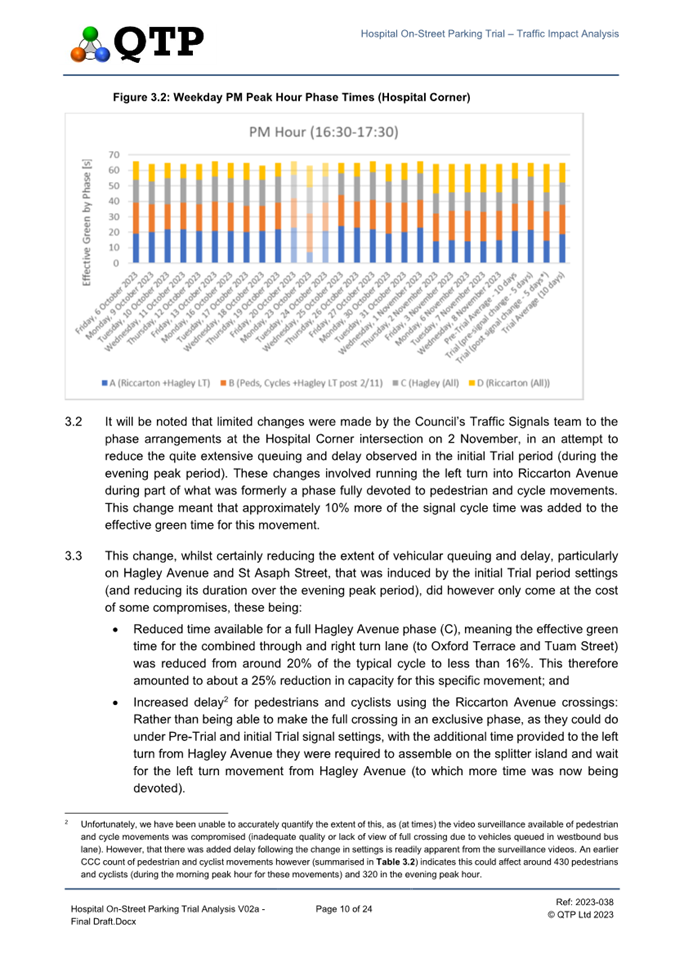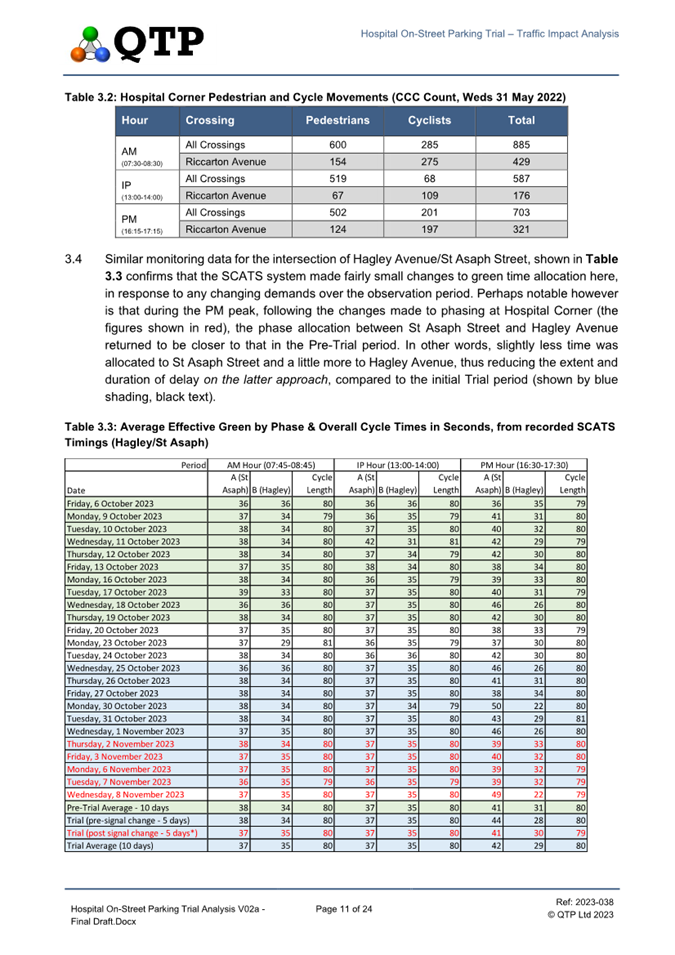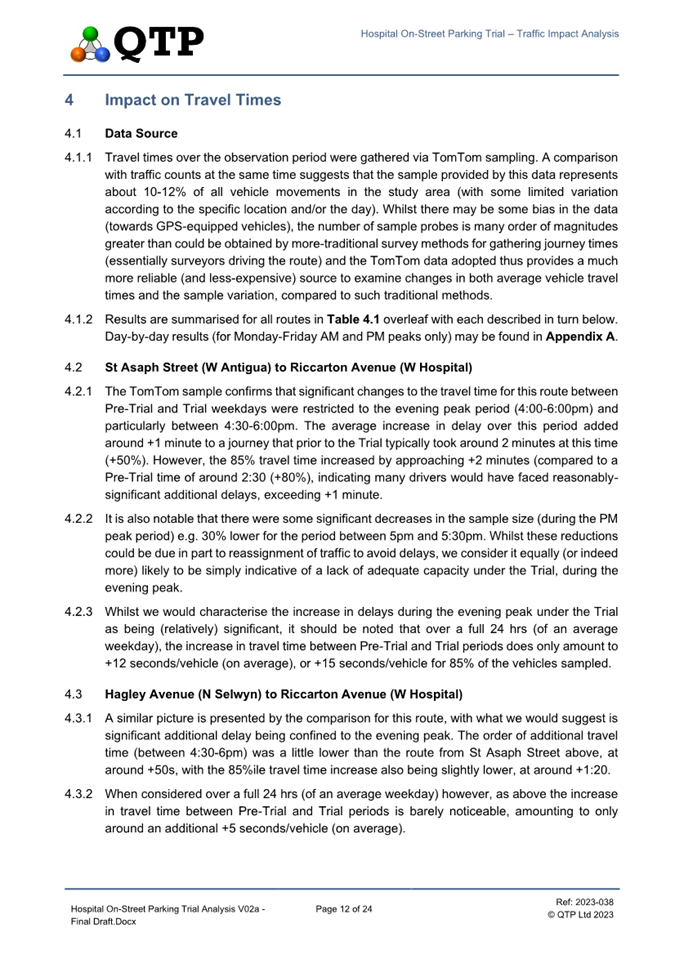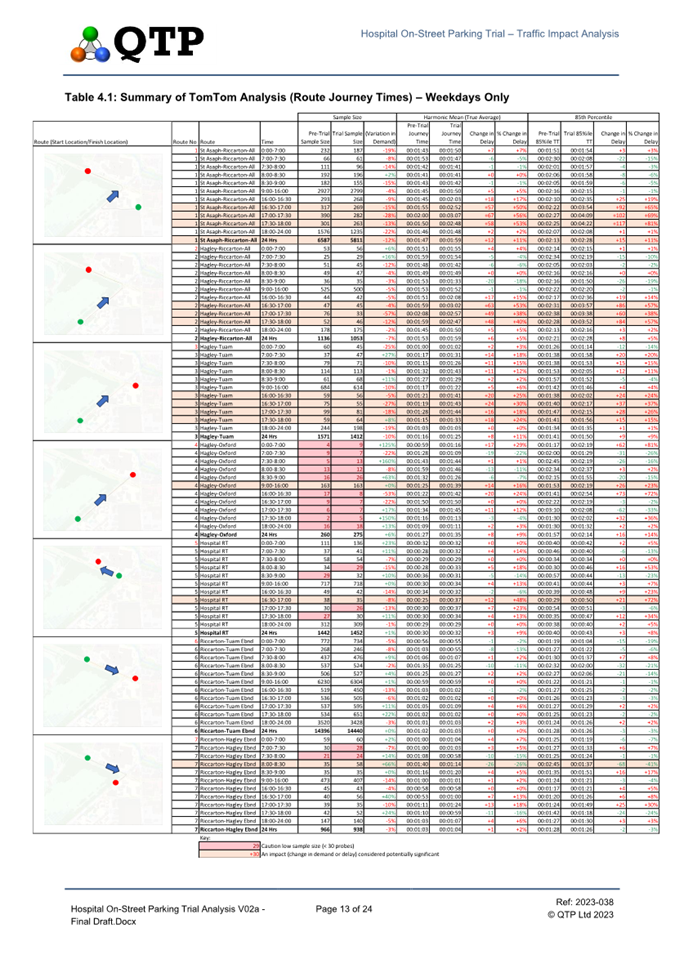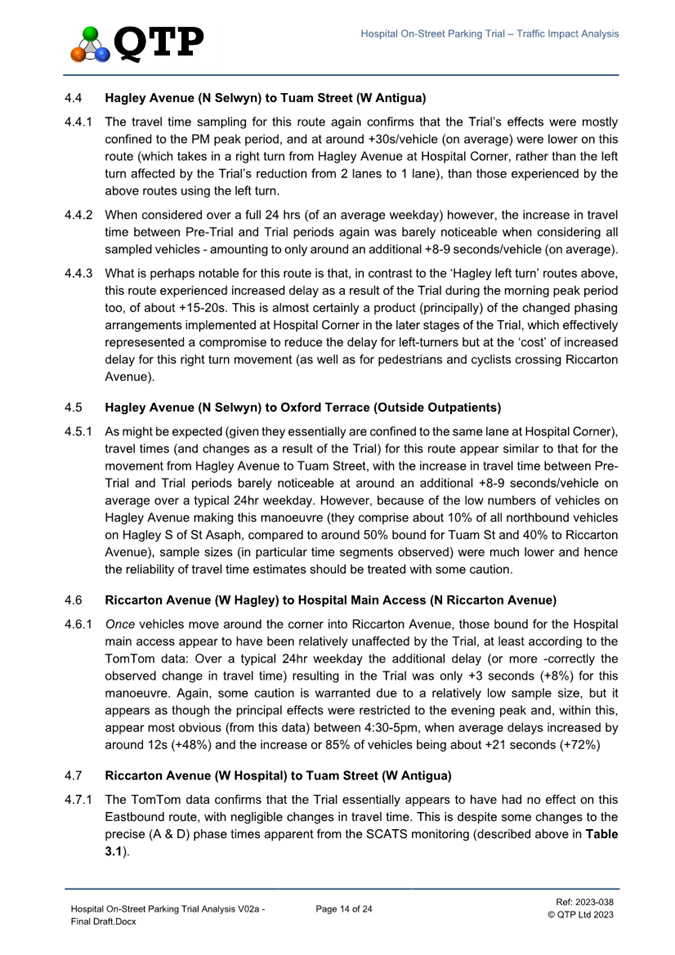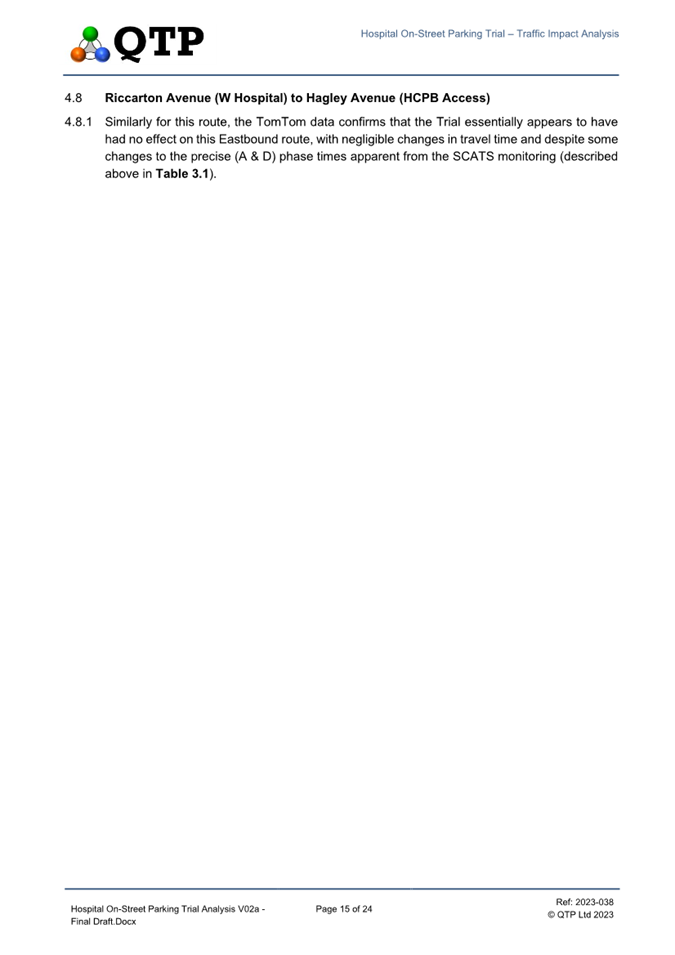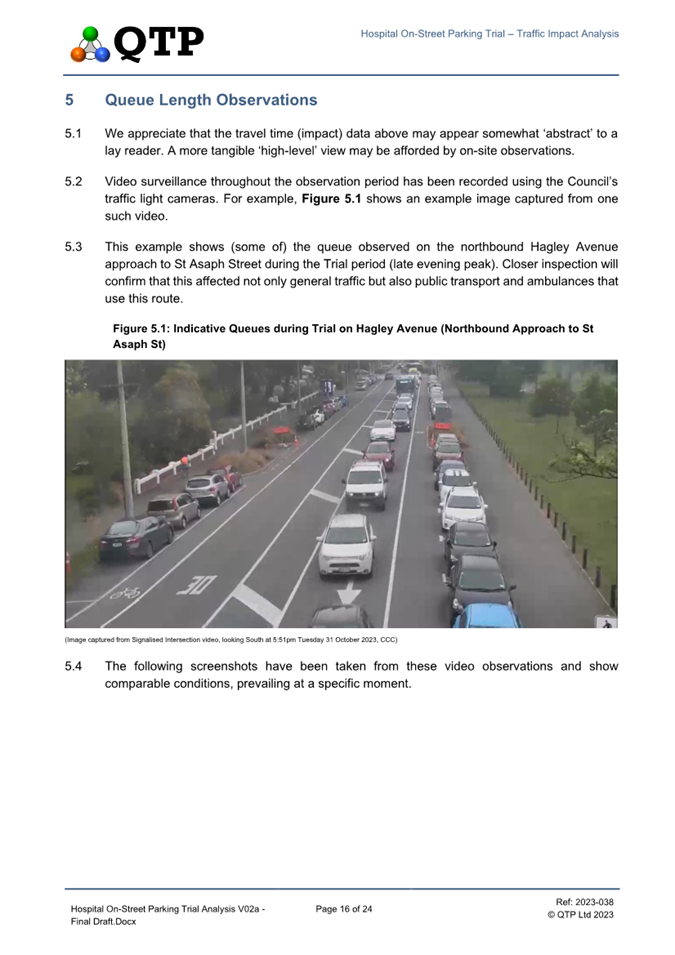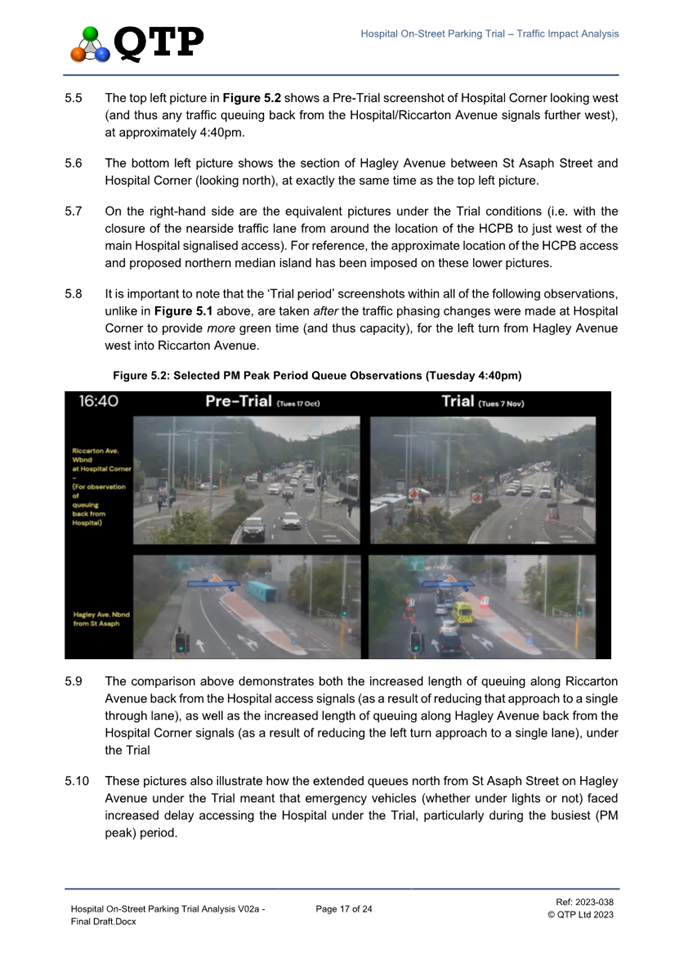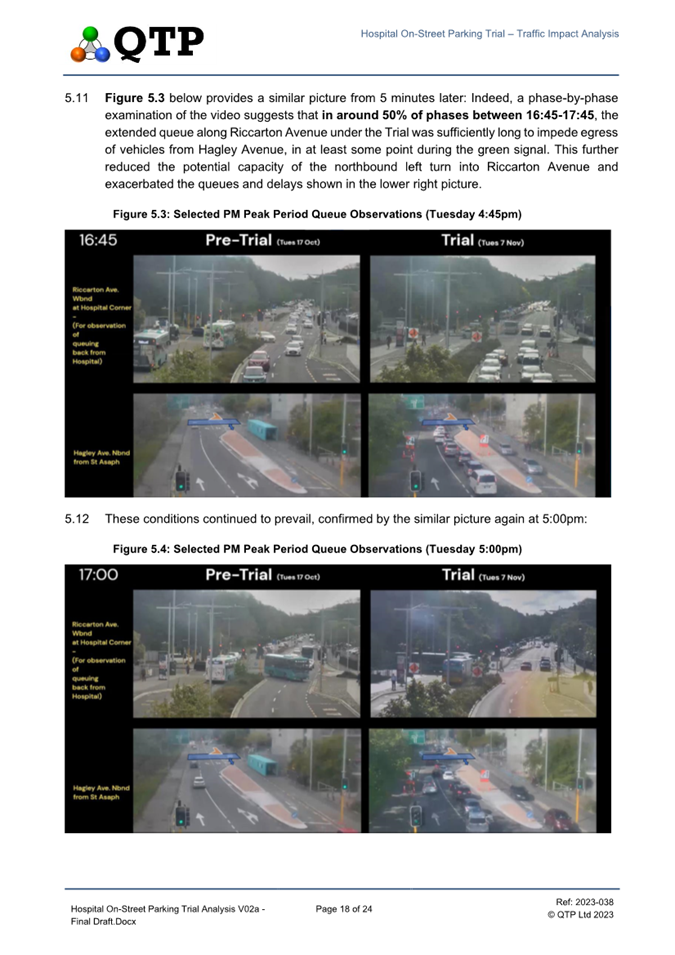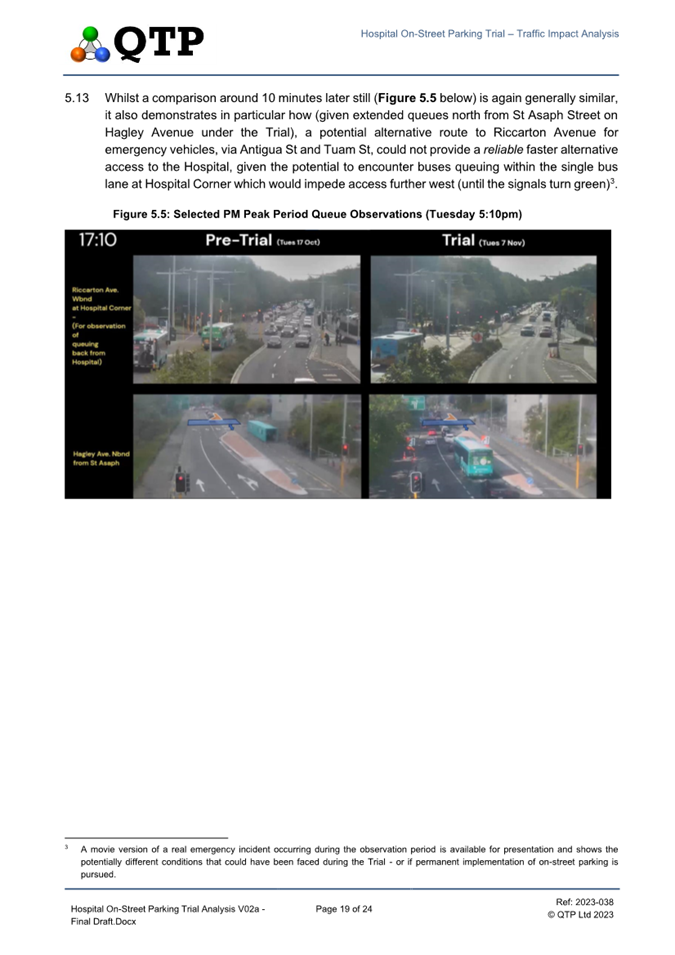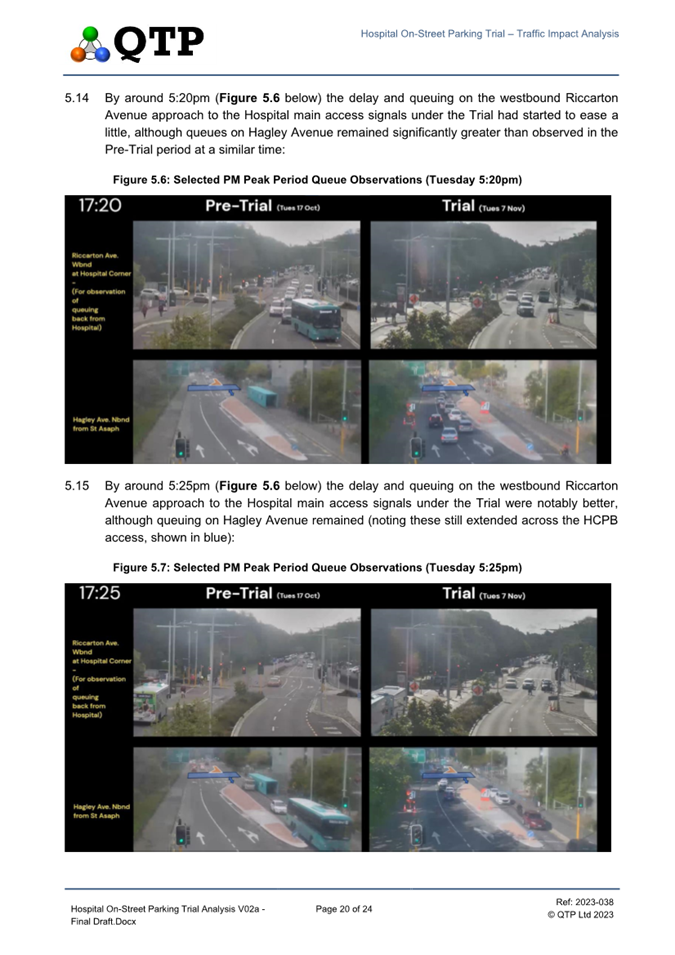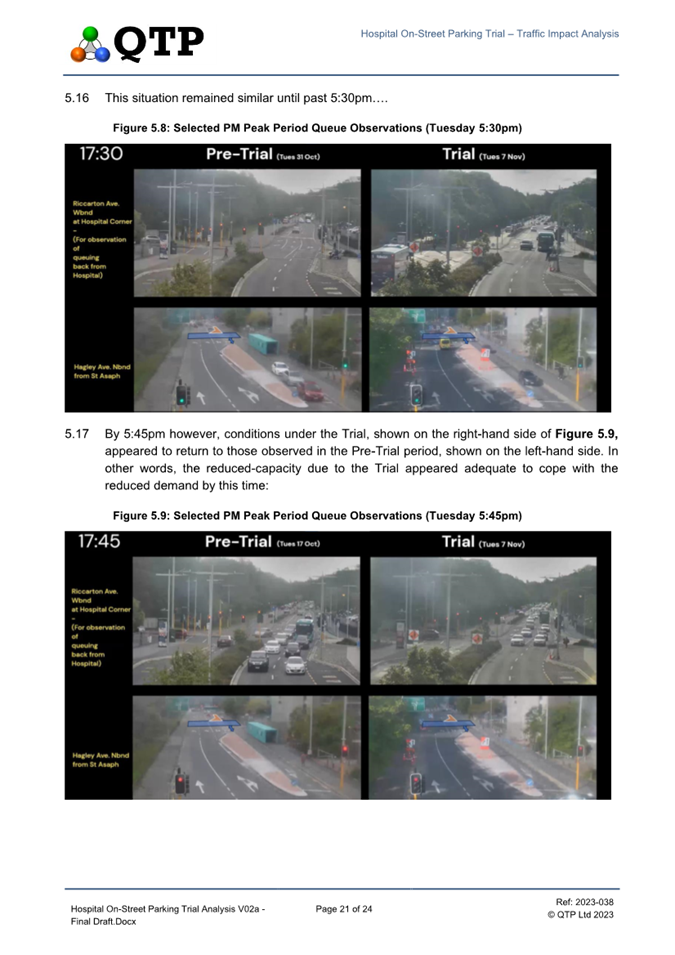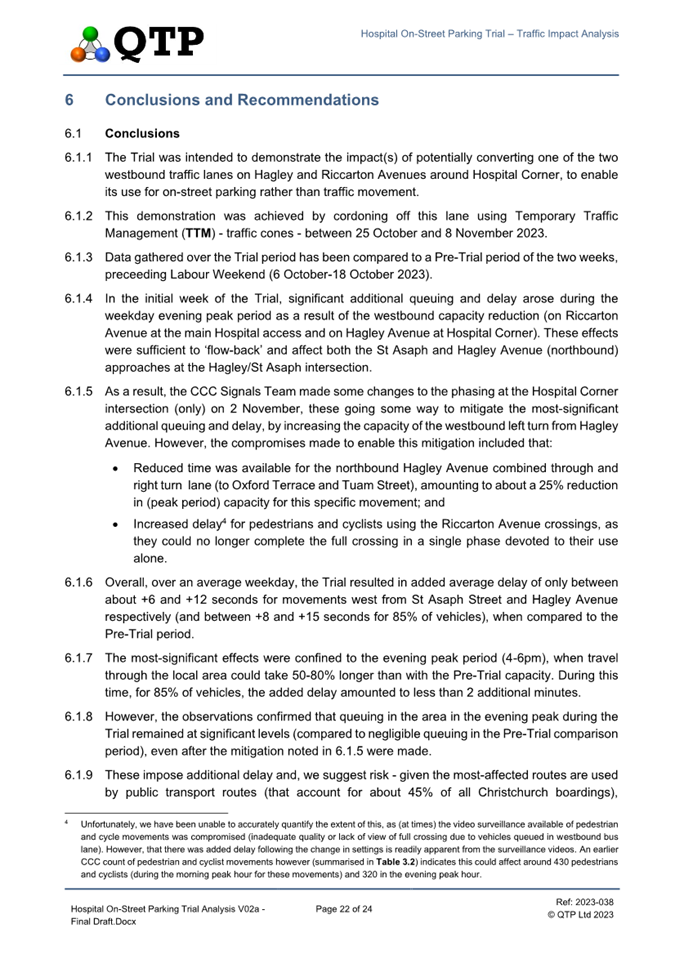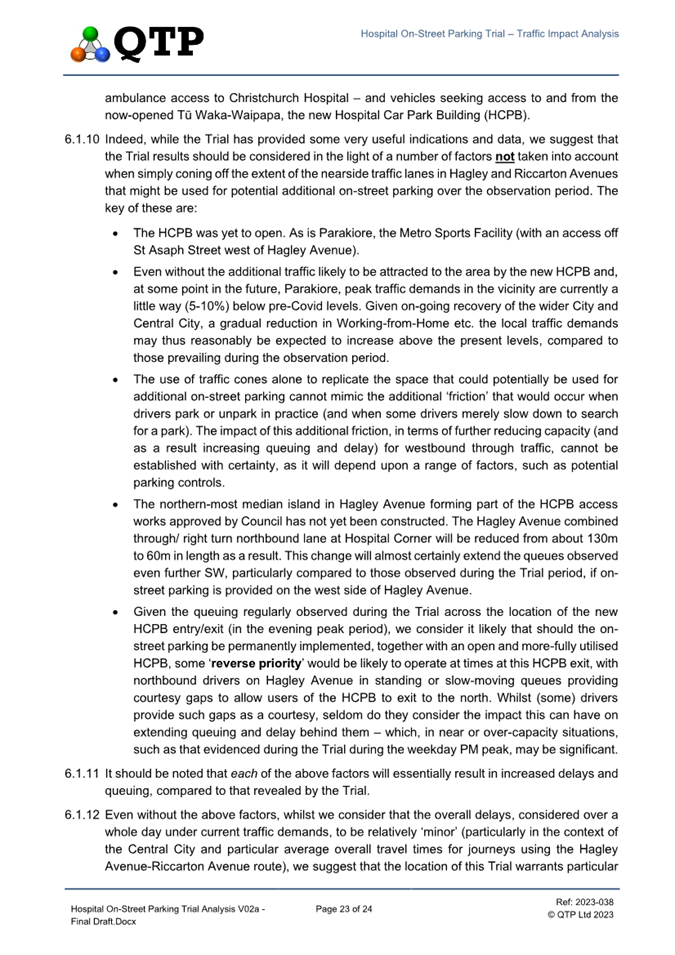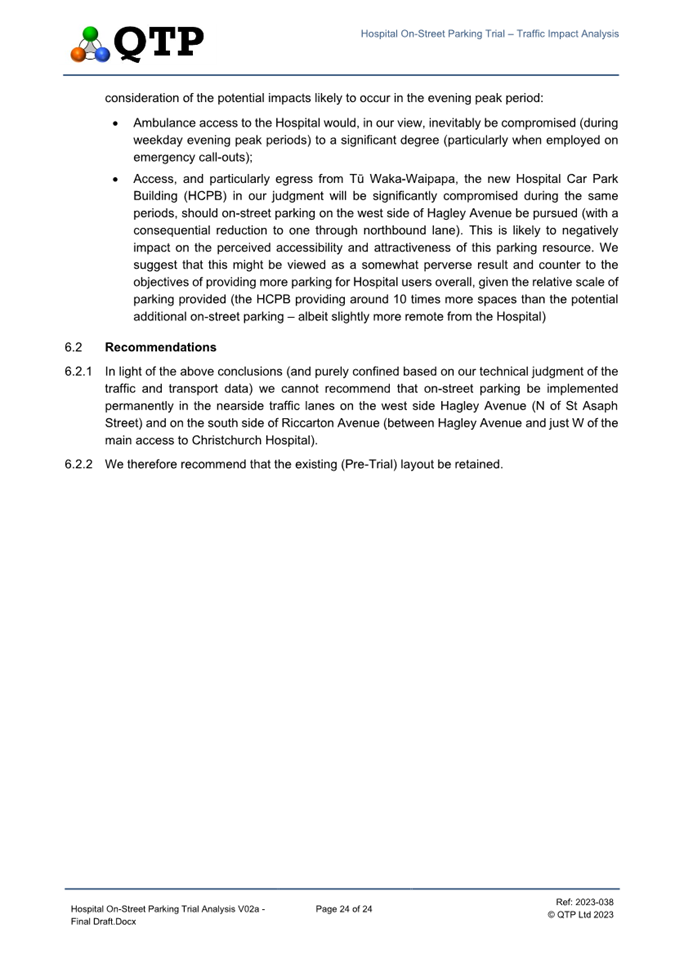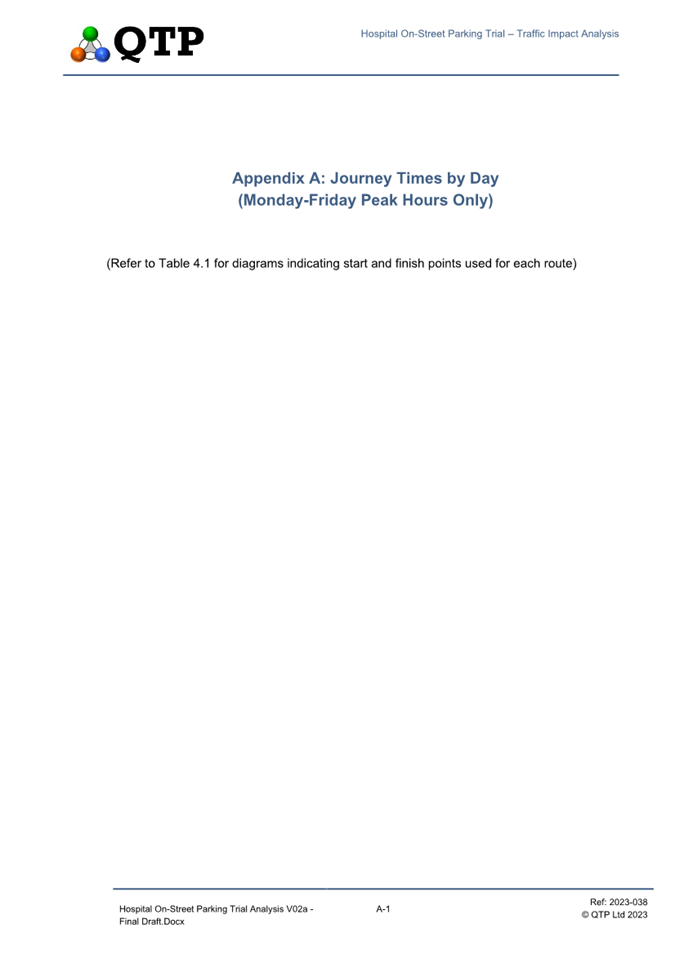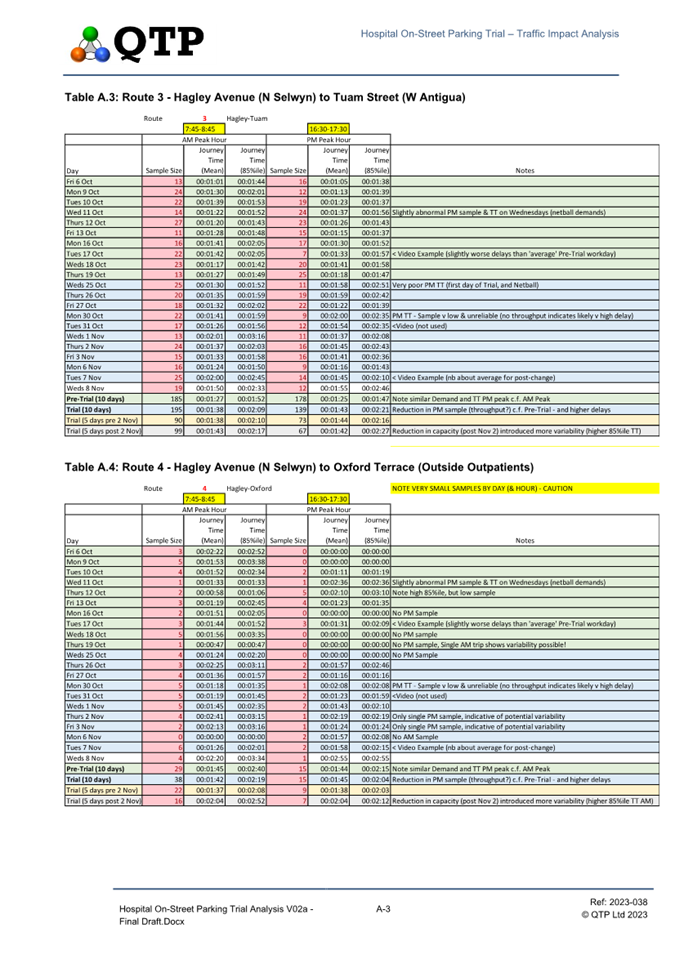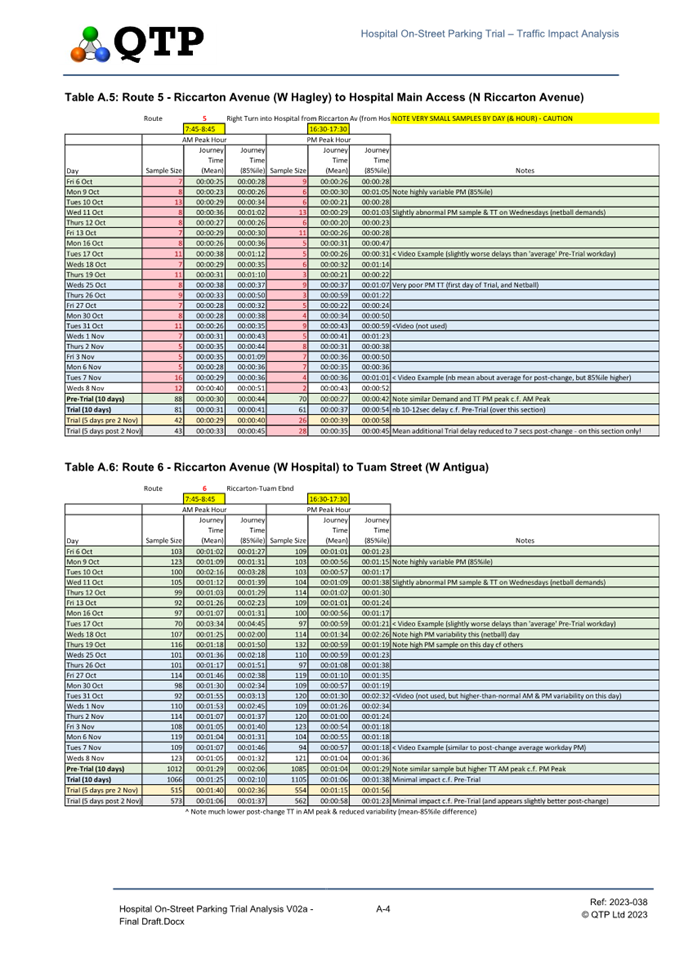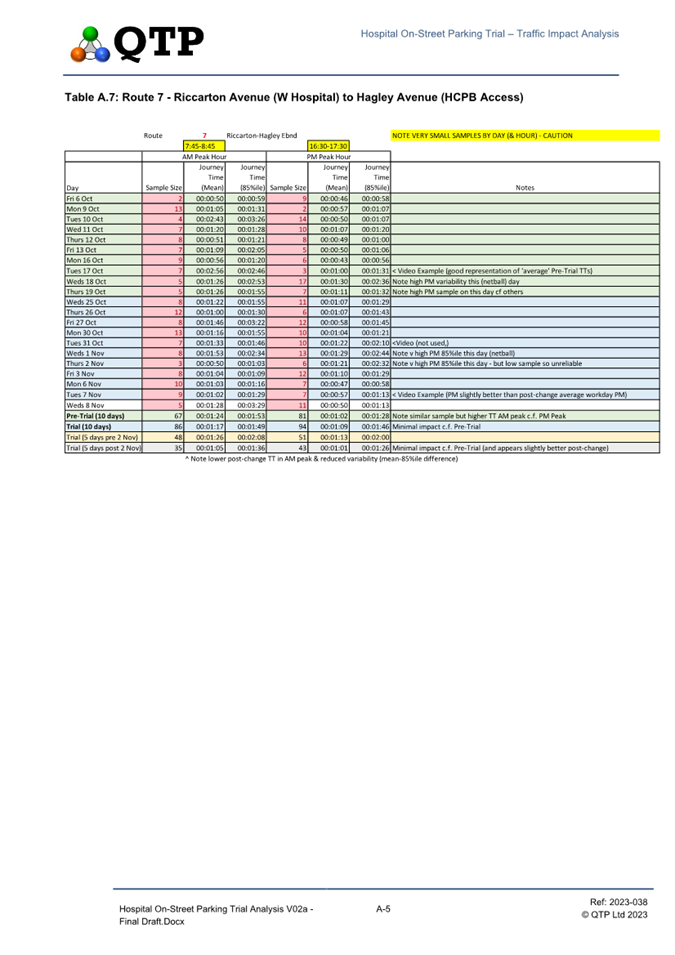
Finance and Performance Committee
Supplementary
Agenda
Notice of Meeting:
An ordinary meeting of the Finance &
Performance Committee will be held on:
Date: Wednesday 18 December 2024
Time: 9.30 am
Venue: Council Chambers, Civic Offices,
53 Hereford Street, Christchurch
Membership
|
Chairperson
Deputy Chairperson
Members
|
Councillor Sam MacDonald
Councillor Melanie Coker
Mayor Phil Mauger
Deputy Mayor Pauline Cotter
Councillor Kelly Barber
Councillor Celeste Donovan
Councillor Tyrone Fields
Councillor James Gough
Councillor Tyla Harrison-Hunt
Councillor Victoria Henstock
Councillor Yani Johanson
Councillor Aaron Keown
Councillor Jake McLellan
Councillor Andrei Moore
Councillor Mark Peters
Councillor Tim Scandrett
Councillor Sara Templeton
|
17 December 2024
Website: www.ccc.govt.nz

Part A Matters
Requiring a Council Decision
Part B Reports
for Information
Part C Decisions
Under Delegation
TABLE OF CONTENTS NGĀ IHIRANGI
C 23. Resolution to Include
Supplementary Reports Te Whakataunga Whakauru Pūrongo āpiti......................................................................................................... 4
C 24. Electricity
Procurement 2025 to 2030........................................................... 5
C 25. Parking Near
Christchurch Hospital............................................................ 15
C 17. Resolution
to Exclude the Public.............................................................. 139
1. Background Te Horopaki
1.1
Approval is sought to submit the following reports
to the Finance and Performance Committee meeting on 18 December 2024:
24. Electricity
Procurement 2025 to 2030
25. Parking
Near Christchurch Hospital
1.2
The reason, in terms of section 46A(7) of the
Local Government Official Information and Meetings Act 1987, why the reports were
not included on the main agenda is that they were not available at the time the
agenda was prepared.
1.3
It is appropriate that the Finance and
Performance Committee receive the reports at the current meeting.
2. Recommendation Te Tūtohu
2.1
That the reports be received and considered at
the Finance and Performance Committee meeting on 18 December 2024.
24. Electricity
Procurement 2025 to 2030
25. Parking
Near Christchurch Hospital
|
24. Electricity
Procurement 2025 to 2030
|
|
Reference Te Tohutoro:
|
24/2182541
|
|
Responsible Officer(s) Te Pou Matua:
|
Tian
Wang, Maintenance & Projects Advisor, tian.wang@ccc.govt.nz Paul Bakker,
Procurement & Contracts Category Lead, paul.bakker@ccc.govt.nz
Bruce Rendall, Head of Facilities & Property, bruce.rendall@ccc.govt.nz
Luke Stevens, Head of Procurement & Contracts,
luke.stevens@ccc.govt.nz
|
|
Accountable ELT Member Pouwhakarae:
|
Bede
Carran, General Manager Finance, Risk & Performance / Chief Financial
Officer
|
1. Purpose and Origin of the Report Te Pūtake Pūrongo
1.1 The
purpose of this report is to gain approval for a preferred electricity
supplier. This report is staff generated in response to the
Council’s current electricity supply contracts end date, which is 30
September 2025, and the recent Ministry of Business, Innovation and Employment’s
(MBIE) All of Government (AOG) electricity procurement tender.
1.2 The
decisions in this report are of low significance in relation to the
Christchurch City Council’s Significance and Engagement Policy. The
level of significance was determined by evaluation according to each
significance criteria relating to impacts on the community and Council
function. While the level of expenditure is high, the Council has adopted
a low-risk purchase model.
2. Officer Recommendations Ngā Tūtohu
That the Finance and
Performance Committee:
1. Receives the information in the Electricity Procurement 2025 to
2030 Report.
2. Notes that the decision in this report is
assessed as low significance based on the Christchurch City Council’s
Significance and Engagement Policy.
3. Notes the attached procurement plan for
electricity supply which recommends using the Ministry of Business, Innovation
and Employment’s All of Government Electricity procurement process.
4. Appoints Meridian Energy Limited through the
Ministry of Business, Innovation and Employment’s All of Government
Electricity Supply Panel as preferred tenderer for the supply of Time of Use,
Non-Half Hour, unmetered, and distributed unmetered load (for streetlighting
and traffic signals) electricity for a period of up to 60 months at or within
the rates listed in PX Attachment B.
5. Delegates to the Chief Executive to conclude
negotiations and enter into a contract with Meridian Energy Limited through
the Ministry of Business, Innovation and Employment’s All of
Government Electricity Supply Panel as preferred tenderer for the supply of
Time of Use, Non Half Hour, unmetered, and distributed unmetered load (for
streetlighting and traffic signals) electricity for a period of up to 60 months
at or within the rates listed in PX Attachment B.
6. Notes that the approximate value of the
contract for the full period of 60 months, based on the current indicative
energy use profile and excluding network charges and GST is $67.9 million.
7. Agrees that the attachments to this report
remain public excluded until 2 July 2025, or such a time as the contract has
been awarded and only be released on review and advice from the Head of
Procurement and Contracts
3. Executive Summary Te Whakarāpopoto Matua
3.1 Electricity
is currently supplied via contracts that expire on 30 September 2025.
3.2 The
Council has traditionally purchased its electricity through the AOG procurement
process. MBIE, who administer the AOG contract, recently sought prices
from its panel for new contracts commencing on 1 October 2025.
3.3 Staff
and independent advisors have reviewed the prices and concluded that those
offered by Meridian Energy Limited are attractive and that the Council is
unlikely to get better pricing.
3.4 On
that basis staff recommend that Meridian be appointed as preferred tenderer,
and that staff be authorised to undertake negotiation around the terms of the
contract including length and options to find ways to reduce grid emission
factors associated with the supply of electricity.
4. Background/Context Te Horopaki
4.1 The
Council currently spends around $15 million per annum on the supply of
electricity. This figure excludes network charges, which add another
approximately $5 – 6 million per annum taking total spend to circa $20 -
21 million.
4.2 Electricity
is currently supplied by Simply Energy Limited (streetlighting) and Meridian
Energy Limited (all other forms of supply and metering) via a contract that
expires on 30 September 2025.
4.3 When
procuring electricity supply, staff are guided by the following objectives:
4.3.1 Ensuring
reliable supply;
4.3.2 Managing
electricity supply costs wisely through:
· Seeking the best
price;
· Reducing price
volatility;
· Minimizing price
risk; and
4.3.3 Alignment
with other strategic objectives, particularly emission reduction targets (i.e.
achieving net zero greenhouse emissions by 2045 (with separate targets for
methane), and to halve our emissions by 2030, from 2016-17 levels).
4.4 The
Council has traditionally purchased its electricity through the AOG procurement
process.
4.5 Staff
discussed in principle participation in the AOG procurement process in a
meeting held with MBIE on 8 August 2024. MBIE indicated their intention to go
to market for fixing the Financial Year 2026, 2027 and 2028 electricity
prices. Due to the high peak in electricity spot prices during August and
September, MBIE postponed going to market until late October 2024.
4.6 On
November 1 the Council was notified that invitations for pricing offers for the
Council's electricity supply were issued on 31 October 2024, to the five MBIE
AOG electricity panel suppliers. The tender closing date was 21 November 2024.
Simply Energy, Genesis Energy, Mercury Energy, Meridian Energy and Manawa
Energy are members of the MBIE AOG Electricity Panel.
4.7 MBIE
has now informed Council of the prices received.
4.8 Council
staff have reviewed the prices themselves and commissioned independent
advice.
4.9 The
staff assessment is that the prices received are attractive and better than
market. The independent advice concurs and includes the following
statements:
· Given
current market conditions the AOG offer provides a lower cost proposition
against the average market pricing in the Christchurch area.
· It is therefore unlikely that an
approach to market in the near future will provide a lower price.
4.10 The
best prices have come from Meridian Energy Limited. These prices are valid
until 20 December 2024.
4.11 The following related information session/workshops have taken place
for the members of the meeting:
|
Date
|
Subject
|
|
17
December 2024
|
Electricity Procurement
|
Options Considered Ngā Kōwhiringa Whaiwhakaaro
4.12 The
following options have been considered feasible as part of this report:
4.12.1 Option1: Accept
Meridian’s price through the MBIE AOG Contract;
4.12.2 Option 2:
Decline Meridian’s price and seek pricing later through the MBIE AOG
Contract
4.12.3 Option 3:
Decline Meridian’s price and seek pricing directly from the market
through an open market tender
4.13 The
following options have been considered but are not feasible, so detailed
analysis has not been undertaken.
4.13.1 Do nothing
– effectively this would mean staying with the current two suppliers at
the expiry of the contract but being subject to variable “spot”
rather than fixed pricing. This is likely to lead to increased overall
cost and more price volatility so is not considered feasible.
4.13.2 Decline
Meridian’s price and accept other pricing through the MBIE AOG
Contract. This is not considered advisable or feasible as the other
prices are higher and there is no agreement to hold the prices until Council
makes its decision.
4.13.3 Alter
Council’s purchasing model. The Council currently procures using a
“fixed price, variable volume (FPVV)” model through the AOG
contract. This approach best matches Council’s objectives
currently. Besides the feasible model of going to market with a FPVV
model, the Council could consider other models including purchasing on the spot
market, purchasing on the spot market with hedging, or power purchasing
agreements with either spot or FPVV contracts to cover shortfalls. These
other models have less price certainty, higher risk, lower availability and
increased administration costs than the Council’s current model. At
this time, they are not feasible for the Council, however, they may be in the
future particularly as the market matures. Council may wish to consider
these models as they may have lower prices and meet other strategic
objectives. There is insufficient time to develop, gain approval and
implement an alternative model before the expiry of the current contracts.
4.14 Accept
Meridian’s price through the MBIE AOG Contract (preferred option)
4.14.1 Option
Description: Meridian has overall supplied the best pricing (TOU, NHH, Streetlighting,
unmetered) through the MBIE secondary procurement process. This option is
to appoint Meridian Energy Limited as the preferred tenderer and negotiate with
them to finalise the terms of the contract.
4.14.2 Option
Advantages:
· Meridian’s
offer has the best price of those received through the secondary procurement
process. The price is better than market and independent expert advice is
that we are unlikely to get better prices currently.
· Depending on
the final term of the contract, Meridian’s average unit rates are lower
in future years than current rates.
· Meridian has a
mix of hydro, wind and solar (under construction) generation assets, and
Meridian’s assets are 100% renewable generation sources. Due to the
operation of the electricity market, however, it is not possible to say that
all electricity supplied comes from 100% renewable sources.
· Meridian is
the incumbent for most of the Council’s supply and the transition to a
new contract is likely to be easier than if a new supplier is appointed.
4.14.3 Option
Disadvantages
· This option,
as presented, does not offer scope for emission reduction. Electricity
sourced through the national grid attracts a grid emission factor for emission
accounting purposes. These emission factors can be offset, at a cost,
through financial mechanisms. The current offer does not include
these offsets, albeit there is scope to negotiate.
· While longer
terms offer better pricing, they may preclude the Council taking up emerging
opportunities such as Power Purchasing Agreement with the Kowhai Park
development at Christchurch International Airport.
4.14.4 Suboptions:
Meridian has supplied pricing from 36 to 60 months. On an
“everything else being equal” basis, the longer-term pricing offers
savings over current rates. While price certainty and future savings are
attractive, a longer term reduces flexibility and the ability to explore new
and emerging opportunities particularly as they relate to reducing grid
emission factors and meeting emission targets. Council could seek to
negotiate specific terms with the aim of best meeting all its objectives.
Appointing Meridian as a preferred tenderer and then giving authority to staff
to negotiate specific terms is a possible way to achieve these objectives.
4.15 Decline Meridian's price and seek pricing later
through the MBIE AOG Contract
4.15.1 Option Description: Council could decide to decline
Meridian’s price and join a later secondary procurement process.
4.15.2 Option
Advantages:
· There may be
better prices at a later stage, particularly if more suppliers participate
and/or inflows to the hydro-electric dams hold up.
· Other
suppliers may offer alternative products that help the Council achieve its
emission reduction targets.
4.15.3 Option
Disadvantages
· Independent
advice is that it is unlikely that we will be able to get better prices from
the market based on current trends and predictions.
· This option,
as presented, does not offer scope for emission reduction. Electricity
sourced through the national grid attracts a grid emission factor for emission
accounting purposes. Thes emission factors can be offset, at a cost,
through financial mechanisms.
4.16 Decline
Meridian’s price and seek pricing directly from the market through an
open market tender
4.16.1 Option
Description: The Council is a major user of electricity. According to
independent advisors, once our current electrification projects and Parakiore
come on line, our consumption will be circa 0.25% (1/400th) of NZ’s
entire annual consumption making the Council an attractive customer for
electricity retailers. The concentration of load in a single geographical
area, a highly stable and predictable load with a large overnight component all
add to the attractiveness. On this basis we could undertake an open
market tender directly without using the AOG contract.
4.16.2 Option
Advantages:
· There may be
better prices at a later stage, particularly if we can attract more suppliers
participate and/or inflows to the hydro-electric dams hold up.
· Other
suppliers may offer alternative products that help the Council achieve its
emission reduction targets.
· This option
allows more opportunities to focus on emission reduction mechanisms as the
Council controls the tender wording.
4.16.3 Option
Disadvantages
· Independent
advice is that it is unlikely that we will be able to get better prices from
the market based on current trends and predictions.
· Financial
emission reduction mechanisms are not widely available at present and may add
cost.
4.17 If
a contract is successfully concluded, Council staff will engage with Meridian
to understand and evaluate alternative electricity supply agreements that would
allow the Council to, for example, enter into power purchase agreements with
renewable utility-scale generators, alongside purchases of grid electricity.
Proposals for these supply agreements would be evaluated on a value-for-money
basis in according with the procurement policy (for example, investment in
local employment, clean, renewable Energy and lower Christchurch's carbon
emissions).
4.18 Staff,
based on analysis of the options and external advice, will also pursue
‘behind the meter’ solar on Council rooftops.
Analysis Criteria Ngā Paearu Wetekina
4.19 The
analysis criteria are based on the Council’s objectives.
4.19.1 Ensuring
reliable supply;
4.19.2 Managing electricity
supply costs wisely through
· Seeking the best
price;
· Reducing price
volatility;
· Minimizing price
risk; and
4.19.3 Aligning with
other strategic objectives, particularly emission reduction targets (i.e.
achieving net zero greenhouse emissions by 2045 (with separate targets for
methane), and to halve our emissions by 2030, from 2016-17 levels).
5. Financial Implications Ngā Hīraunga Rauemi
Capex/Opex Ngā Utu Whakahaere
5.1 While
we use a FPVV model, the fixed prices are made up of different rates for
different types of metering and time of day usage. To allow comparison of
prices, we use a profile that minimises variables. Additionally, we
report on average rates rather than every rate.
5.2 Figure
1 shows the estimated cost of electricity supply using the recommended rates
assuming that the volume and usage profile remains the same as the current
year.
5.3  PX attachment 2
contains the average rates used to calculate these figures.
PX attachment 2
contains the average rates used to calculate these figures.
Figure 1 Estimated
Total Cost for Electricity Supply, if Profile Remains Constant
5.4 The
cost estimates are based on contract year rather than financial year. A
negotiation objective will be to align the contract year to Council’s
financial year.
5.5 Actual
expenditure will vary compared to the profile used for analysis purposes.
Council is in the process of electrifying its building systems, fleet and
equipment, so electricity usage and cost is growing. In addition, there
is a major new facility – Parakiore - due to come online during the
contract period, and this will also increase the volume of electricity and cost
used during the period.
5.6 The
estimated costs in this report do not include most network charges. These
charges are generally, but not always, collected by the electricity supplier
and passed onto the network companies (Orion and Transpower). These
charges are regulated, with the network companies setting them in line with
Commerce Commission control.
|
|
Recommended Option
|
Option 2
|
Option 3
|
|
Cost to
Implement
|
The cost
to complete negotiations and implement a contract are not significant and are
covered by existing Opex budgets.
|
|
Maintenance/Ongoing
Costs
|
|
Contract Year
|
Total
|
|
Oct 25 to
Sep 26
|
15,155,899
|
|
Oct 26 to
Sep 27
|
14,772,185
|
|
Oct 27 to
Sep 28
|
13,885,430
|
|
Oct 28 to
Sep 29
|
11,825,519
|
|
Oct 29 to
Sep 30
|
12,327,266
|
|
Likely to
be greater than the recommended option
|
|
Funding
Source
|
Existing
operating budgets
|
|
Funding
Availability
|
There is
sufficient budget planned to cover the supply costs, the estimated network
charges and the anticipated change in volume in the FY 26 and FY 27 draft
budgets. Further analysis is required for outyears due to the impact of
network charge changes.
|
|
Impact on
Rates
|
|
|
|
6. Considerations Ngā Whai Whakaaro
Risks and Mitigations Ngā Mōrearea me
ngā Whakamātautau
6.1 A
risk associated with this process is that prices would not be held until the
Council undertook its decision-making process. This has been mitigated
through an agreement with Meridian. While this risk could re-emerge if
there was protracted negotiation to finalise a contract, this is considered
unlikely given the Council’s existing relationship with Meridian, its
attractiveness as a major electricity user, and the potential for a long-term
contract term.
6.2 There
is also a risk that the procurement approach impacts on the Council’s
ability to meet its emission targets. This can be mitigated through
negotiating appropriate clauses into the final supply agreement.
Statutory and/or delegated authority to undertake
proposals in the report:
6.3 The
Council has the statutory authority to enter contracts for the supply of
electricity.
6.4 The
Finance and Performance Committee terms of reference contain the following
delegation
· Approving the
procurement plans (where applicable), preferred supplier, and contracts, for
all operational expenditure where the value of the contract exceeds $10 Million
(noting that the Committee may sub delegate authority for approval of the
preferred supplier and/or contract to the Chief Executive provided the
procurement plan strategy is followed).
6.5 The
Committee has the authority to sub delegate responsibility for approving the
contract.
6.6 Other
Legal Implications:
6.6.1 There
is a legal context and implication relevant to this decision. The Council is
required to sign the MBIE MoU and Joining Form for the Council to participate
in the collective AOG procurement of electricity services supply
agreement. These documents have been reviewed by the Legal Services unit.
The Procurement Rules Departure Committee signed-off on the Request 338 for
amendments to the insurance and indemnity clauses within the MBIE Master
Agreement with electricity suppliers.
Strategy
and Policy Considerations Te
Whai Kaupapa here
6.7 Electricity
is essential for the operation of Council facilities for the community.
6.8 Council
has set itself a target of becoming net carbon neutral by 2045. Electricity
represents a significant component of the Council’s own greenhouse gas
emissions, through grid emission factors. This has been taken into
consideration during the procurement process as one of the strategic
objectives.
6.9 This
report supports the Council's Long Term
Plan (2024 - 2034).
6.10 The decision is
consistent with Council’s Plans and Policies.
Community
Impacts and Views Ngā Mariu ā-Hāpori
6.11 Electricity
contributes to Christchurch being a vibrant city where people want to live,
play and visit.
Impact
on Mana Whenua Ngā
Whai Take Mana Whenua
6.12 The decision
does not involve a significant decision in relation to ancestral land or a body
of water or other elements of intrinsic value, therefore this decision does
specifically impact Mana Whenua, their culture and traditions.
6.13 Electricity supply does not affect land or a body of water in this
regard.
Climate
Change Impact Considerations Ngā Whai Whakaaro mā te Āhuarangi
6.14 Electricity
related greenhouse gas emissions represent a significant portion of
Council’s overall emissions profile. Staff have considered this as one of
the stated strategic objectives for electricity procurement. This objective is
to reduce the emissions factor from the electricity that council purchases and
to show climate leadership. Emissions factor is calculated as the mass of
carbon dioxide equivalent emitted whenever a unit (kWh) of electricity is
generated, either from the grid as an average or from a specific generation
source.
6.15 Currently
electricity supplying Council facilities is sourced from the grid and, for the
purposes of Council’s greenhouse gas inventory, the associated greenhouse
gas emissions are calculated using the grid average emissions factor published
by the Ministry for the Environment. Even though most electricity supply in the
South Island is from hydro and wind generation, the only accepted emissions
factor used for greenhouse gas inventories is the national grid average
emissions factor which includes the fossil fuelled generators in the North
Island.
6.16 To reduce the
emissions intensity for electricity purchases, electricity purchases either
need to be offset using renewable energy certificates or carbon credits, or
directly sourced from generation that has a lower emissions factor than the
grid average emissions factor.
6.17 Electricity
sourced from ‘behind the meter’ solar PV generation would achieve
this through sourcing a portion of the electricity from a solar array attached
to a rooftop (for example) that would otherwise be purchased from the grid.
6.18 While
‘behind the meter solar’ PV will reduce Council’s greenhouse
gas emissions, there is a practical limit to the amount of solar PV panels that
can be deployed on Council facilities. Staff have therefore also considered
power purchase agreements with renewable energy generators. While the
electricity generated from these sources is considered low carbon, the
electricity delivered to council would still use the grid average emissions
factor. However, this can potentially be mitigated through the purchase of
renewable energy certificates. However these need to be certified for the
purposed of calculating Council’s greenhouse gas inventory.
6.19 There is also
consideration that, while a renewable PPA may not affect the emissions
intensity of the electricity supplied to Council facilities, it would
contribute to increasing the availability of low carbon electricity for the
wider Christchurch community, as this power would be available in the
electrical grid, incrementally reducing the grid average electricity factor by
avoiding greenhouse gas emissions that would otherwise be emitted by generators
elsewhere.
7. Next Steps Ngā Mahinga ā-muri
7.1 If the Committee
approves the recommendations in this report, then staff will undertake the negotiations
with Meridian as the preferred supplier.
Attachments Ngā Tāpirihanga
|
No.
|
Title
|
Reference
|
Page
|
|
a
|
Attachment A:
RFP29963588 Electricity - MBIE Tranche 2024 - Procurement Plan (Under
Separate Cover) - Confidential
|
24/2298729
|
|
|
b
|
Attachment B:
Confidential Price Analysis (Under Separate Cover) - Confidential
|
24/2290228
|
|
In addition to the attached documents, the following background
information is available:
|
Document
Name – Location / File Link
|
|
Not
applicable
|
Signatories Ngā Kaiwaitohu
|
Authors
|
Paul Bakker -
Procurement & Contracts Category Lead
Tian Wang -
Maintenance & Projects Advisor
|
|
Approved By
|
Bruce Rendall
- Head of Facilities & Property
Lynn
McClelland - General Manager Corporate Services
Bede Carran -
General Manager Finance, Risk & Performance / Chief Financial Officer
|
|
25. Parking
Near Christchurch Hospital
|
|
Reference Te Tohutoro:
|
24/2254353
|
|
Responsible Officer(s) Te Pou Matua:
|
Katie
Smith, Team Leader Traffic Operations
Lachlan Beban, Principal Transportation Engineer
Gautham Praburam, Traffic Engineer
|
|
Accountable ELT Member Pouwhakarae:
|
Brent
Smith, Acting General Manager City Infrastructure
|
Secretarial
Note: This report was considered by the
Council at its meeting on 11 December 2024. The Council resolved to defer the
report to the 18 December 2024 Finance and Performance Committee in order to
receive advice on investigating options on trialling a clearway. Council
Officers have provided a Memorandum which contains the further advice requested
(refer to Attachment D of this report).
1. Purpose and Origin of the Report Te Pūtake Pūrongo
1.1 The
purpose of this report is for the Council to decide whether to maintain the
status quo along Riccarton Avenue and Hagley Avenue, or progress with public
consultation on options for on-street parking near Christchurch Hospital.
2. Officer Recommendations Ngā
Tūtohu
That the Finance and
Performance Committee:
1. Receives the information in the Parking Near
Christchurch Hospital Report.
2. Notes that the decision in this report has
been assessed as high significance based on the Christchurch City Council’s Significance and
Engagement Policy.
3. Approves Option 4, maintaining the status quo
along Riccarton Avenue and Hagley Avenue.
4. Notes that should staff be advised to proceed
with options 1, 3, or 5, public consultation will be required.
3. Executive Summary Te Whakarāpopoto Matua
3.1 Since
November 2022, multiple Notices of Motion have requested that on-street parking
on the Hagley Park side of the road at Hospital Corner is reinstated as soon as
practically possible.
3.2 Staff
have explored different parking solutions near Christchurch hospital. After
initial investigations, four options were presented to the Council at a
briefing in July 2023. A memo outlining each of the options was also provided
to Elected Members (Attachment A).
3.3
At its meeting on 2 August 2023, the Council approved a lane closure trial on
Hagley Avenue and Riccarton Avenue. The goal of the trial was to study traffic
impacts and test options for increasing on-street parking. The trial was
for a period of 14 days.
3.4 The
trial was undertaken in October / November 2023. Traffic movements were
recorded for one week prior to the trial commencing, which provided baseline
data for monitoring. The trial involved closing the Hagley Park kerbside lanes
of Hagley Avenue and Riccarton Avenue over a two-week period.
3.5 Monitoring
undertaken during the trial indicated that closing a traffic lane, either
permanently or intermittently, is likely to significantly affect road users
passing through the Hospital Corner intersection. The impacts were especially
noticeable for emergency service vehicles and public transport vehicles. It
could also impact access to and from the recently opened car parking building
on Hagley Avenue.
3.6 Feedback
on the lane closure trial was received from staff members at Te Whatu Ora and
St John, and also from members of the public. Most of the submitters expressed
opposition to the lane closure.
3.7 The
Council was briefed on the outcomes of the monitoring and the feedback from key
stakeholders in January 2024 and details provided in a memo (Attachment B).
Based on the monitoring undertaken during the trial and feedback from key
stakeholders, staff developed a fifth option.
3.8 Option
5 allows nighttime parking in the kerbside lane, with a clearway during the day
to maintain traffic flow. However, overstaying vehicles could cause disruptions
during morning peak hours. The Council may incur additional costs in enforcing
these rules, as towing expenses exceed the fines imposed.
3.9 The
cost estimates for each option are shown in Table 1 below:
Table 1: Cost estimates
|
Option
|
Option description
|
Cost estimate
|
|
Option 1
|
Parallel
parking along Riccarton Avenue and Hagley Avenue, with one lane removed
|
$150,000 -
$300,000
|
|
Option 2
|
Parallel
parking along Hagley Avenue, with flush median removal.
|
N/A as this
option is no longer viable
|
|
Option 3
|
Time
restricted clearways – parking at off-peak times.
|
$60,000
(including construction of a footpath along Riccarton Avenue)
|
|
Option 4
|
Do
nothing/retain status quo.
|
$0
|
|
Option 5
|
Time
restricted clearways – parking at night only.
|
$60,000
(including construction of a footpath along Riccarton Avenue)
|
3.10 Based
on the trial results and traffic modelling information, staff recommend Option
4 - retaining the status quo, so that:
· Emergency services are not
delayed due to traffic queues during peak hours
· The existing levels of
traffic efficiency can be retained
· The surrounding road
network can handle potential increased traffic flows in the future
3.11 In
accordance with the resolutions of the Mayor’s report to the Council on 2
August 2023, a memo was submitted to the Waipapa Papanui-Innes-Central
Community Board for their feedback. The memo outlined investigation work
undertaken by staff, proposed options, consultation feedback, and staff
recommendations.
3.12
The Waipapa Papanui-Innes-Central Community Board feedback stated they support
the staff recommendation of Option 4 - Retain the status quo.
4. Background/Context Te Horopaki
4.1 Since
November 2022, multiple Notices of Motion have requested that on-street parking
on the Hagley Park side of the road at Hospital Corner is reinstated as soon as
practically possible.
4.2 Elected Members have been supplied with a range of information in
response to these notices of motion:
|
Date
|
Subject
|
|
18/07/2023
|
Memo - Options
for increasing on-street parking around Christchurch Hospital (Attachment
A)
|
|
18/07/2023
|
Briefing –
Options for increasing on street parking around Christchurch hospital
|
|
23/01/2024
|
Memo - Parking
near Christchurch Hospital – Road closure trial results and
recommendations (Attachment B)
|
|
23/01/2024
|
Briefing - Parking near Christchurch Hospital – Road closure trial
results and recommendations
|
4.3 In
July 2023, staff presented a range of options to the Council for providing
parking opportunities near the Hospital (Attachment A).
4.4 Except
for Option 4 - maintaining the status quo, all other options proposed trialling
a lane closure in order to observe and analyse the impacts of the lane closure
on the wider transport network.
4.5 The
Mayor’s Report, which provided guidance to staff on how to proceed, was
considered by the Council at its meeting on 2 August
2023. At the meeting the Council resolved to
authorise staff to trial temporary lane closures on Hagley Avenue (north of St
Asaph Street) and Riccarton Avenue. This allowed staff to test the impacts of
increasing on-street carparking at these locations for a period of up to
fourteen (14) calendar days before reporting back to Council.
4.6 Traffic
movements were monitored for one week prior to the trial to provide baseline
data.
4.7 Temporary
traffic management measures were put in place on Wednesday 25 October 2023 and
were removed on Thursday 9 October 2023. This allowed an uninterrupted two-week
trial period for traffic monitoring.
4.8 The
trial involved closing the Hagley Park kerbside lanes of Hagley Avenue and
Riccarton Avenue over a two-week period.
4.9 External
consultants, QTP, were engaged to provide an independent assessment and
monitoring of the trial.
4.10 During
the two-week lane closure trial, monitoring was undertaken to assess the impact
of two different scenarios:
4.10.1 Week 1:
Lane closures with no changes to the phasing of the traffic lights at
the Riccarton Avenue / Hagley Avenue / Tuam Street / Oxford Terrace
intersection.
4.10.2 Week
2: Lane closures with changes to the phasing of the traffic lights
at the Riccarton Avenue / Hagley Avenue / Tuam Street / Oxford
Terrace intersection. This modification reduced time for pedestrians and
cyclists crossing Hagley Avenue, while providing more time for left-turning
vehicles from Hagley Avenue onto Riccarton Avenue.
4.11 Some
of the other factors expected to cause additional delays / traffic congestion
could not be tested or monitored during the trial including delays due to
vehicles entering and exiting the on-street parking spaces, effects of the new
Tū Waka-Waipapa car parking building that was under construction at that
time, and future increased traffic demands from Parakiore Recreation and Sports
Centre.
4.12 The
results of the trial, a summary of monitoring outcomes, feedback from major
stakeholders, and potential impacts of the lane closure were presented to the
Council at a briefing on 23 January 2024. The Memo provided to Councillors
prior to the briefing is attached as Attachment B and the QTP report is
attached as Attachment C.
Summary of the Monitoring
4.13 Generally
the biggest impact on traffic flow during the trial was during the evening
peak. Travel times increased by up to 80% for vehicles travelling from St Asaph
Street / Hagley Avenue onto Riccarton Avenue.
Baseline Data
4.14 The
baseline data shows that before the lane closure, the longest traffic queues
occurred during the evening peak hour (when traffic volumes at this location
were observed to be the highest). Queues extended approximately halfway between
the Riccarton Avenue / Hagley Avenue / Tuam Street / Oxford Terrace
intersection and the Hagley Avenue / St Asaph Street intersection
(approximately 80 metres southwards).
4.15 Traffic
originating from St Asaph Street, or the southwestern section of Hagley Avenue
seamlessly merged with traffic waiting at the Riccarton Avenue / Hagley Avenue
/ Tuam Street / Oxford Terrace intersection. Traffic flow was smooth without
any noticeable delays.
Week 1: Lane Closures with existing
signal phasing
4.16 During
the evening peak hour, traffic queues along Hagley Avenue were observed to
extend beyond the St Asaph Street / Hagley Avenue intersection. Queues
encroached into St Asaph Street and southwest along Hagley Avenue past the
traffic lights. This was due to reduced capacity in the road corridor and poor
operation of the merge on the northbound departure from the Hagley Avenue/St
Asaph Street intersection.
4.17 On
several occasions, queues along Hagley Avenue blocked the intersection and
prevented vehicles from moving even with a “green” signal to
proceed.
4.18 There
were multiple instances where only one or two vehicles could go past the
traffic lights during a “Green” phase from Hagley Avenue (from the
southwest). This resulted in traffic queues stretching from Hagley Avenue to
Moorhouse Avenue.
4.19 There
were several instances where despite having a green light, vehicles from Hagley
Avenue were unable to enter Riccarton Avenue due to extended queues from the
signals at the Hospital Entrance.
4.20 On
the St Asaph Street/ Hagley Avenue/ Riccarton Avenue route, average travel time
delays of 67 seconds were recorded in the evening peak hour. On the Hagley
Avenue (South)/Riccarton Avenue route, average travel time delays of 63 seconds
were observed.
It was observed that a high number of
emergency service vehicles travelling along Riccarton Avenue and Hagley Avenue
became stuck in the extensive traffic queues trying to access the hospital.
Week 2: Lane Closures with modified
signal phasing
4.21 The
modifications to the signal phasing reduced the "green" time
allocated for pedestrians and cyclists crossing Hagley Avenue and extended the
"green" time for left-turning vehicles from Hagley Avenue into
Riccarton Avenue.
4.22 The
queues observed on Hagley Avenue during the evening peak were shorter than
queues observed during Week 1 but were longer than the traffic queues when the
lane closure was not in place. Queues did not generally extend past the
St Asaph Street / Hagley Avenue intersection or further southwest on to Hagley
Avenue past the traffic lights.
4.23 In
instances where queues along Hagley Avenue extended to the St Asaph Street /
Hagley Avenue intersection, traffic was generally clear within one cycle of the
traffic signals due to the modified signal phasing.
4.24 There
were instances where large numbers of people walking and cycling were observed
in the slip lane island on the southwest corner of the Riccarton Avenue /
Hagley Avenue / Tuam Street / Oxford Terrace intersection.
4.25 This
intersection is one of the city's busiest crossing points for people walking
and cycling. The increased delay and insufficient storage capacity increased
safety risk and results in frequent non-compliance with the traffic signals.
Development of
Alternative Proposal (Option 5)
4.26 At
the 23 January 2024 briefing, an additional option was proposed.
4.27 This
option would allow parking along the Hagley Park kerbside lane of Riccarton
Avenue and Hagley Avenue at night only, with clearways during the day. This
option would provide additional on-street parking for nighttime visitors to the
hospital and hospital staff. It should be noted that Te Whatu Ora have options
available for free overnight parking for their staff.
4.28 If
the Council decides to pursue Option 5, there is a risk of disruption to
morning peak-hour traffic if vehicles are not removed from these parking spaces
before the morning peak.
4.29 The
impact of such non-compliance is expected to be minimal. However, the costs to
Council to monitor and remove parked vehicles would be greater than the revenue
gained from any infringements issued (fees set nationally).
4.30 Public
and stakeholder engagement is required if permanent on‑street parking is
pursued in this location. This would be the first step if the Council decides
to progress any option other than Option 4 - maintaining status quo.
Options Considered Ngā Kōwhiringa Whaiwhakaaro
4.31 The
following options were considered and are assessed in this report:
4.32 Option
1 - Parallel parking along Riccarton Avenue and Hagley Avenue (by permanently
converting the western lane on Hagley Avenue and the southern lane on Riccarton
Avenue into a dedicated parallel kerbside parking area).
4.32.1 The advantages
of this option include:
· 53 additional
free on-street parking spaces each 6m long. Longer, 7m, parking bays
could help reduce congestion by making it easier for vehicles entering and
exiting spaces, but this would reduce the number to 43 spaces
· Shorter
crossing distance for cyclists and pedestrians as the changes would result in
only one lane of northwest bound traffic turning into Riccarton Avenue
4.32.2 The
disadvantages of this option include:
· Longer queues
and additional delays for all vehicles in the surrounding road network
· Increased
response time for emergency vehicles
· Reduced levels
of service for pedestrians and cyclists due to increased wait times if signal
phasing is changed to reduce congestion
· The
implementation costs would need to allow for a new footpath along Riccarton
Avenue. This is needed to enable people to exit their cars and use the signal
controlled crossings at the Hagley Avenue/Riccarton Avenue/Oxford Terrace/Tuam
Street and the Hospital Entrance/Riccarton Avenue intersections
4.33
Option 2 - Parallel parking along Hagley Avenue (by removing the flush
median along Hagley Avenue and shifting the existing northbound traffic lanes
eastwards). No parking on Riccarton Avenue.
4.33.1 This is no
longer considered a viable option as the cost to remove the median islands is
prohibitive and would have adverse impacts on the safe and efficient
functioning of the road in the proximity of the new parking building (Tū
Waka-Waipapa) on Hagley Avenue. There could also be legal
implications in relation to the removal of the islands, as the cost of building
them was borne by the developer of the car parking building.
4.33.2 The advantages
of this option include:
· 25 on-street
parking spaces
· Existing
levels of traffic flow might be maintained
4.33.3 The
disadvantages of this option include:
· Vehicles
entering the car parking building could queue in the live lane.
· The median
islands that were a condition of consent for the carparking building would need
to be removed
4.34 Option
3 - Time Restricted Clearways – Parallel kerbside parking during
off-peak hours and clearways during peak hours approximately 7am – 9am
and 4pm – 6pm.
4.34.1 The advantages
of this option include:
· Existing
levels of traffic efficiency can be maintained during peak hours.
4.34.2 The
disadvantages of this option include:
· High levels of
non-compliance with the clearway restriction are expected due to the location
near the Hospital and involuntary non-compliance due to circumstances outside
the driver’s control
· Non-compliant
vehicles in the clearway could result in sudden traffic merging, leading to
safety concerns and congestion
· Ongoing
operational expense to manage the clearway through the removal of non-compliant
vehicles. The infringement fees (set nationally) does not cover the
Council’s cost of removing non-compliant vehicles in most cases and would
result in a net cost to ratepayers.
· Parking spaces wouldn’t
be marked, so the number of spaces available would vary based on driver parking
behaviour.
· The
implementation costs would need to allow for a new footpath along Riccarton
Avenue. This is needed to enable people to exit their cars and use the signal
controlled crossings at the Hagley Avenue/Riccarton Avenue/Oxford Terrace/Tuam
Street and the Hospital Entrance/Riccarton Avenue intersections.
4.35 Staff
Preferred Option: Option 4 - Retain status quo.
4.35.1 Entails
maintaining the status quo, i.e. making no changes to parking arrangements,
traffic lanes, or any other elements related to road infrastructure along
Riccarton Avenue and Hagley Avenue.
4.35.2 The advantages
of this option include:
· The current
level of traffic efficiency and network resilience is preserved
· The surplus
road capacity available during peak hours ensures that the current road network
can absorb the increased traffic flow expected because of Tū
Waka-Waipapa car parking building on Hagley Avenue and the
Parakiore Recreation and Sport Centre, without causing significant delays.
4.35.3 The
disadvantages of this option include:
· No additional
on street parking spaces created, however, parking alternatives currently exist
within approximately 800 metres walking distance from the hospital.
4.36
Option 5 - Time Restricted Clearways (parking allowed only at night)
– Parallel kerbside parking approximately 8pm – 7am and
clearways outside these hours.
4.36.1 The advantages
of this option include:
· Existing
levels of traffic efficiency can be maintained during the day
· Minimal
disruption to evening peak hour traffic
4.36.2 The
disadvantages of this option include:
· We would
expect high levels of non-compliance with the clearway restriction due to the
proximity to the hospital and involuntary non-compliance due to circumstances
outside the driver’s control
· Non-compliant
vehicles in the clearway could result in sudden traffic merging, leading to
safety concerns and congestion.
· Ongoing
operational expense to manage the clearway through the removal of non-compliant
vehicles. The infringement fee (set nationally) does not cover the
Council’s cost of removing the non-compliant vehicles in most cases and
would result in a net cost to ratepayers.
· Parking spaces wouldn’t
be marked, so the number of spaces available would vary based on driver parking
behaviour.
· The
implementation costs would need to allow for a new footpath along Riccarton
Avenue. This is needed to enable people to exit their cars and use the signal
controlled crossings at the Hagley Avenue/Riccarton Avenue/Oxford Terrace/Tuam
Street and the Hospital Entrance/Riccarton Avenue intersections.
Analysis
Criteria Ngā Paearu Wetekina
4.37 An
independent analysis of the lane closure trial was undertaken by QTP transport
planning consultants. Their analysis provided in Attachment C.
4.38 The
outcomes of monitoring during the trial period have informed the
recommendations in this report.
4.39 Based
on the trial results, staff recommend retaining the status quo, so that:
4.39.1 The existing
levels of traffic efficiency can be retained
4.39.2 Emergency
services are not delayed due to traffic queues during peak hours
The surrounding road network can
handle increased traffic flows in the future
5. Financial Implications Ngā Hīraunga Rauemi
Capex/Opex Ngā Utu Whakahaere
|
|
Recommended Option
4 – Retain Status Quo
|
Option 1 –
Parallel Parking along Riccarton Avenue
|
Option 2 –
Removing the flush median on Hagley Avenue
|
Option 3 –
Time restricted clearway (peak hours only)
|
Option 5 –
Time restricted clearway (8pm – 7am)
|
|
Cost to Implement
|
$0
|
$150,000 - $300,000*
|
N/A
|
$60,000 (including construction of a
footpath along Riccarton Avenue)
|
|
Maintenance/ Ongoing Costs
|
$0
|
Approximately $2000 - $6000 per year
|
N/A
|
Opex cost, associated with enforcement
activities.
|
|
Funding Source
|
Traffic Operations - Traffic signs and
markings budget / Minor safety budget#
|
|
Funding Availability
|
We are unlikely get NZTA subsidy for this
project
|
|
Impact on Rates
|
None
|
Minimal
|
N/A
|
Minimal
|
Minimal
|
|
|
|
|
|
|
|
* Option 1
would cost approximately $150,000 if stick on kerbs with flexi posts are used.
Permanent kerb extensions would increase the project cost to approximately
$300,000. Using stick on kerbs with flexi-posts would also require more
frequent maintenance.
# Progressing with options 1, 3 or 5 will impact delivery of other
road safety improvement projects in the city due to limited budget.
6. Considerations Ngā Whai Whakaaro
Risks and Mitigations Ngā Mōrearea me
ngā Whakamātautau
6.1 As
identified in the Options analysis above.
Legal Considerations Ngā Hīraunga
ā-Ture
6.2 Statutory
and/or delegated authority to undertake proposals in the report:
6.2.1 This report does not request approval to undertake proposals at this
point in time.
6.3 Other Legal Implications:
6.3.1 There
is no other legal context, issue or implication relevant to this decision.
6.3.2 This
specific report has not been reviewed and approved by Legal Services. However,
the report has been written using a general approach previously approved by
Legal Services.
Strategy
and Policy Considerations Te
Whai Kaupapa here
6.4 The
Council’s strategic priorities have been considered in formulating the
recommendations in this report. However, this area of work is not specifically
covered by an identified priority.
6.5 The
required decisions:
6.5.1 Align
with the Christchurch City Council’s Strategic Framework.
6.5.2 Are
of high significance based on the Christchurch City Council’s
Significance and Engagement Policy. This is because the potential impact of
lane closures and on-street parking on the surrounding road network near the
hospital are considered of metropolitan significance, and the decisions are to
be exercised by the Council, as approved at the Council meeting on 2 August
2023.
6.5.3 Are
consistent with Council’s Plans and Policies.
6.6 This
report supports the Council's Long Term
Plan (2024 - 2034):
6.7 Transport
6.7.1 Activity:
Transport
· Level of
Service: 10.3.1 Provide an optimised balance of Council operated parking spaces
in the central city - 60-85% average occupancy
Community
Impacts and Views Ngā Mariu ā-Hāpori
6.8 The decision affects the following wards/Community Board areas:
6.8.1 Waipapa
Papanui-Innes-Central Community Board.
6.9 Informal
feedback from key stakeholders was sought during the lane closure trial and was
included in the memo provided in January 2024 (Attachment B).
6.10 Formal
consultation will be undertaken if the Council approves staff to proceed with
options 1, 3 or 5.
6.11 A
memo detailing staff findings, proposed options, feedback received and staff
recommendations was submitted to the Waipapa Papanui-Innes-Central Community
Board for their consideration and feedback. The Community Board feedback
stated they support the staff recommendation.
Impact
on Mana Whenua Ngā
Whai Take Mana Whenua
6.12 The decision does
not involve a significant decision in relation to ancestral land or a
body of water or other elements of intrinsic value, therefore this decision
does not specifically impact Mana Whenua, their culture or traditions.
6.13 The decision does
not involve a matter of interest to Mana Whenua and will not impact on
our agreed partnership priorities with Ngā Papatipu
Rūnanga.
Climate Change Impact Considerations Ngā Whai
Whakaaro mā te Āhuarangi
6.14 The proposals in this report are
unlikely to contribute significantly to adaptation to the impacts of climate
change or emissions reductions.
7. Next Steps Ngā Mahinga ā-muri
7.1 Next
steps will be determined based on the outcome of the Council’s decision.
Attachments Ngā Tāpirihanga
|
No.
|
Title
|
Reference
|
Page
|
|
a ⇩
|
Attachment A -
Options for increasing on-street parking around Christchurch Hospital July
2023 Memo
|
24/1708497
|
25
|
|
b ⇩
|
Attachment B -
Parking near Christchurch Hospital January 2024 Memo
|
24/1708550
|
50
|
|
c ⇩
|
Attachment C -
Hospital On-Street Parking Trial Analysis - QTP Traffic Impact Assessment)
|
23/2060297
|
99
|
|
d ⇩
|
Attachment D -
Parking Near Christchurch Hospital Memo
|
24/2297653
|
135
|
In addition to the attached documents, the following background
information is available:
|
Document
Name – Location / File Link
|
|
Not
applicable
|
Signatories Ngā Kaiwaitohu
|
Authors
|
Gautham Praburam
- Traffic Engineer
Katie Smith -
Project Manager
Lachlan Beban
- Principal Advisor Transportation Signals
|
|
Approved By
|
Stephen Wright
- Manager Operations (Transport)
Lynette Ellis
- Head of Transport & Waste Management
Tony
Richardson - Finance Business Partner
Brent Smith -
Acting General Manager City Infrastructure
|
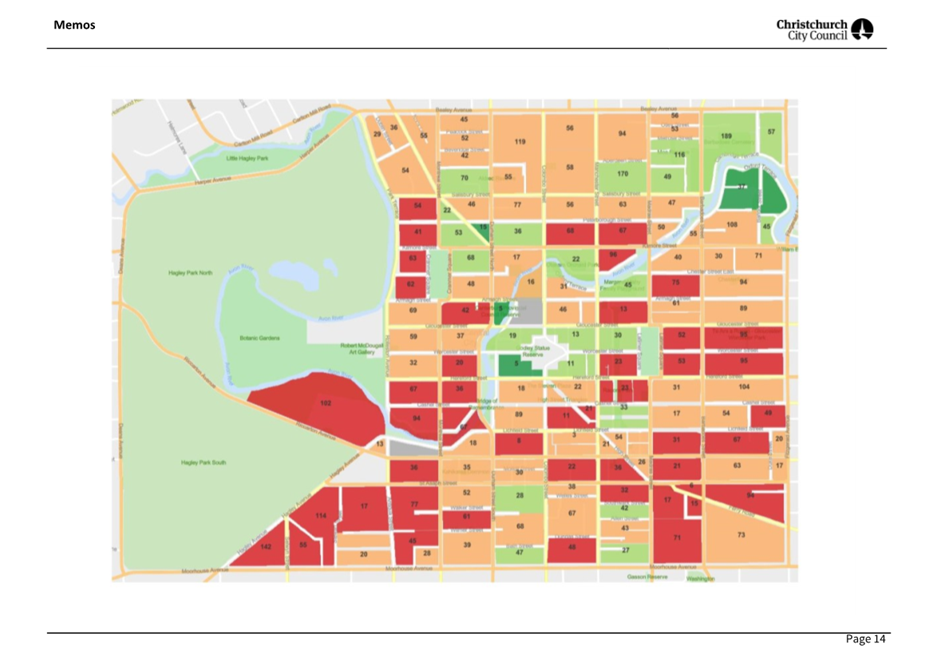

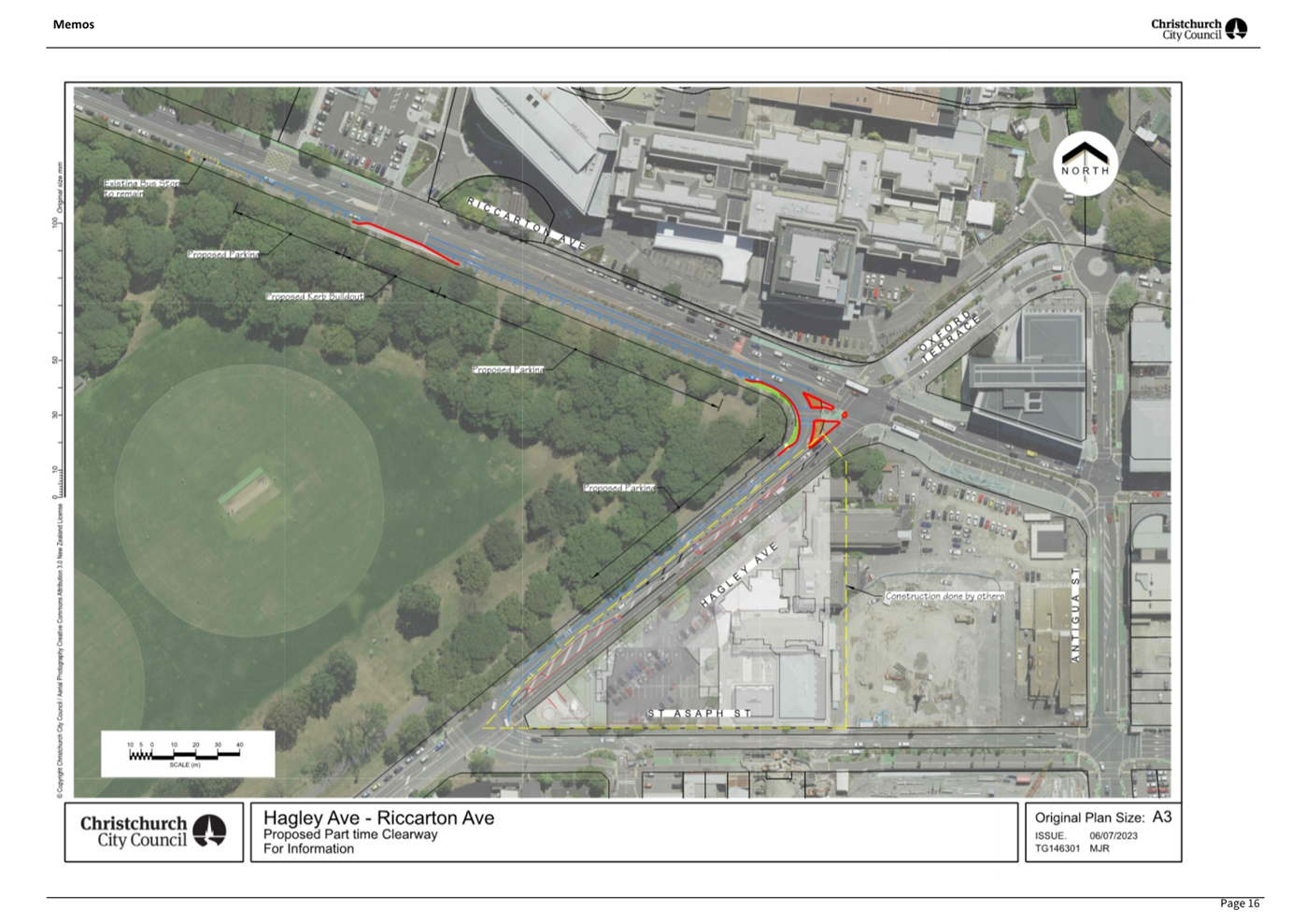
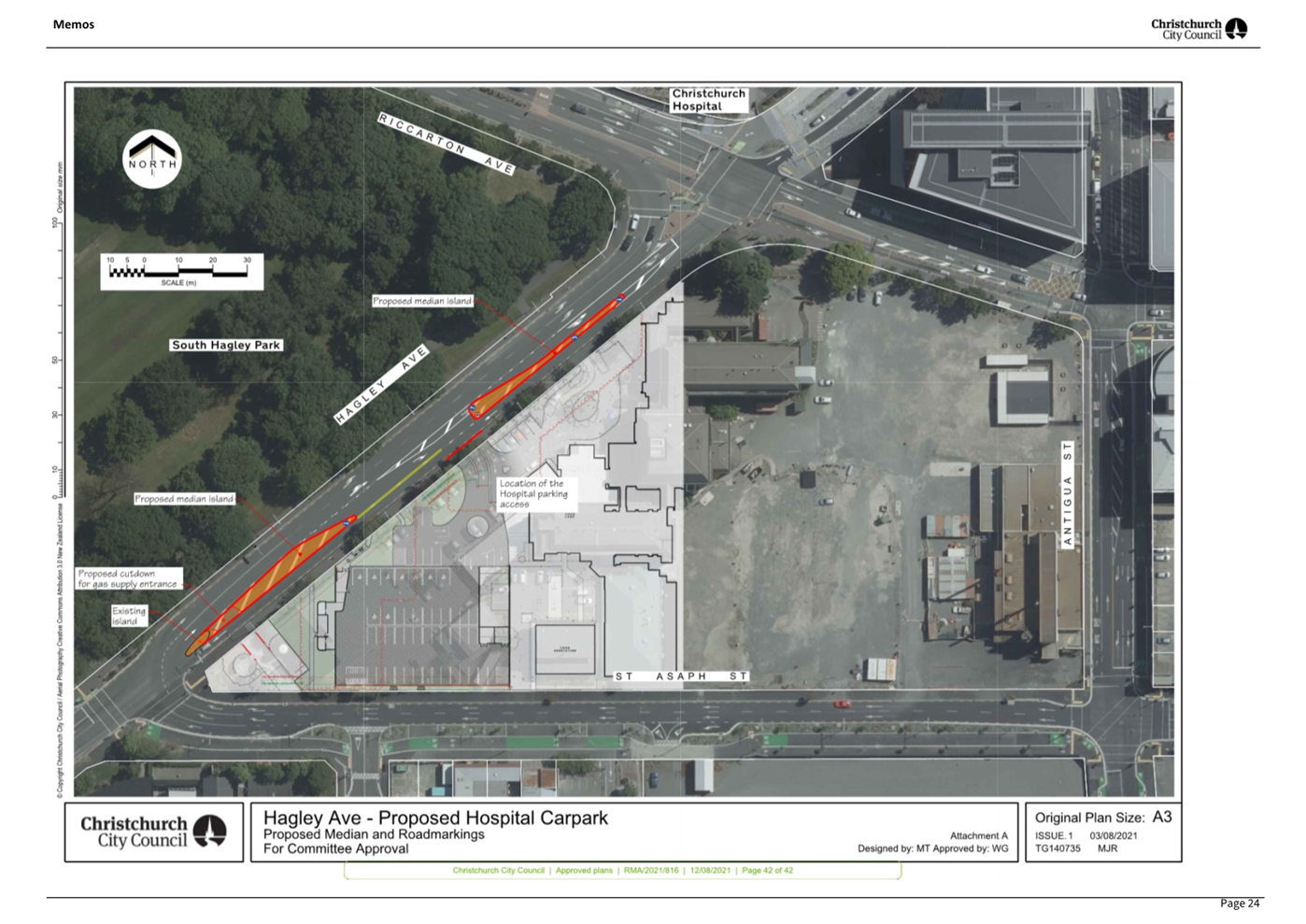
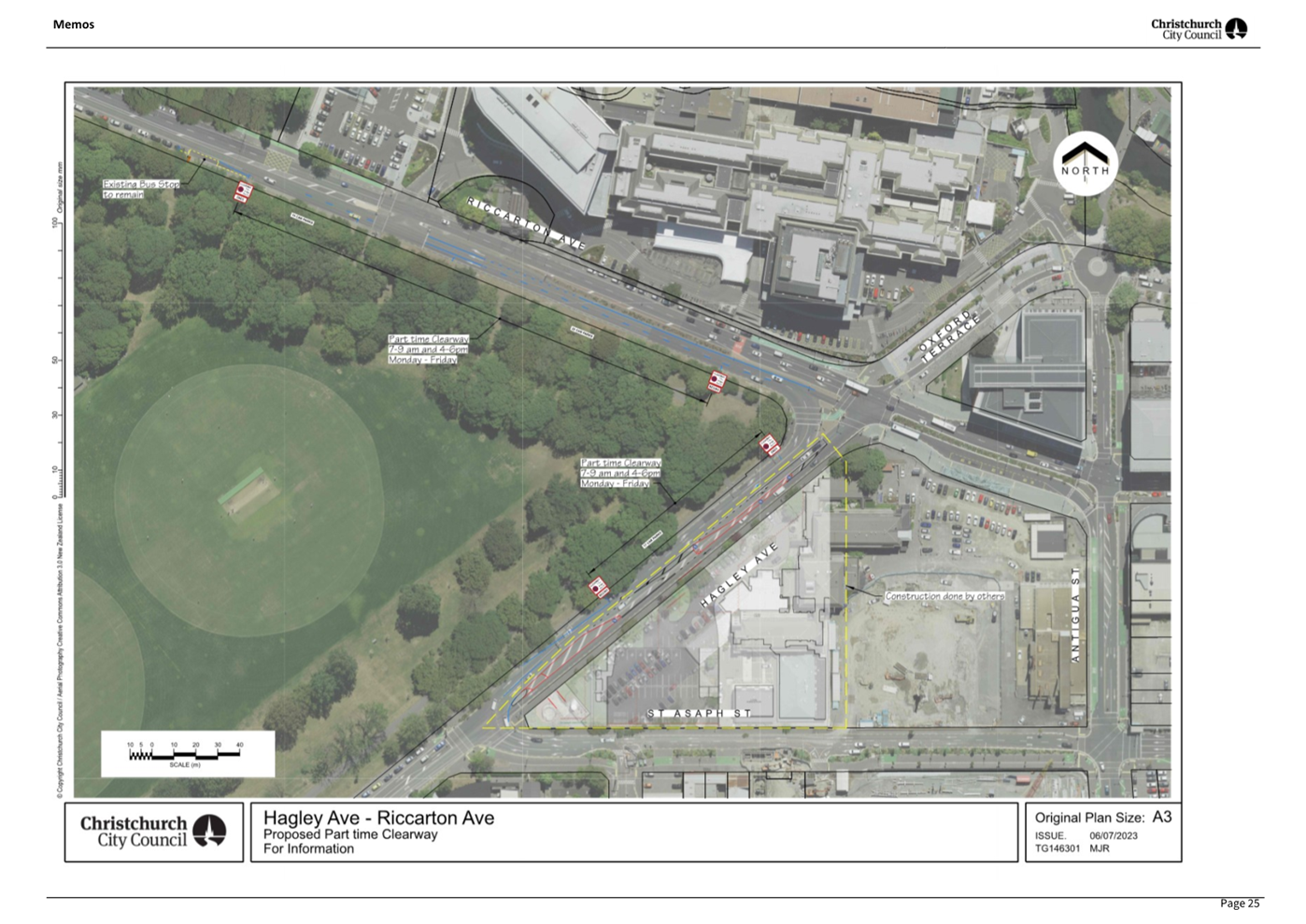
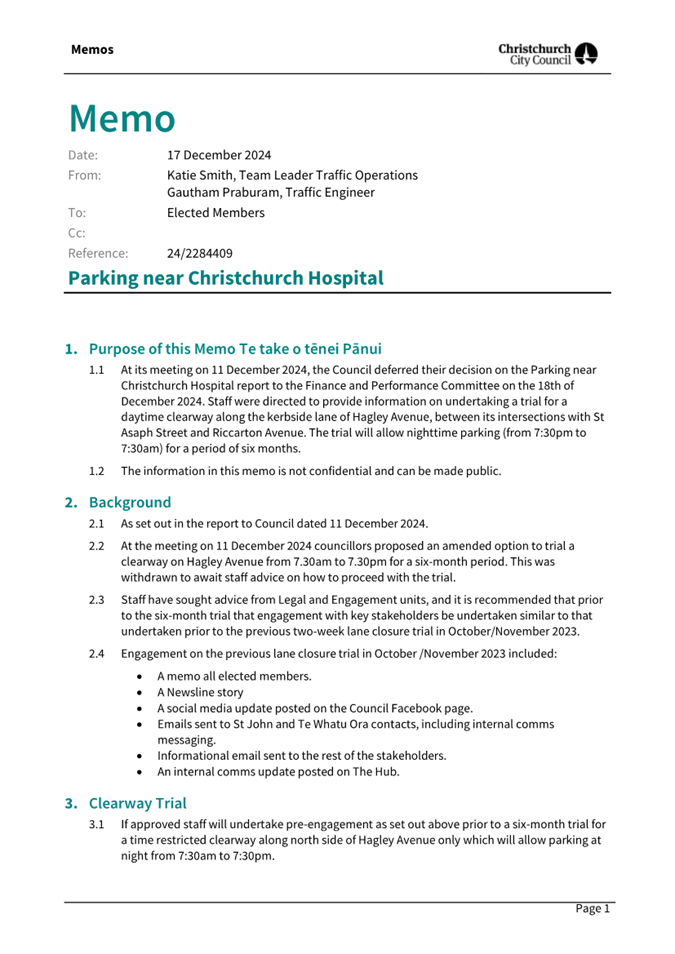
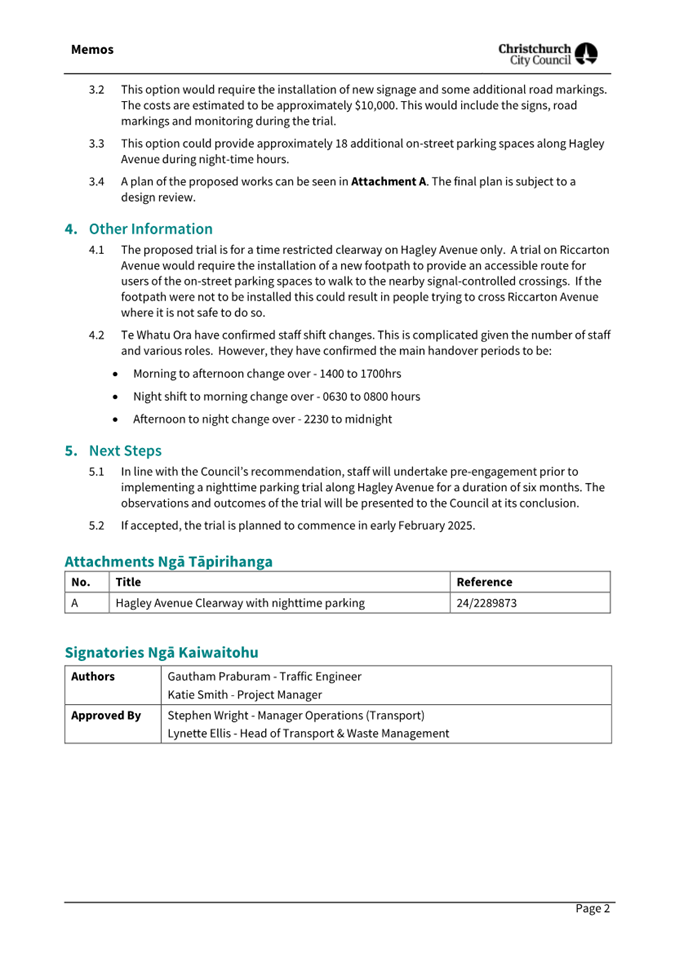
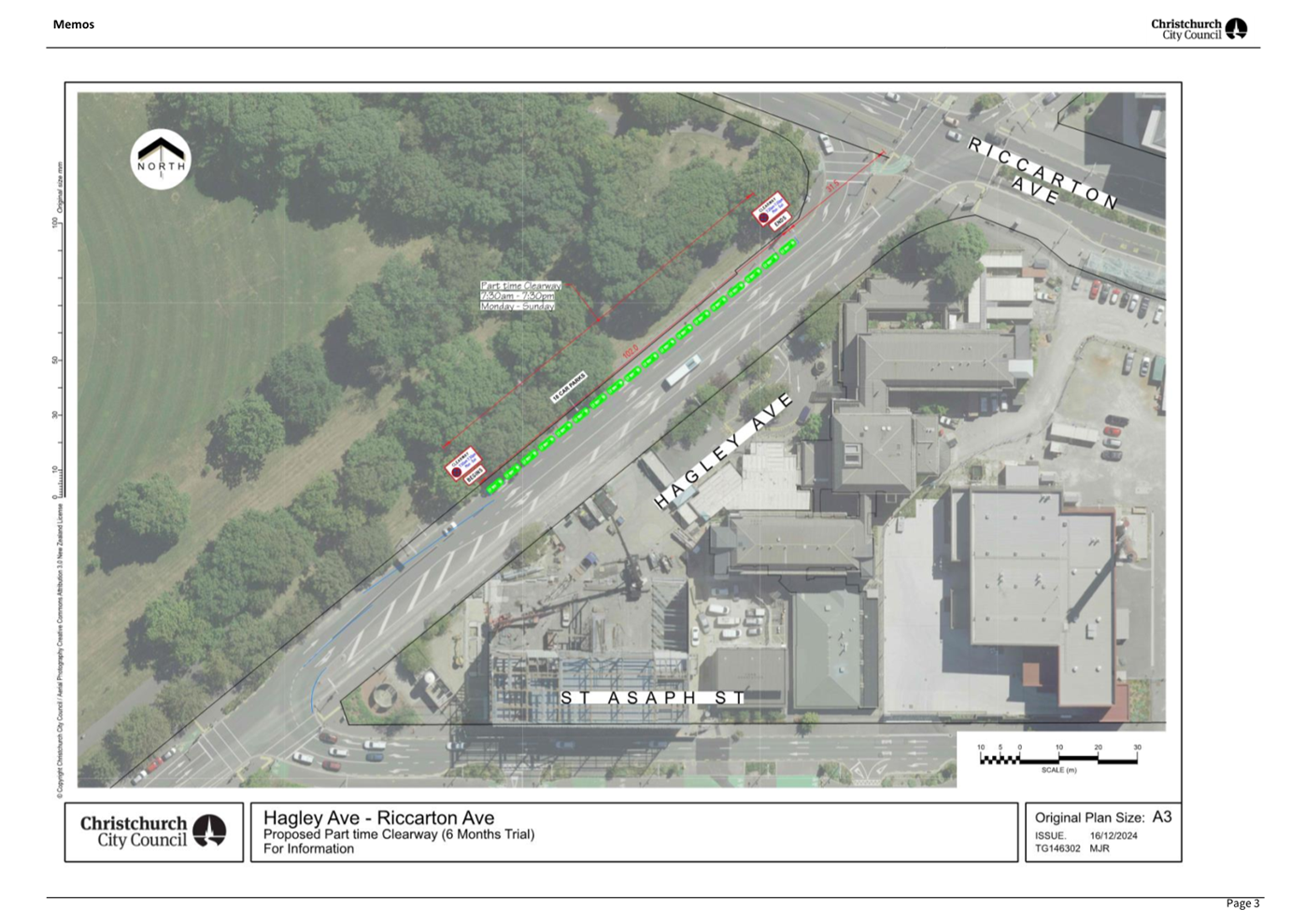
|
17. Resolution to Exclude the Public
|
Section
48, Local Government Official Information and Meetings Act 1987.
Note: The
grounds for exclusion are summarised in the following table. The full wording from
the Act can be found in section
6 or section
7, depending on the context.
I move that the public be excluded from the
following parts of the proceedings of this meeting, namely the items
listed overleaf.
Reason for passing this resolution: a good
reason to withhold exists under section 7.
Specific grounds under section 48(1) for
the passing of this resolution: Section 48(1)(a)
Note
Section 48(4) of the Local Government
Official Information and Meetings Act 1987 provides as follows:
“(4) Every resolution to exclude the
public shall be put at a time when the meeting is open to the public, and the
text of that resolution (or copies thereof):
(a) Shall
be available to any member of the public who is present; and
(b) Shall
form part of the minutes of the local authority.”
This resolution is made in reliance on
Section 48(1)(a) of the Local Government Official Information and Meetings Act
1987 and the particular interest or interests protected by Section 6 or Section
7 of that Act which would be prejudiced by the holding of the whole or relevant
part of the proceedings of the meeting in public are as follows:
|
ITEM NO.
|
GENERAL SUBJECT OF EACH MATTER TO BE CONSIDERED
|
SECTION
|
SUBCLAUSE AND REASON UNDER THE ACT
|
PLAIN ENGLISH REASON
|
Potential Release Review Date and
Conditions
|
|
24.
|
Electricity Procurement 2025 to 2030
|
|
|
|
|
|
|
Attachment a - Attachment A: RFP29963588
Electricity - MBIE Tranche 2024 - Procurement Plan
|
s7(2)(b)(ii), s7(2)(i)
|
Prejudice Commercial Position, Conduct Negotiations
|
The release of this information may impact on the suppliers and
Council's ability to negotiate.
|
2 July 2025
or on the Approval of the Head of Procurement.
|
|
|
Attachment b - Attachment B: Confidential
Price Analysis
|
s7(2)(b)(ii), s7(2)(i)
|
Prejudice Commercial Position, Conduct Negotiations
|
The release of the information may impact on the suppliers and
Coucnil's ability to negoitiate.
|
2 July 2025
or on the Approval of the Head of Procurement
|















